7.世界珍贵绵羊品种——宁夏滩羊(中英文)
一、引 言
宁夏滩羊是生存在中国西北干旱半荒漠地区的一个独特的绵羊品种,属粗毛型轻裘皮用羊。以盛产纤维细长、花穗美观、轻盈柔软、光泽悦目、颜色洁白的二毛裘皮驰名中外,为宁夏“五宝”之一,不仅在中国土特产品中占有特殊地位,而且在国内外毛皮市场上享有较高声誉。
中国现有宁夏滩羊近260万只,主要分布在东经105°~108°与北纬35°45′~39°40′之间,以宁夏回族自治区的中、北部为中心,并包括甘肃的景泰、靖远、会宁、环县与永登以东等地,陕西的靖边、定边以及内蒙古自治区的鄂托克前、后旗等29个县(市、旗),其中宁夏占58%,甘肃占33%,内蒙古和陕西分别占7%和2%。就整个范围看,是一个不大的地理空间,面积约6万平方公里。
宁夏回族自治区是滩羊的原产地,不仅数量占绝对优势,而且品质也最好。滩羊是宁夏草原放牧利用的主体畜种,也是宁夏畜牧业经济的支柱。因此,本文通过对宁夏滩羊品种的形成和发展,以及目前生产和利用状况总结和分析,揭示滩羊在宁夏回族自治区农业系统和社会经济发展中的作用,对确立宁夏滩羊今后的研究方向和资源开发利用提供主要科学依据。
二、宁夏滩羊品种起源与形成
(一)宁夏民族变迁的历史
宁夏位于中国西北,历来为各民族反复争夺之地。据历史文献记载,春秋时期为“羌戎”居地,后被匈奴所占,秦始皇统一六国后,逐匈奴北撤七百里,“徙(迁移)民充之”。公元400年初,匈奴族赫连勃勃建国名“夏”,随后统治了宁夏。唐末宋初,羌族一支——党项族以银川为中心建立“西夏”政权,统治194年后为蒙古族(元朝)所灭。蒙古人把西征时从中亚一带俘虏来的“色目人”。安之于宁夏;明朝时又把宁夏人移民长安(今西安),而迁五方人(其中以吴、楚人居多)来宁;清朝同治年间,又把陕西回民迁到宁夏。由此可见,民族变迁十分复杂。从滩羊的来源上考虑,影响较大者还是匈奴和蒙古人。现在宁夏民族虽回、汉居多,汉民来自内地“色目人”作为战俘强迫远涉而来,都不可能带来大批羊只。而今所知,其他地区也没有类似滩羊品种可供引入。而匈奴和蒙古人历史上都是“衣皮毛、事畜牧”的游牧民族。他们占据宁夏时,必然会带来大批羊只,并散落在占领地区。由于宁夏与内蒙古在地理位置上相接壤,四周都有蒙古羊分布,内蒙古牧民历来赶羊群到宁夏游牧,宁夏羊只也时常到内蒙古地区放牧。可见,在早年,宁夏实际上属于蒙古羊分布区。
另外,滩羊成年羊的外貌、体形和生活习性和蒙古羊虽有一定差别,但仍有许多类似之处。在滩羊和蒙古羊的过渡地带,各种性状也呈现明显的过渡特征。据此,可以认为:滩羊源于历史上分布在宁夏的蒙古羊,在当地自然条件下,经产区农牧民长期选育而从蒙古羊中分化出来。
(二)滩羊品种形成的时期
滩羊品种形成的确切时期,缺乏可考史料。公元1755年(清,乾隆二十年)编纂的《银川小志》记载:“宁夏各州,俱产羊皮,灵州(今灵武)出“长麦穗”。“长麦穗”可能就是今天的串子花穗(农牧民也称“麦穗花”)。公元1780年(乾隆四十五年)《宁夏府志》记载:“中卫、灵州、平罗,地近边,畜牧之利尤广”。物产富庶,除水稻、盐、中宁枸杞外,还有“香山之羊皮(今中卫香山)。民俗记有“衣布褐、冬羊裘”(即二毛裘皮来历)。
1908年(清,光绪三十四年)《甘肃新通志)记载:“裘”,宁夏特佳,而洪广(今贺兰县洪广营)之羊皮最胜,俗称“滩皮”。即滩羊名称是由“滩皮”而来。羊毛加工发展也很早,1728~1736年(清,雍正六年至乾隆元年)编的《甘肃通志》记有:“花毯,宁夏出者佳”,1908年《甘肃通志》又记载:“花毯,宁夏特佳”。花毯质量由“佳”到“特佳”,与加工工艺改进有关,也与羊毛品质提高有很大关系。羊毛品质改善与滩羊裘皮要求的特征二者产生的时期基本一致。因此,可以认为滩羊作为一个裘皮用品种,至少在1755年(清,乾隆时期)以前就已形成,距今有300多年。
(三)滩羊品种形成的原因
滩羊品种的形成是在自然选择与人工选择相互作用下,经过选择、适应、进化而逐渐形成的。其原因主要有以下几个方面。
1.有适于轻裘用羊发展的自然生态条件
滩羊原产地地处我国西北、宁夏中北部地区。贺兰山屏于西北,黄河纵流南北,草原平坦广阔,自然条件的特点是:①日照长、热量充沛,年日照时数2850~3150小时,>10℃的积温为2700~3400℃,年平均气温7~8℃。②降水量少,蒸发大,气候干燥。年降水量一般为180~300毫米,并集中在7~9月,年蒸发量1250~2550毫米。③牧草稀疏低矮,产草量低,而干物质中蛋白质含量较高。由于牧草生产季节间极不平衡,羊只要经受半年极端困难的枯草期。④由于当地降水少、蒸发大,水中富含碳酸盐、硫酸盐和氯化物,土壤盐渍化普遍,牧场有许多耐盐小半灌木,因此,硫、磷、钙等矿物质含量丰富。这些特点决定了特别适合饲养体格中等、粗毛较细,绒毛含量少,毛股结构较紧的脂尾型的羊只,这样的羊毛品质,易于形成整齐的弯曲而成为轻裘皮用类型。这是滩羊能在宁夏形成的客观条件。
2.农牧民长期精心选育
宁夏自古以来养羊相当发达,《大明一统志》记载:“宁夏土人善畜牧”,“以耕猎为事,孳畜为生”。当地冬季寒冷,客观上要求人们对裘皮质量的选择给予重视,产区农牧民有着极其丰富的选育和繁殖羊只经验,这是滩羊品种能形成的社会条件和技术条件。
3.社会需要是滩羊品种形成的动力
人们在客观上需求美丽的花毯和优质的裘皮,这就促使制造商对原料提出质量要求,这种要求通过市场价格来体现,从而促进了滩羊品种的形成。如在清朝康熙年间,山西省交城县皮毛商人就来宁夏收购滩羊二毛皮,采用订合同、包销包产、先付钱后交货等方式,从而大大促进了品种育成过程。
(四)滩羊品种扩群的方式
自从“洪广营”的“滩皮”出名之后,各地都以洪广裘皮相比论优劣。为了提高自己的羊群质量,农牧民通过亲戚关系和交叉放牧机会串换种羊,滩羊就这样逐步扩大发展。
三、宁夏滩羊品种特征与生产性能
滩羊品种形成时间长,性状遗传十分稳定。当近交系数在0.125以下时,不表现衰退现象(崔重九、许万善,1981)。对175只种公羊和6945只羔羊的7项主要经济性状的遗传力估测,结果为,初生羔羊:体重h2=0.24±0.11,自然毛长(肩部)h2=0.18±0.09,伸直毛长度(肩部)h2=0.37,毛弯曲数(肩部)h2=0.20±0.08;二毛期羔羊(30日龄):体重h2=0.25±0.05,毛弯曲数h2=0.18±0.07,优良花穗分布面积h2=0.10。
(一)滩羊外貌特征
1.成年羊
滩羊体型外貌与蒙古羊相似,体格中等,体长略大于体高,呈长方形。体质结实,具有较强的耐艰苦、耐干旱、耐寒热、抗病力强和适应四季饲料(草)供应极不平衡的能力。体躯毛色纯白,多数头部有黑、褐、黄色斑块。被毛分内外两层,外层由少量有髓粗毛和两型毛(中间型)组成,内层为无髓毛,毛股结构明显,有大的波浪弯曲,毛股自然长度10~18厘米。无干死毛,前后躯表现一致。
滩羊的体尺存在着地区差异,总的来说,干草原地区较大而结实,荒漠草原区体格较小,而个体间变化较大,主要是由于天然草地植被差异(营养条件)所致(表l)。
2.羔 羊
其外貌与蒙古羊特征迥然不同,更不同于其他绵羊品种的羔羊。初生时体重3.5~5公斤,相当于成年母羊体重的8%~9%,多毛性极强,长着4.5~5.5厘米长的毛股,整个毛股上均匀分布着4~7个波浪形弯曲,毛色洁白如玉。初生时,体高大于体长。到一月龄左右,毛股长达7~8厘米(即二毛裘皮),体高与体长几乎相等,呈方形或长方形(表2)。
不同生态区域成年滩羊体尺
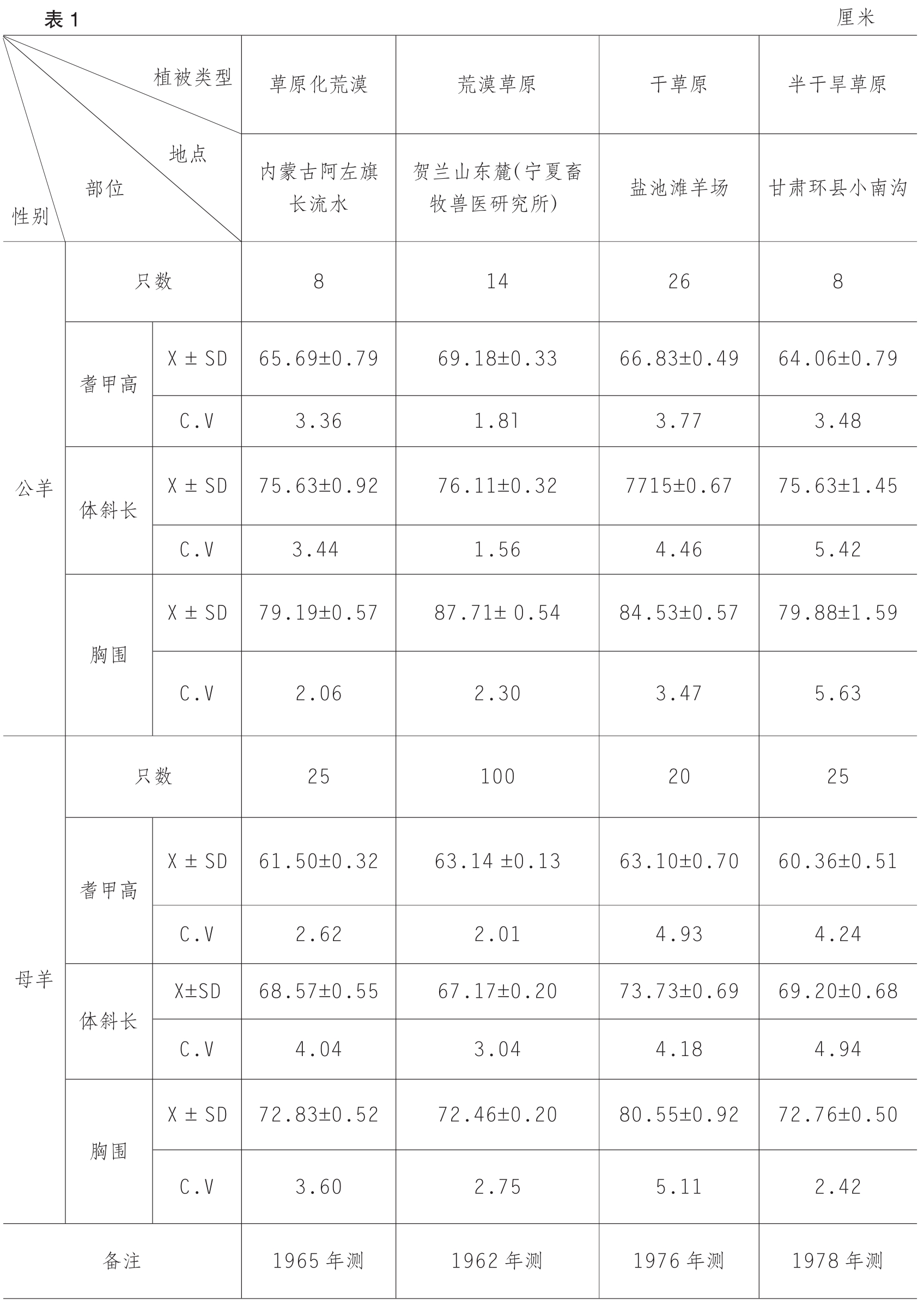
表2 羔羊体尺与体重
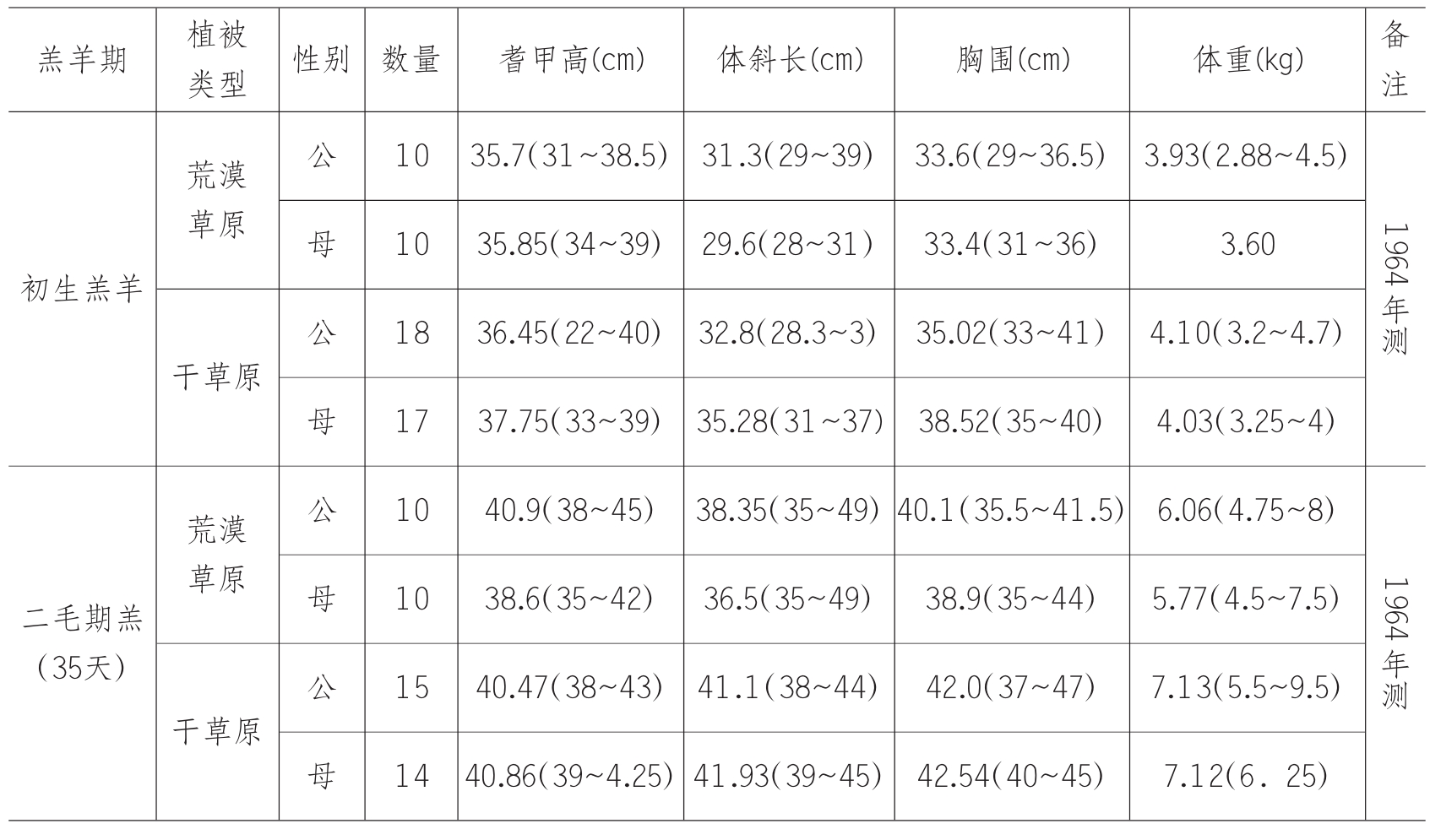
(二)滩羊生产性能
滩羊生产性能具有兼用特征,以生产二毛裘皮为主,同时可以产毛、产肉和板皮,满足销售者多方面的需要。
1.皮性能
滩羊二毛裘皮即为出生后30天左右宰杀剥取的羔皮,其特点是:①毛股长而紧实(8.0厘米以上),具有美丽的波浪形弯曲(6~8个弯曲);②毛纤维较细而柔软,两型毛和无髓毛比例适当(46.0%和54.0%),羊毛密度2312.15~2480.1根/平方厘米,花穗不松散、不毡结;③毛色洁白,光泽悦目;④皮薄而致密(皮肤厚0.78毫米),重量轻而结实,皮板面积2254(1220~3480)平方厘米。鞣制后重量0.35公斤/张。
2.产毛性能
滩羊毛洁白,富有光泽,毛纤维细而长,具有自然的波浪弯曲,无干死毛,易染色,且标光感极强,是世界上独一无二的毛纤维类型。滩羊成年毛密度为1771根/平方米,有髓粗毛44.87±10.18微米,伸直长度9.5~10.7厘米,占7.0%;两型毛(中间型)33.13±8.62微米,长度14.3~18.3厘米,占15.22%;无髓毛19.07±5.85微米,长度9.8~12.3厘米,占77.78%。净毛率为65.38%,油脂率7.22%。
不同地区羊毛品质和剪毛量略有差异,荒漠草原羊毛较干草原羊毛细,但剪毛量稍低(表3)。
宁夏滩羊剪毛量
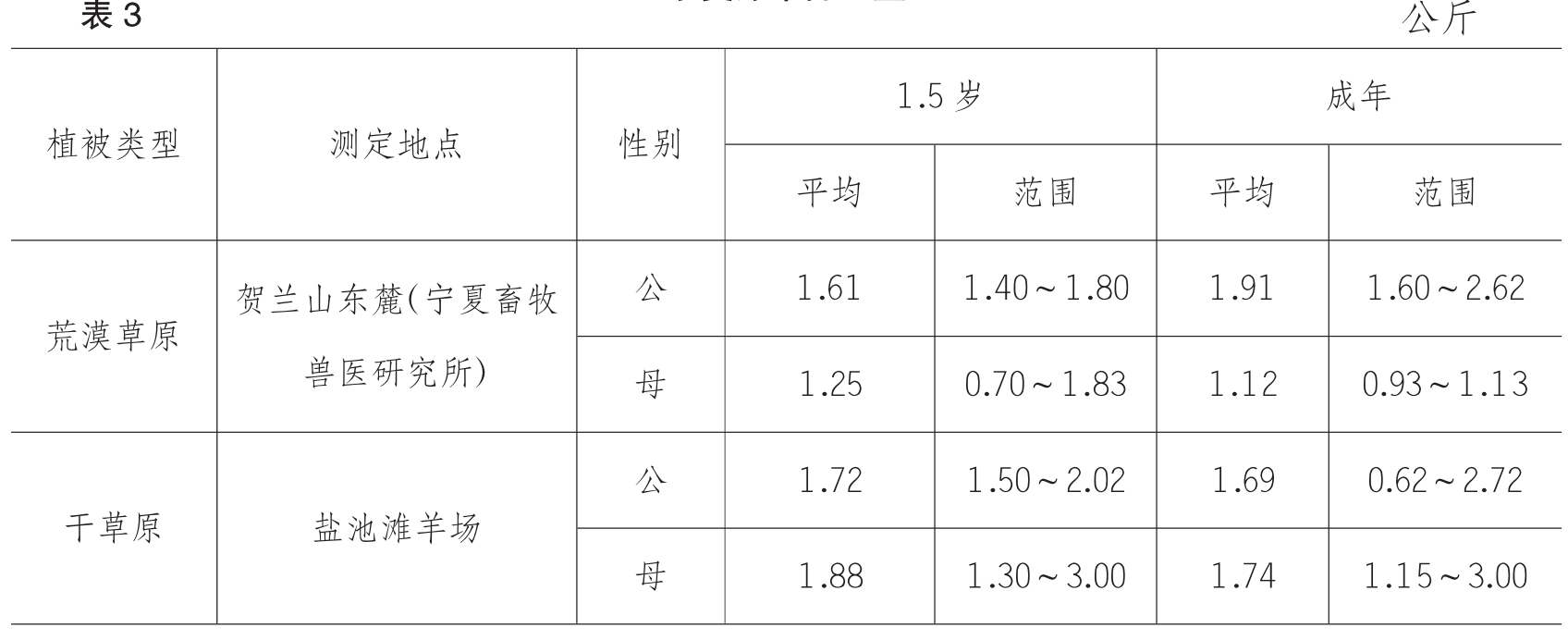
3.产肉性能
在完全依靠天然草场放牧条件下,滩羊体重发育较晚熟,一岁体重仅为五岁的46.57%,二岁体重为63.27%,三岁体重为85.14%,四岁体重为91.6%,屠宰率较低(表4)。
滩羊具有较强的放牧育肥性能,可利用夏秋牧草丰茂季节迅速增加体重,并囤积大量脂肪。在补饲条件下有较大的增重潜力,当年羔羊育肥日增重达100.75克(杨生龙,1979)和180.0克(尹长安、黄学双,1985),四岁羊(去势)育肥日增重达80.5~112.0克(赵志斌,l982)。
滩羊肉质细嫩,肉脂混生,无腥膻味,在粗毛羊中肉质最好。滩羊肉名菜(丁超,1992),如手抓羊肉、腊羊肉、黄焖羔羊肉、烩羊杂碎(肺、心、肝、肠、肚混烩)等历史悠久,香气飘逸、味美可口。所以,滩羊肉在国内市场很畅销。
4.繁殖性能
(1)母羊:滩母羊出生后8~9个月龄达到性成熟,18月龄可配种繁殖。繁殖利用年限一般为6年。每年7月份开始发情,8~9月为发情旺季,妊娠期149~152天。受胎率达98%,产羔期从12月开始至翌年3月,其中1月份较集中,占产羔总数的36.3%,双羔率3%,羔羊成活率85%以上。如在饲养条件较好时,可
滩羊产肉性能
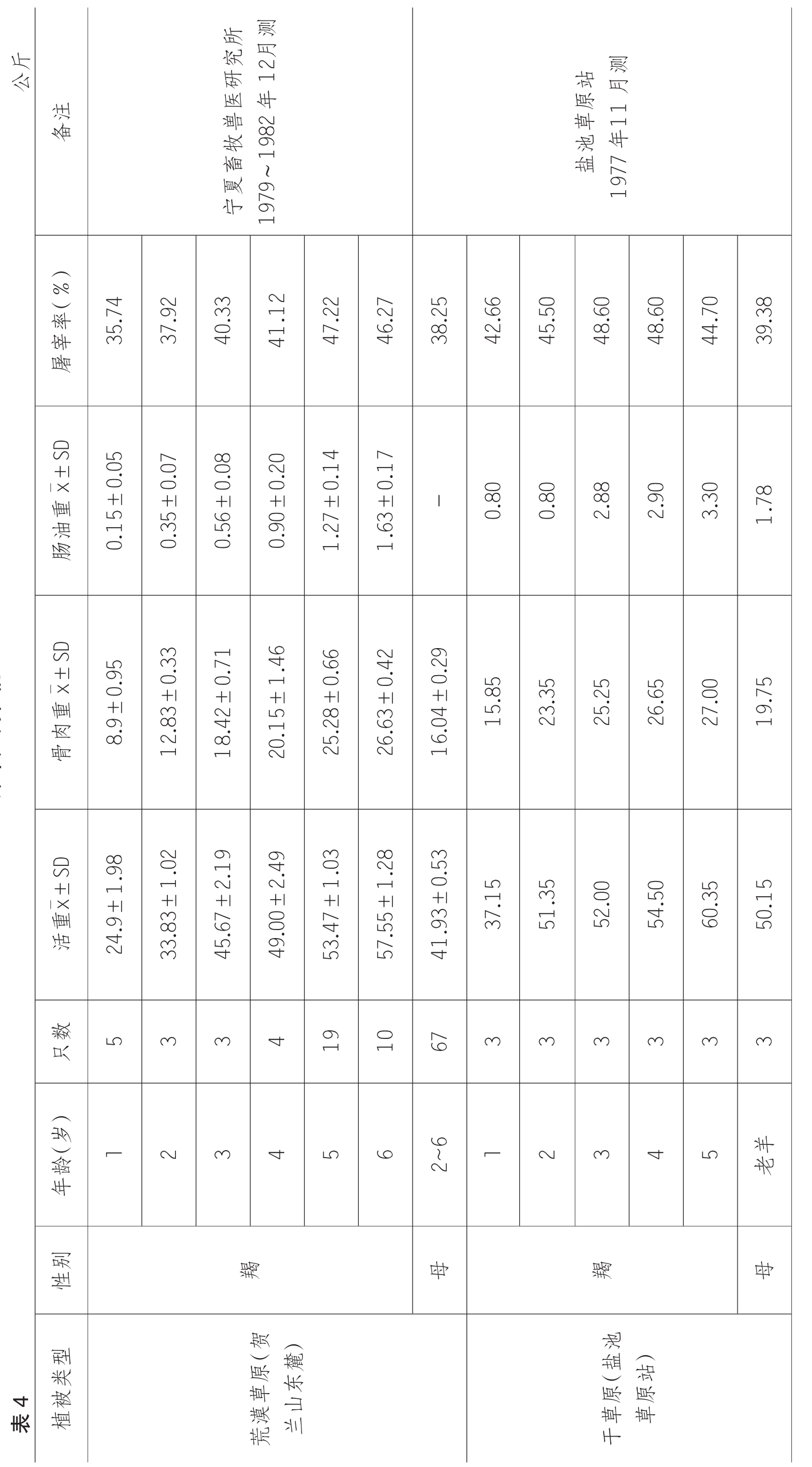
推行“两年三产羔”技术(许百善,1986)。(2)公羊:性成熟为7~8个月龄,一般2岁开始利用,利用期为4年。除较集中的牧场进行人工授精,大部分农牧民采用1∶10的公母比例混群饲养。种公羊一次排精量1~1.5毫升,精子密度为15亿~22亿/毫升,平均活力0.8(宁夏滩羊科技资料,第一卷,薛忠义,1978)。
5.滩羊的产奶性能
滩羊产奶量受年龄、胎次、产羔季节及妊娠后期、哺乳期饲养水平等多方面影响。不同年龄母羊泌乳期(1~6月中下旬产奶总量大约为:2岁21.74公斤,3岁57.98公斤,4岁55.96公斤,5岁为25.66公斤,6岁11.16公斤)(杨生龙,1983)。
四、宁夏滩羊产区农业系统与滩羊数量分布
(一)宁夏农业生产体系
宁夏回族自治区土地总面积51800平方公里,农耕地面积175.89万公顷,林地36.29万公顷,森林覆盖率4.85%,可利用草原面积260.55万公顷。宁夏滩羊优良产区包括银南、银川石嘴山(中北部)3个地区14个县(市),总土地面积35017平方公里,可利用草原面积203.16万公顷,占总面积的77.9%。现有农业人口42.58万户,190.6万人,其中回民63.04万人,占32.16%。该地区是宁夏引黄灌溉区,可灌溉面积36万公顷,农业生产较为发达。种植业主要盛产小麦、水稻、玉米、蔬菜和瓜果(西瓜、枸杞和苹果等)。春小麦套种玉米平均产量达5050公斤/公顷和5895公斤/公顷,水稻(单季)平均产量9000公斤/公顷。瓜甜果香、质量优良。农业总产值23.5亿人民币。其中,种植业16.3亿元,占69.39%;林业总产值7662.96万元,占3.26%;牧业5.38亿元,占22.89%;水产6340.63万元,占2.69%;其他4138.0万元,占l.76%。
(二)宁夏滩羊数量分布
宁夏滩羊资源总量分布范围包括甘肃、内蒙和陕西,分布于四省(区)29个县(旗、市)。宁夏是滩羊的原产地,数量占总量的58%,质量也最好。宁夏滩羊产区主要集中在中北部地区(表5),并集中在两大生态区,即以贺兰山带为主体的荒漠草原,约占47.34%和黄河以东鄂尔多斯高原(过渡带)干旱草原区,约占总数的52.66%。饲养量大于年末存栏数的40%~67%(图1、图2),95%以上的羊只分散在农牧户放牧饲养,公有产权羊约占3%。
宁夏滩羊产区滩羊分布情况

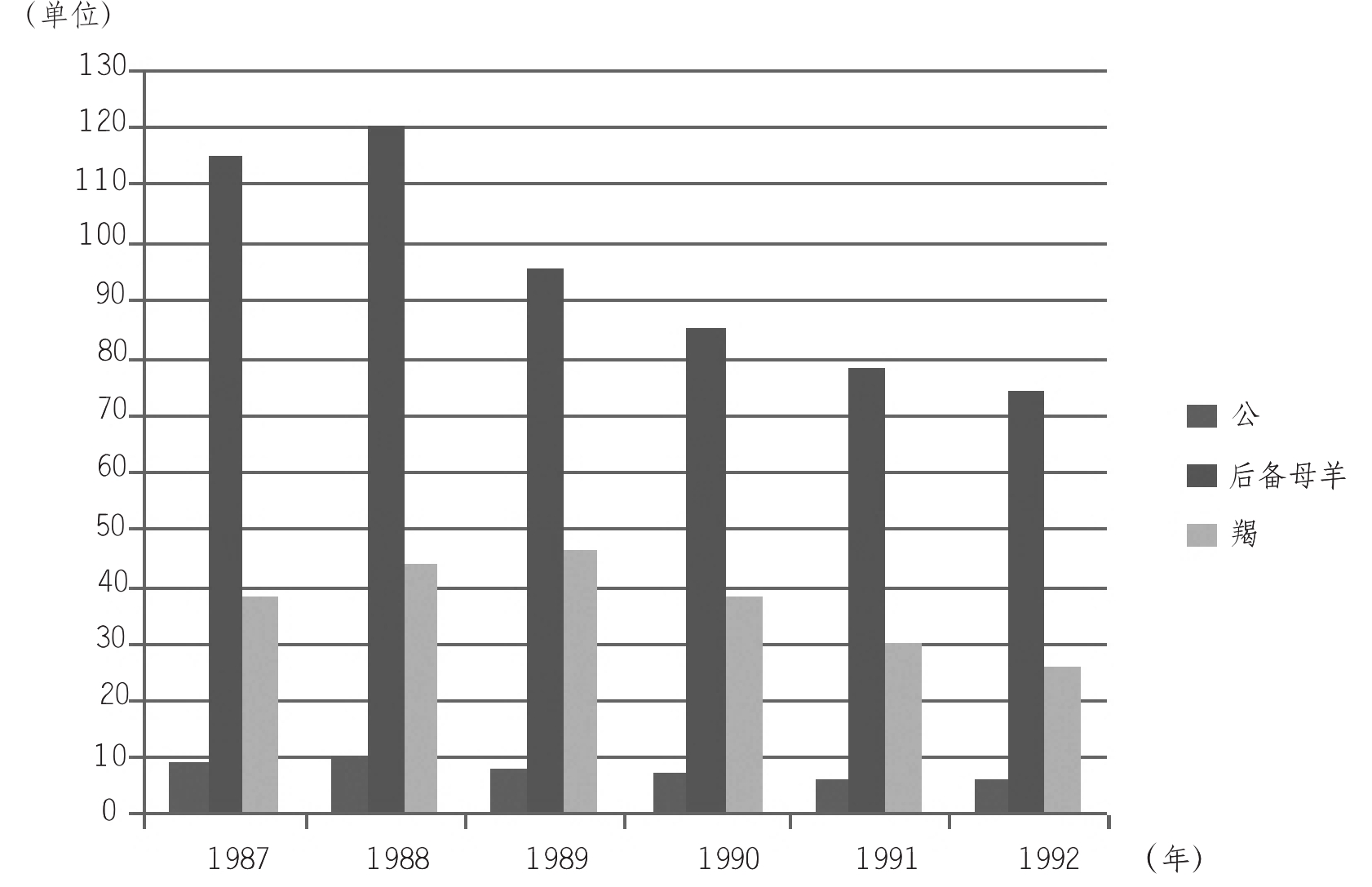
图1 滩羊饲养量与年末存栏数变化(1987~1992)
五、宁夏滩羊生产
宁夏地处我国西北内陆风沙干旱区,草原生态环境脆弱而极不稳定,降水是影响滩羊草原放牧生产的最主要因子,由于降水呈明显的季节性变化,滩羊生产也具有很强的季节性,滩羊体况也呈明显的季节特点,即夏壮、秋肥、冬瘦、春乏。
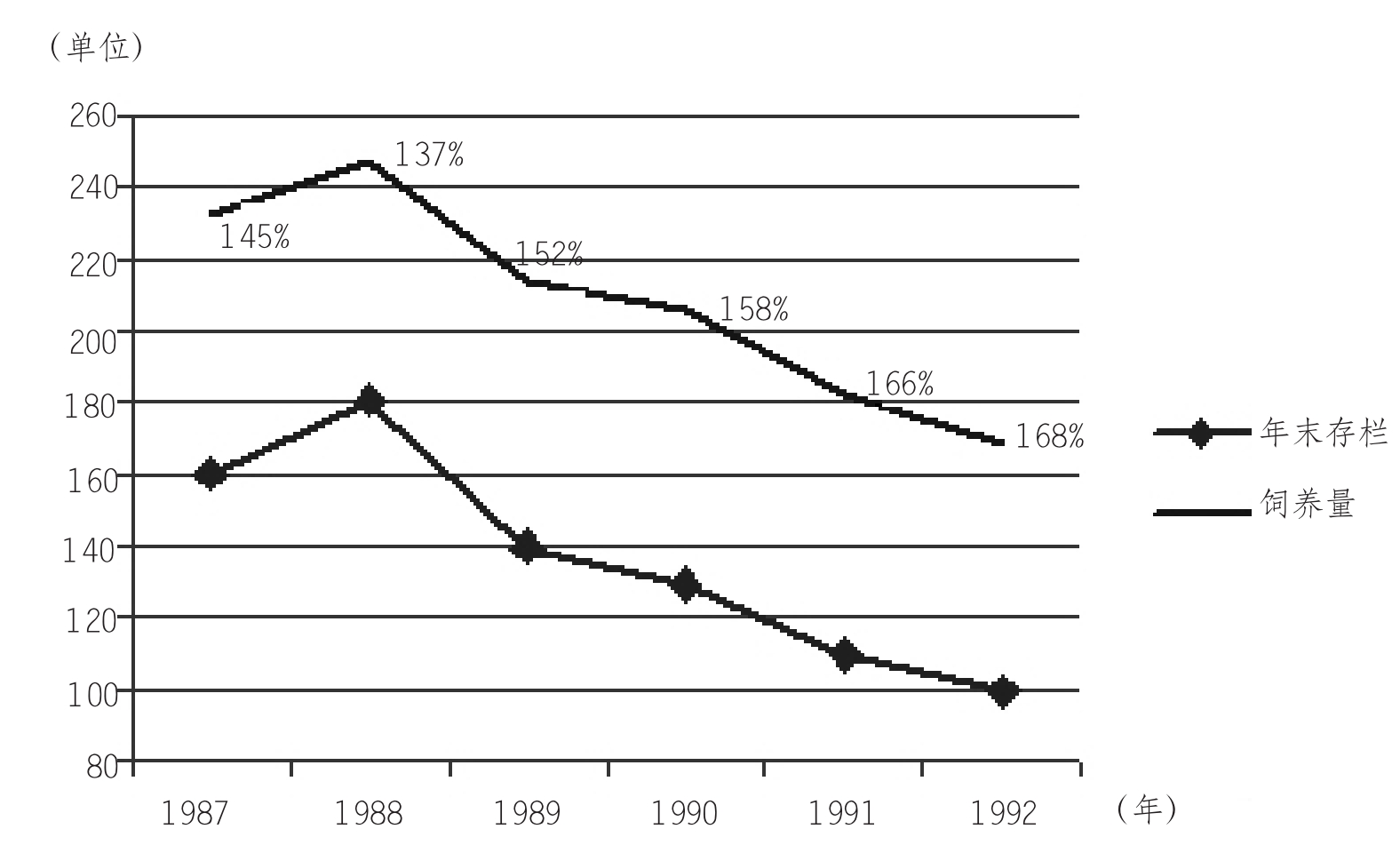
图2 滩羊年末存栏数与组成结构变化(1987~1992)
表6 宁夏天然草场类型面积及载畜能力
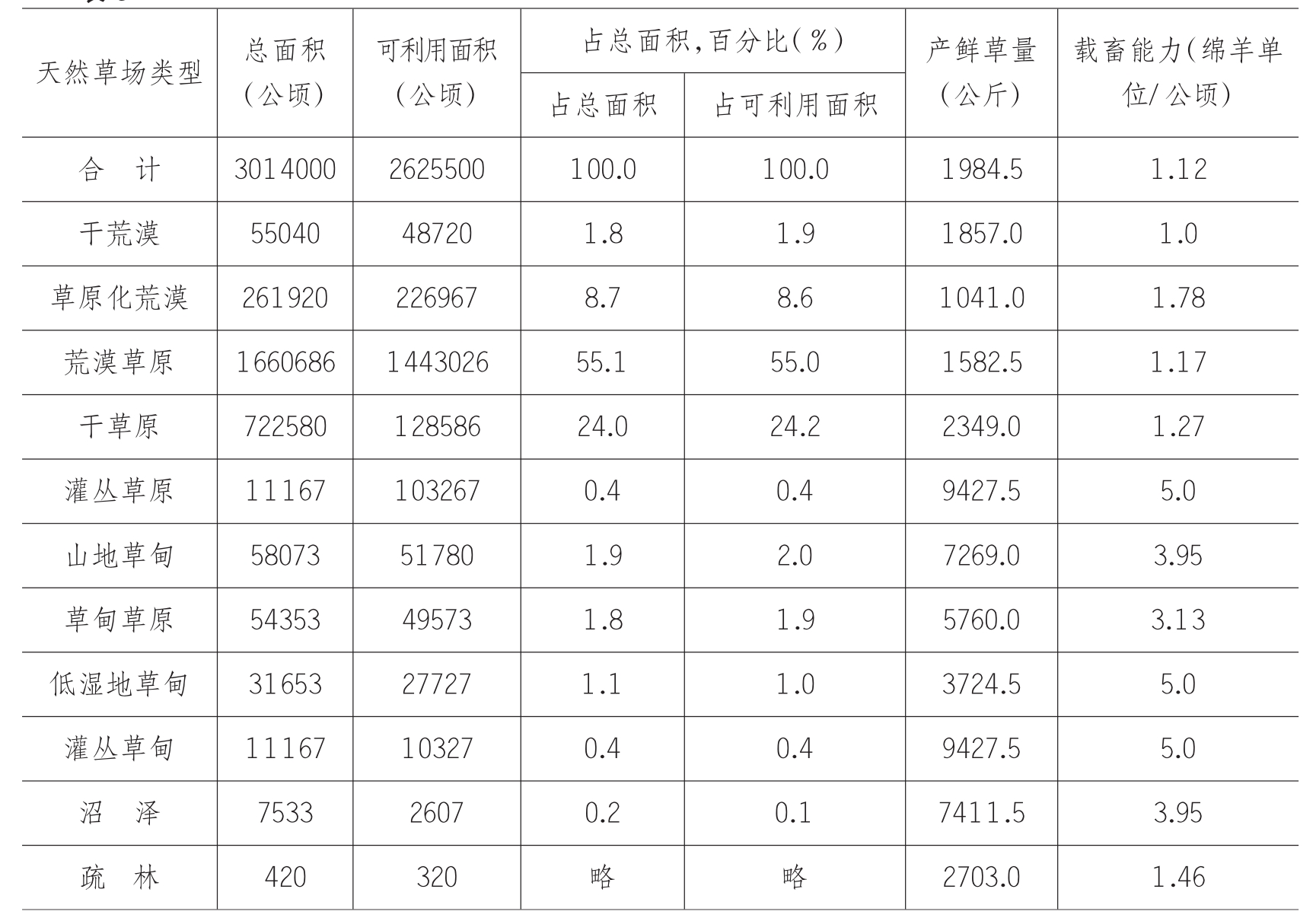
(一)草原生产力状况
宁夏回族自治区现有天然草原总面积301.4万公顷,占宁夏总土地面积58.2%,其中可利用面积262.55万公顷,总载牧能力为294.1万个绵羊单位。从南向北,气候由半湿润向半干旱、干旱到半荒漠过渡,植被也呈明显的过渡特征,共分11个类型(表6)。以荒漠草原和干旱草原面积最大,占总面积的79.19%,也是宁夏滩羊的主要放牧草地。草地产草量受气候和降水因素的制约,年际间变化很大。
沿贺兰山带荒漠草原区主要植物有戈壁针茅(Stipa gobica)、沙生针茅(S.glareosa)、红砂(Reaumuria soongorica)、骆驼蓬(Peganum harmala)、刺旋花(Convolvulus tragacanthoides)、白刺(Nitraria sibirica)、碱蓬(Suaeda salsa)、蓍状亚菊(Ajania achilloides)、刺叶柄棘豆(Oxytropis aciphylla)、柠条锦鸡儿(Caraganakorshiskii)、珍珠(Salsolapusserina)、霸王(Zygophyllum xanthoxylom)、白沙蒿(Ariemisia sphaerocephala)、黄蒿(Artemisia annua)、银灰旋花(Convolvulus ammannii)、糙隐子草(Cleistogenes squarrosa)等。
干旱草原区主要植物有本氏针茅(S.bungeana)、短花针茅(S.breviflora)、茭蒿(A .giraldii)、冷蒿(Artemisia frigida)、小叶锦鸡儿(Caragana micraphylla)、甘草(Glycyrrhiza uralensis)、达乌里胡枝子(Lespedeza davurica)、阿尔秦狗哇花(Heteropappus altaicus)、硬质早熟禾(Poa sphondylodes)、骆驼蒿(Peganum harmala)、牛心朴子(Cynanchum komarovii)、苦豆子(Sophora alopecuroides)、细叶韭(Allium tenuissimum)、黑水亚麻(Linum amurense)等。
(二)羊群结构
宁夏滩羊总体结构如图2所示。羊群由公羊、繁殖母羊、后备母羊和羯羊组成,其比例(表7)。
羊群的大小视地区、草原情况及放牧技术而定,耕作区群小而放牧区则群大。在灌溉耕作区一般为50~200只/群,而在牧区为100~400只/群不等。农牧民羊群结构与规模见下例(图5)。
宁夏滩羊群体结构
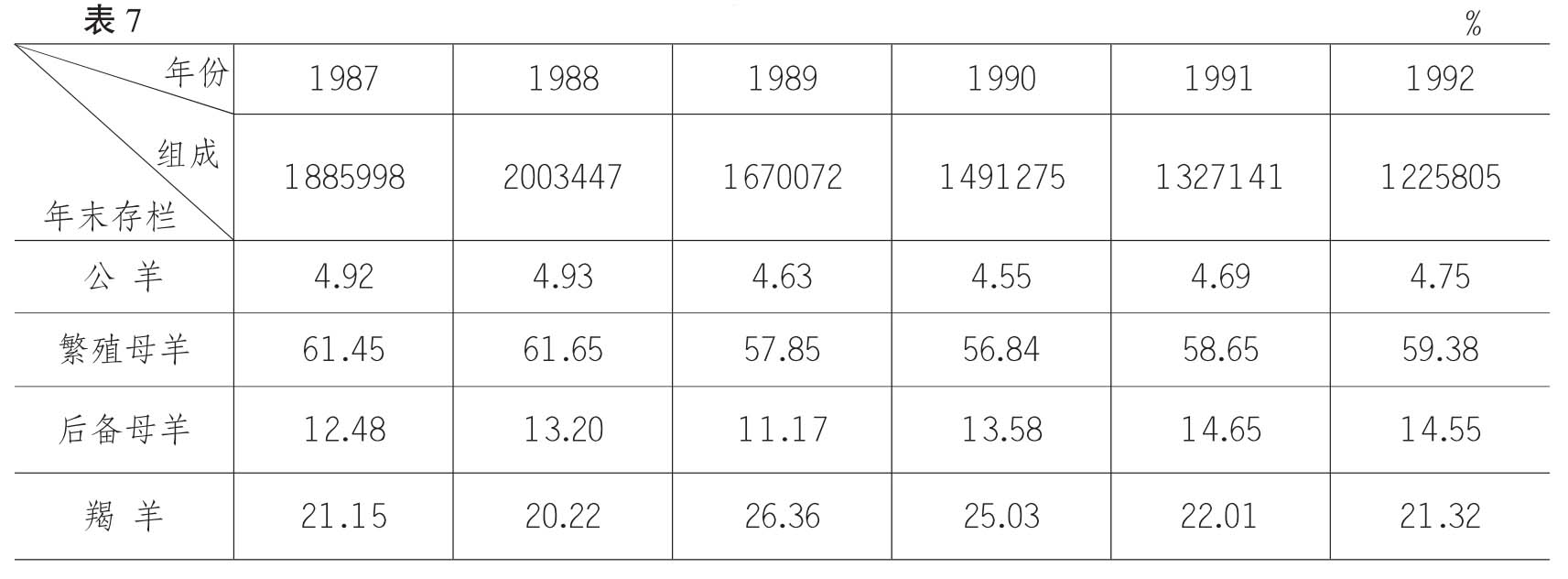

图3 盐池徐广滩(376只/群)
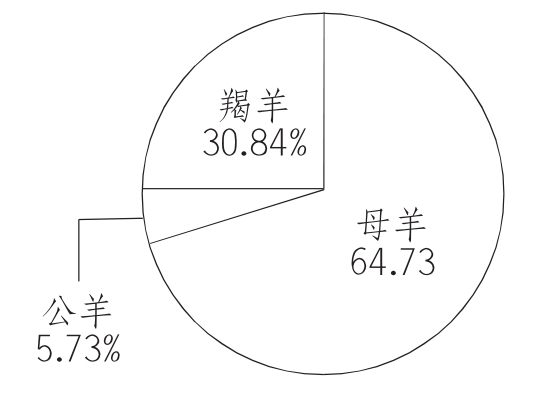
图4 灵武石家壕(227只/群)
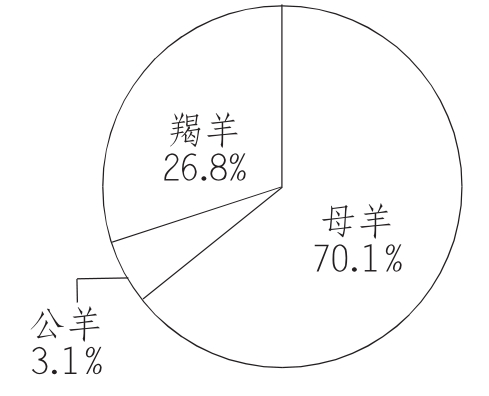
图5 吴忠马家滩(97只/群)
(三)滩羊放牧与饲养管理
滩羊长期在严酷的自然条件下生存,终年在外放牧,忍受干旱、酷暑、风沙和寒冷。在大牧场或农场,公羊与羯羊、1.5岁以上繁殖母羊和1.5岁以下公母羊分别组群放牧,而农牧户通常混群放牧。每天日出时出圈,日落归牧,哺乳羔羊单独饲养管理,不随群放牧。据测定,放牧时羊群行进速度平均为24.51米/分(李芬、辛纲,1959)。
在宁夏中北部荒漠草原和干旱草原区,降水量的丰缺对草原生产力影响极大。正常年分,5月中、下旬至11月为滩羊增膘期,11月体重最大,成年公羊和羯羊活重平均达44.5公斤/只,母羊36.2公斤/只。12月开始,气候转冷,进入冬季枯草期,五月初体重最小,可减少25%~30%,鉴于这种变化,每年入冬时,将部分老年羊短期肥育淘汰。如遇特干旱年份(1~7月不降水),对滩羊当年发情、配种、繁殖与羔羊质量影响很大,入冬淘汰率则更高,达30%以上。
冬、春季,归牧后对产羔母羊和哺乳羔羊进行补饲(以玉米为主),补饲量分别为250克/日和50克/日。春乏期,对少量瘦弱的1岁母羊也给予适当补饲。其他羊只不补饲,除非在特干旱年份。
在农业灌溉区,农户养羊数量较少,多采用集中雇人在山上代牧的方式,秋末,把羊接回舍饲过冬。另外,还有专门从事肥育出售肉羊的专业户,一般出栏规模为500~1200只/年。
总之,宁夏滩羊放牧管理方式和何养水平还十分落后,今后,应不断地改进饲养条件和提高管理水平。
(四)滩羊健康问题
宁夏滩羊体质结实,抗逆性强,夏、秋、冬季发病率低,春季由于营养水平过差,抵抗力降低,发病率上升,羊只死亡主要在这一时期,死亡率一般在3%~5%。
急性传染病如绵羊痘(Sheep pax),羊棱病菌(Clostridial disease of sheep)曾在宁夏局部出现过,但未造成大范围流行。20世纪70年代后,宁夏推行了“传染病免疫技术规程”和综合防止措施,有效地控制了羊传染病的发生,受到国家农业部和卫生部的表彰。
目前滩羊常见病和多发病主要有以下几种。
1.羔羊痢病(Lamb dysentery)
该病主要危害7日龄以内的羔羊,以剧烈腹泻和小肠溃疡为特征,引起羔羊大量死亡。据调查:1987~1989年,3年发病10472只,死亡2252只,致死率21.5%。本病的发生与品种有关,滩羊发病率较新疆细毛羊和其他杂种羊低。采用普通抗生素和羔羊痢菌苗(血清),并对羔羊加强管理及清洁圈舍,就可有效防止,目前能完全控制此病。
2.绵羊肺炎霉形体病(Pneumonic mycoplasmosis of sheep)
1981年在同心首次发现病例,1982年分离出菌株(谢守栋、赵玉琪)。1987~1989年在全区范围内抽样调查195群羊,平均感染率21.28%。绵羊感染率高于山羊,致死率55.1%。本病用盐酸土霉素加磺胺增效剂治疗,用3%来苏儿和10%石灰水消毒圈舍可有效预防。
3.羊破伤风(Sheep tetanus)
本病主要是在接羔、断脐、剪毛致伤、去势、断角时消毒不严,伤口感染而发病。发病率不高,但致死率很高。自1948~1989年的40年间,累积发病223847只,死亡64660只。只要严格消毒或注射破伤风毒素即可有效防止。
4.羊脑多头蚴病(又称“羊包虫病”,Coenurosis cerebralis avis)
本病零星散发,发病率与农村养狗数量呈正相关(狗为中间宿主),发病率l%~3%,口服丙硫苯咪唑有较好的治疗效果。
5.羊螨病(Sarcoptes ovis)
本病是由蚧螨、痒螨寄生在羊体表引起的慢性皮肤病。对山羊危害较绵羊重。从1955~1981年,此病累积死亡羊数76802只,其中山羊占70%以上。治疗螨病药物较多,其中以螨净效果最好,用250毫克/公斤药浴、600毫克/公斤喷浴或涂擦即可,目前已普遍在生产中应用。
6.羊鼻蝇幼虫病(Oestrosis nasus avis)
由羊鼻蝇幼虫寄生在羊鼻腔和腔窦引起的慢性鼻炎。据调查:从1948~1988年的40年间累积发病羊数1585541只,死亡52072只,占总发病率羊只3.28%。多种药物治疗试验效果表明:法国产Dovenix疗效达95%,美国产害获灭疗效达99%,都是理想的治疗药物。
六、宁夏滩羊产品加工与销售体系
滩羊生产一年可视为一个生产周期。母羊18月龄开始配种,2岁产羔,每年7~9月为配种期,按1∶20的比例将公羊投放到繁殖羊群,本交配种,受胎率95%以上,配种后撤出公羊,母羊独群进行放牧管理,12月~竖年3月产羔、产羔率达90%~95%,羔羊成活率85%以上。羔羊30日龄左右宰杀剥制二毛皮(约占总产羔量的30%)。其余羔羊4~6月龄断奶,断奶后公母分群管理,母羊即为后备母羊,公羊去势饲养,即为羯羊。成年羊6~7岁后淘汰。
(一)滩羊产品生产
滩羊产品主要包括二毛裘皮、滩羊毛、滩羊板皮(成年皮)和滩羊肉(各类产品的特性已在滩羊生产性能中叙述)。由于滩羊主要分散在农牧户中饲养,实际饲养量比官方认可数(统计年鉴)多40%~60%,所以,滩羊产品也相应比《统计年鉴》公布数要大。主要产品生产量如下。
1.二毛裘皮
二毛裘皮生产主要集中在2~3月。1992年生产230000张,按饲养量测算大约在21.84万~37.00万张之间。
2.滩羊毛
滩羊毛每年剪两次,即6月上旬(为春毛)和九月上中旬(称秋毛)各剪一次,春毛产量占全年产毛量的61.54%(幼年毛)~71.67%(成年毛),秋毛占38.46%。1992年宁夏滩羊毛总产量为2602.54吨,根据饲养量测算总量为3310.22吨。
3.滩羊板皮(成年皮)
板皮生产主要集中在11~12月,即羊只整群后,将老弱羊经短期肥育后宰杀(淘汰)取皮。1992年共生产滩羊板皮467022张。此外还有约2.0万~3.0万张羔皮(由于母羊奶量不足,羔羊质量不够二毛皮,为保护母羊而宰杀的羔皮)。
4.滩羊肉
滩羊肉生产分羔羊肉和大羊肉,羔羊肉嫩、鲜,在市场上售价比大羊肉高20%以上。羔羊肉生产季节与二毛裘皮相同,剥制二毛皮时,即可获得羔羊肉;11~12月整群淘汰老弱羊,即可宰杀获取板皮和滩羊胴体。不同年龄胴体差别较大(表4)。1992年宁夏滩羊肉生产总量为6500吨,其中羔羊肉1830吨,平均胴体重5.0±2.3公斤/只,大羊肉4670吨,平均胴体重12.0±3.5公斤/只。
(二)滩羊产品的加工与销售
目前,除滩羊肉直接进入市场销售外,滩羊二毛裘皮,板皮和毛纤维的加工体系较为健全,设备总加工能力大于产品生产量。各个加工企业都设有专门销售部门负责原料购买和产品销售,其价格由生产成本和市场供求关系决定。滩羊其他副产品如血、脏器等,因加工技术、投资以及原料产品的收集都有一定的困难,故此,还未能进行深度加工(仍被食用)。现将主要产品加工情况简述如下:
1.二毛裘皮加工
宁夏现已建成银川、盐池和吴忠3家毛皮厂,其中银川毛皮厂规模最大,设备和加工工艺技术也较为先进,年加工二毛皮30万张,产品包括时装、床罩、围巾和披肩等。产品销往欧共体、东南亚和美洲等地区。盐池毛皮厂年加工二毛皮能力为10万张,产品部分外销。吴忠毛皮年加工能力近10万张,产品主要内销。此外,还有一些技术水平很低,以传统方法生产的个体作坊。裘皮加工总能力达60万张,可以满足滩羊二毛皮和中卫山羊滑子皮(也是30日龄宰杀剥制的裘皮,与二毛裘毛股花穗十分相似)。
滩羊二毛皮从生产、加工到销售的价格与利益分配大致为:二毛皮生产价格(农牧民售价)35.0±7.5元/张→鞣制成本(加工成本)5.0~7.5元/张→成品(成装)出厂价400.0±50.0元/件→销售商售价(零售价)500.0±30.0元/件。
2.滩羊板皮加工
宁夏已建成银川、盐池、同心、固原4家规模较大的皮革加工企业。另外,仍有十多家个体加工作坊。每年加工成年羊皮(包括山羊皮)近100万张。其中银川皮革厂拥有各类设备约100台,年加工设计能力40万张,成革177777.8平方米(约208万平方英尺)。盐池、同心、固原制革厂各加工能力为10万张/年。现有加工总能力可满足宁夏羊皮(包括山羊板皮)生产量。滩羊革主要用于国内市场。
成年板皮从生产、加工到销售价格与利益分流趋向是:滩羊原皮价格(农牧民销售价)60.0±25.0元/张→鞣制成本费(加工费)8.0±1.50元/张→成品革售价(出厂价)13.0±2.00元/尺→制造商(成衣)销售价440±30.0元/件→销售商(国内)价格480.0±20.0元/件。
3.滩羊毛纤维加工
滩羊毛加工主要以粗纺(Woolen)为主,现已建成银川(较大型)、平罗、灵武(2家)、吴忠、中宁、中卫和固原等8家毛纺织厂(包括地毯),总加工设计能力可生产100万条提花毛毯、1200吨地毯毛纱。其中银川毛纺厂1954年建厂,现每年生产30万条提花毛毯,是我国国产纯羊毛毛毯生产规模最大的企业,工艺和产品质量也是国内最好的。6502滩羊牌提花毛毯和6508夏桂牌毛毯,自1980年以来一直被国家确认为银质奖(不设金奖)和轻工部优质产品奖。产品在国内享有很高声誉,远销欧、美、澳等国。
滩羊毛纤维生产、加工与产品销售价格及利益分流趋向是:原毛价格(农牧户售价,不分级)14.00±3.50元/公斤→羊毛商销售价16.0±4.50元/公斤→纺织加工(毛毯出厂)价格138.0~170.0元/条→销售价(国内零售价)148.0~200.0元/条。%%
上述价格仅是在宁夏目前加工工艺水平下的情景,如进一步提高工艺水平和产品档次,产品销售价格还可增加。
七、滩羊生产对宁夏社会经济发展的作用与意义
宁夏滩羊独特的生产性能和产品特征,在世界绵羊品种中是绝无仅有的,它已引起国内外科学家和市场的注意。滩羊是宁夏天然草原放牧利用的主体,是宁夏畜牧业的支柱,也是农牧民经济收入的最主要来源之一。因此,在宁夏社会经济发展中有着十分重要的作用和意义。
(一)滩羊生产是宁夏畜牧业的主体
以1992年滩羊饲养羊量(2065036只)和市场价格为基数测算(表8),宁夏滩羊产品生产总值30405.2万元,占宁夏畜牧业总产值的56.5%,也就是说宁夏畜牧收入的一半来自滩羊生产。
表8 宁夏滩羊产区滩羊产值测算

(二)产品加工的社会经济意义
通过对滩羊产品的深度加工,不仅使滩羊产品增值,而且为国家创汇并增加了利税,同时也为更多的人提供了工作的机会。据测算,滩羊二毛皮、板皮和毛纤维加工后,总产值达16710.76万元,比原料产品增值8050.46万元,为国家上交税利2500万元/年(包括羊只税),为1万人提供了就业机会,为社会消费提供了更多的产品。
(三)是贫困地区农牧民生活的最主要经济来源
众所周知,滩羊生存的环境是半荒漠和干旱草原生态条件,除宁夏引黄灌溉平原区外,绝大部分地区(包括甘肃、内蒙和陕西产区)经济发展十分落后,滩羊成为当地农牧民生活的主要经济来源。在宁夏中北部产区,按饲养量计算,每个农牧户养羊4.8只,每年可给家庭带来近千元的收入。例如,在盐池县惠安堡乡杨儿庄村和中卫县红泉乡红泉村2个滩羊定位观测点,户均养羊分别为30只和60只,养羊收入占家庭收入的40.5%和60%。
宁夏是一个回族集居的少数民族地区,滩羊成为他们生活中不可分割的极为重要的一部分,回民中从事羊只生产、贩运、销售和屠宰加工者相当普遍。因此,滩羊生产的发展,对少数民族地区的经济发展十分重要。
八、宁夏滩羊生产的制约因素与潜力
宁夏滩羊生存的生态环境十分特殊,滩羊生产本身又受自然环境及多方因素的制约,但产品特性又为其发展提供了机会和市场前景,只要不断地改善其品质、改进加工工艺并综合利用,其潜力也是巨大的。
(一)滩羊生产的制约因素
1.自然生态条件恶劣
宁夏滩羊产区地处中国西北内陆,属典型的大陆性气候,自然生态条件十分恶劣。从滩羊放牧管理的现状看,草原受干旱制约,植被稀疏、产草量低,加之长期以来放牧利用过渡和人为破坏(挖甘草),导致草原严重退化,土地大面积沙化。目前,天然草原97.0%的面积呈现出程度不同的退化,缺水草场占28.4%,沙化草场占34.64%。畜草供求不平衡,尤其在冬、春季节,正是滩羊产羔期,如没有充足的饲草料来保证怀孕母羊的营养需要,不仅会影响裘皮品质,甚至会因饥饿而导致母羊、羔羊大量死亡。由于草原退化、缺水和沙化,生产力下降,与六七十年代相比,滩羊体尺相应有降低的趋势,2.5岁羯羊体重下降约23.0%,2.5岁母羊体重下降28.02%。
2.产区农牧民生活持续贫困
与农业灌溉区相比,滩羊放牧区不仅草原生态条件恶劣,而且土壤瘠薄、农业生产条件差、种植业产量低,农牧民生活长期处于贫困状态。由于农牧民持续贫困,致使教育文化和科学技术知识贫乏,同时生产性投入能力也很低,尤其遇到大旱年分(降水极少)时,更是没有能力抗灾自救(不能保证滩羊补饲)。严重影响了滩羊生产水平的提高和滩羊生产潜力的发挥。
3.科学研究经费短缺、研究手段落后
就全国来讲,宁夏回族自治区是一个经济、文化和科学技术落后的地区。政府虽然十分支持滩羊的科学研究工作和滩羊资源的开发利用,但财政困难。因此,滩羊科学研究经费短缺,研究部门仪器、设备落后,对滩羊品种资源深度研究与开发、产品加工及工艺改进等方面仍未能获得较大突破,也是影响滩羊资源开发与利用,制约生产发展的一个重要因素。
4.饲料工业发展滞后
宁夏饲料工业起步于1980年,经过13年发展已初具规模,年实际生产约10万吨,产品以家禽和猪配合饲料为主,羊、牛等家畜饲料产品几乎没有,高质量的浓缩饲料及复合添加剂生产更是空白,远远满足不了畜牧业的发展。饲料工业的滞后,也影响了滩羊生产的发展。
(二)宁夏滩羊生产的潜力
1.宁夏滩羊是世界现存的一个珍贵绵羊品种
全世界现有绵羊品种有200多个,但具备像宁夏滩羊这种独特生产性能的绵羊品种(二毛裘皮和毛纤维)没有第二个。因此,它是世界上现存的一种十分珍贵的动物品种资源(基因库),这一品种资源本身就蕴藏着不可估量的生产和经济利用潜力。宁夏滩羊生存地域环境(范围)和数量是很有限的,确保宁夏滩羊品种资源,是极富科学和经济价值的一项工作。
2.滩羊毛纤维、二毛裘皮和板皮具有高开发价值
上文虽已阐述了滩羊产品的加工及价值,但目前水平仍很低,还未进入高水平开发。滩羊毛纤维特殊的光泽和理化特性,在世界绵羊品种中是独一无二的,尤其是2岁以下的幼年毛,全部为两型毛(中间型),长而细,可开发高档精纺织物,具有很好的国际市场前景。滩羊二毛皮和板皮也具有很高的开发价值,据浙江海宁雪豹集团公司试验,滩羊板皮成革和成装质量在国内板皮中也属上乘原料。
3.滩羊肉市场走俏
宁夏滩羊肉质细嫩,肉脂混生,无腥膻味,在粗毛羊中肉质最好。滩羊肉(胴体)不仅是宁夏回、汉民喜欢的肉类,而且还进入山西、北京、天津和广州市场,需求量不断增加,这种供求关系的变化,将会刺激价格并提高生产潜力。
4.宁夏引黄灌溉平原区饲料资源充足
就宁夏天然草原生产力而言是十分低下的,但引黄灌溉平原区饲料和农副产品资源却十分充足。这就为滩羊冬、春季补饲提供了条件和保证。宁夏滩羊产区(中北部)天然草原载畜量232.6万个绵羊单位,而实际在草原上放牧的羊只(包括山羊)超过300万个绵羊单位。其中1/3的羊只在冬、春季下山入川,利用农作物秸秆、树叶、蔬菜、干草和玉米等饲料(草)舍饲圈养,这对于减轻草原放牧压力起了有效作用。
宁夏每年可提供383200吨玉米、222200吨糠麸、31300吨饼类(主要是胡麻饼和豆饼)、1933000吨农作物秸秆,可收集81500吨树叶,甜菜渣300000吨和其他饲料资源(庞琪燕,1992)。用这些饲料资源加工羊用配合饲料,只需用17.6%的玉米和6.0%的粗饲料,按每只羊每日平均补充750克配合饲料测算,就可满足150万只滩羊180天(12~5月)的冬、春季补饲。因此,宁夏引黄灌溉平原区丰富的饲料资源,为滩羊发展提供了有力的物质基础和巨大的生产潜力。
九、宁夏滩羊研究工作评价
自1954年张松荫、刘相模等人深入滩羊产区调查研究,在《中央畜牧兽医学报》第3卷、第2期(37~40页)首次发表“滩羊毛之初步研究”以来,至今滩羊研究工作已进行了40年。在这期间,先后有50多名科学家和数百名基层技术人员参与了宁夏滩羊研究工作,已正式发表有关滩羊研究文献163篇(见附录),小型专著2本。1977年,宁夏、甘肃、内蒙古和陕西四省(区)“滩羊选育协作组”成立后,使滩羊选育研究工作有计划、有组织地进行,共编辑宁夏滩羊科技资料7本,收集研究资料200篇。对宁夏滩羊的发展和质量的提高起到积极作用。
(一)宁夏滩羊研究活动(按时间顺序)
1.1954年,西北畜牧部和宁夏省畜牧厅联合对宁夏滩羊资源进行了首次调查,撰写了《宁夏省滩羊调查报告》,详细地记载了滩羊的分布区域、数量、体质外貌、繁殖及毛皮生产等。此项工作主要由刘金发、杨国珍、黄建邦等人完成。
2.1959年,由宁夏畜牧局、宁夏畜牧兽医研究所(原宁夏农业科学研究所)和中国农业科学研究院西北畜牧兽医研究所3家协作对滩羊系统地进行了调查(第2次调查),工作9个月,完成了8万字的调查报告。韩安、李芬、黄树德、辛纲、贺光明等人主要完成。
3.1960~1964年,宁夏畜牧兽医研究所和西北畜牧兽医研究所合作进行了滩羊选育研究,提出了选择优良种公羊,开展人工授精,对羔羊品质进行早期鉴定的可行办法,此项研究主要由崔重九、许白善、张悠等完成。
4.1962年,宁夏畜牧兽医研究所和西北畜牧兽医研究所合作,对滩羊整个生命期(胚胎一羔羊一成年羊)生长发育规律进行研究,经过4年研究,系统地揭示了滩羊各阶段生长发育规律。崔重九、张幼麟、潘君乾等人主要完成。
5.1963年,宁夏畜牧兽医研究所和西北畜牧兽医所合作,对滩羊的生理血液指标及其季节变化进行了测定。此项研究,对当时滩羊品种资源的确定、育种和疾病诊断提供了科学依据。主要完成人员为陈殉、张悠、张幼麟等。
6.1964年,宁夏畜牧兽医研究所、西北畜牧兽医研究所和北京农业大学合作,对影响滩羊二毛裘皮品质的因素进行研究,揭示了产羔季节母羊年龄、羊毛品质、怀孕期母羊的营养水平等因素对二毛裘皮品质影响与规律,由崔重九、张幼麟、蒋英等人完成。
7.1965~1973年,盐池滩羊选育场,1980~1985年,宁夏畜牧兽医研究所先后进行了滩羊裘皮花穗遗传规律及应用研究。经过大量试验和资料分析,肯定了二毛裘皮优良花穗性状具有遗传优势。应用这一原理,采用同质选配,其后代二毛裘皮优良花穗类型比例增加5.0%~20.0%,这一研究成果为培育优良品系提供了科学依据。由康梦松、崔重九、许百善、王天新、张国荣等人完成。
8.1966~1985年,盐池滩羊选育场同宁夏畜牧工作站合作,进行滩羊选育研究,经过5个世代选育,培育出1号品系(串字花品系)羊12160只,并向全国11个省(区)推广种公羊20000余只,由郭祥寿、康梦松、王永庆、辛纲、杨学斌等人完成。
9.1970~1979年,宁夏农垦局暖泉农场进行了滩羊本品种选育研究,经过9年选育,优质花穗率占91.44%,随后又经过9年,培育出A品系(代表贺兰山东麓半荒漠草原生态区的串字花品系)。由杨生龙、余琏、任海洋等人完成。
10.1976~1980年,①1976年,中国科学院宁夏南部山区资源利用科学试验队、宁夏科技情报所和兰州沙漠研究所合作,对宁夏滩羊生态地理特征进行了研究,探索了不同自然生态因子对滩羊生产的综合作用(沈长江、傅金海、邸醒民);②1976~1978年,盐池滩羊选育场,1980~1982年,宁夏畜牧兽医研究所,分别进行了滩羊近交效果的研究(康梦松、崔重九、许百善);③1978~1980年,宁夏农垦局暖泉农场对滩羊主要经济性状的遗传力、相关和回归进行了分析测试(余琏、杨生龙等)。
11.1978年,根据国家农业部《关于组织全国畜禽品种资源调查》要求,宁夏畜牧局与宁夏畜牧兽医研究所合作,对滩羊品种资源进行了第3次调查,撰写了《滩羊品种志》。由崔重九、张悠、辛纲、杨希贤等人完成。
12.1977年,在农业部科技司和宁夏畜牧局倡导和支持下,成立了宁夏、甘肃、内蒙古和陕西4省(区)滩羊选育协作组,广泛开展群众性滩羊选育活动。
13.1980年,宁夏农学院牧医系与暖泉农场合作对滩羊l3种生理指标进行了测试。由王酯伟、陈如熙、徐杰等人完成。
14.1981~1990年,宁夏农学院畜牧兽医系、宁夏畜牧兽医研究所和宁夏畜牧工作站先后进行了宁夏滩羊“三高一快”(羊群总增高、质量高、商品率高、周转快)研究与推广,宁夏滩羊经济杂交利用研究,滩羊二年三产羔研究及育肥试验等。王宁、许百善、尹长安等人完成。
15.1992年,将提高滩羊经济效益综合技术研究列入宁夏回族自治区科技发展计划。
(二)科学工作者的贡献
1.滩羊品种起源、遗传、选育与培育研究
①宁夏农林科学院畜牧兽医研究所崔重九、许百善研究员和张悠等人,从事了20多年的滩羊研究工作(1960、1962、1963、1964、1965、1978、1980),对滩羊品种的起源与进化、生产性能、选育和培育等做了大量系统而富有成效的研究工作。主要研究成果包括:宁夏滩羊本品种选育研究及鉴定标准的测定;滩羊品种特性与生态条件关系;滩羊生产性能、裘皮品质及其影响因素;滩羊裘皮花穗遗传规律及育种方法等8项主要内容。1978年获得宁夏回族自治区科技进步奖。②杨生龙高级畜牧师、余琏、任海洋等人,从1970~1985年,经过15年的选育和培育,在暖泉农场,培育出宁夏滩羊A品系(半荒漠草原生态区)。1986年获宁夏回族自治区科技进步2等奖。③1966~1985年,郭祥寿、康梦松和辛纲高级畜牧师及王永庆、杨学斌等人,经过5个世代,长达20余年的努力,在盐池滩羊场培育出1号串字花品系(干旱草原区)。1988年获宁夏回族自治区科技进步3等奖。
2.提高宁夏滩羊生产性能和经济效益研究
①宁夏农学院畜牧兽医系王宁教授、景维珍、武新、马振中等人,于1976~1980年在盐池草原试验站进行了宁夏滩羊“三高一快”研究与推广。把宁夏滩羊从传统的游牧生产方式引向注重市场和经济效益、加快畜群周转的现代生产、经营轨道。该项成果1980年获宁夏回族自治区科技进步3等奖。后又经过盐池县政府8年的努力,这种生产方式目前已被农牧民普遍接受并应用于滩羊生产。②宁夏农学院畜牧兽医系尹长安教授,1981年应用优选法原理,提出滩羊最优化畜群结构的选择和合理屠宰期的数学判断式。改变了羊群结构不合理(公羊占6.62%,基础母羊占46.61%,羯羊占15.7%,后备母羊占31.0%),羊群周转缓慢的状况,把基础母羊的比例提高到60%,对滩羊生产起了指导作用。该研究1982年获宁夏回族自治区科技进步3等奖。③许百善(1965、1985、1986、1988),谭光兆高级畜牧师(1979、1980、1982),尹长安(1982)、蒋克平(甘肃省畜牧兽医研究所副研究员1985、1986)等,分别对滩羊繁殖性能(二年产三羔)、泌乳性能、经济杂交利用以及强度肥育等方面做了许多有益于提高滩羊生产性能的研究工作,为进一步提高滩羊生产性熊提供有意义的科学依据。
3.宁夏滩羊国家标准的制订
张悠(宁夏农业学校高级讲师)、杨希贤、辛纲和王礼成等人,1979年开始研究制定宁夏滩羊国家标准,1980年由国家标准局正式颁布。宁夏滩羊标准的制定,对促进宁夏滩羊品种选育、生产、统一产品质量以及市场起到了重要作用。
4.宁夏滩羊生态研究
沈长江、傅金海、邸醒民研究员(1977、1979、1982),张悠(1982),甘肃农业大学畜牧系教授胡自治(1984),卢泰安(1980、1982、1989),张汉武(1984、1985),康梦松(1985),李绍欣(1985)等人,分别从滩羊生态环境、植被、气候、草原放牧、生态与选育等不同角度对滩羊生态进行了大量研究工作,使滩羊生产与生态环境相结合。
5.滩羊产品加工技术与产品开发
滩羊二毛裘皮(服装)和提花毛毯是滩羊资源开发的主要产品。张志超、王淑珍(银川毛纺厂原高级工程师)等人,不断改进工艺技术,提高产品质量,生产的6502滩羊牌提花毛毯和6508夏桂牌提花毛毯,自1980年以来,分别被确认为国家银质奖(不设金奖)和轻工部优质产品奖。盐池毛皮厂王应傅、黄奇鹏等技术人员,在引进新技术的基础上,结合滩羊皮的特点,使滩羊二毛皮鞣制、漂白、染色及成装等工艺达到国内同行业先进水平,1986年获宁夏回族自治区科技进步3等奖。
6.宁夏滩羊走向世界
1988年,澳大利亚南澳州阿德莱德大学怀特农业研究院畜牧科学系副教授John R.Sabine博士首次来宁访问(共来4次),考察了滩羊生产情况,对宁夏滩羊品种及毛纤维资源给予高度评价和新的认识。同时做了许多有益的宣传工作,提高了宁夏滩羊在海外的声誉。1993年6月14~28日,Sabine博士应宁夏科委邀请再次考察了宁夏滩羊,并就合作进行滩羊研究签署了协议。1993年6月14日~28日,澳大利亚国际农业研究中心驻北京使馆中国项目主经理李玉小姐(Miss RITTER)受Dr.COPLAND委托来宁考察了滩羊生产情况。在澳大利亚国际农业研究中心Dr.COPLAND和李玉小组的关心和支持下,宁夏滩羊国际间合作研究必然会实现,这将给滩羊产区的农牧民带来更大经济收益,宁夏滩羊也有机会走向世界,滩羊资源也将会对世界作出贡献。
(三)今后研究与开发方向
综上所述,40多年来,宁夏滩羊研究与开发做了大量的基础性工作,并取得了很大成就。但也存在着一定的局限性,对滩羊品种资源潜在价值的认识还不深,研究深度还不够,高附加值产品开发还未能有大的突破。
因此,建议今后滩羊品种资源研究与开发应从以下几个方面入手:第一,重新认识宁夏滩羊资源的价值。要以滩羊品种的生产特性和产品特征为基础,对滩羊资源进行新的评价和认识,要纠正对外贸易中把滩羊二毛皮译为Tibet lamb-skin(意为藏羊皮)的错误译法,否则,会在国际上引起很大的误解,对宁夏滩羊资源的开发是很不利的。第二,采用生物新技术和基因工程,加速改进和提高滩羊生产性能。宁夏滩羊毛纤维和二毛裘皮独特的性能已引起国际有关方面的重视,具有较好的国际市场前景。因此,要充分利用国际合作研究机会,采用生物新技术和基因工程方法,提高其生产性能,改进毛纤维品质(降低毛纤维细度离散系数)。第三,深化毛纤维开发研究,尤其在纺织工艺及新产品开发上多下功夫,开发高附加值精纺织物。第四,注重滩羊品种资源的综合利用,探索生化制品开发的最佳工艺。
1993年12月
〔本文执笔:井玉平,达文政,郭祥寿,龚伟宏,袁长银,席永平〕
【附件】
滩羊研究的文献目录
[1]张松荫,刘相模.1945.滩羊毛之初步研究.中央畜牧兽医学报,3(1):37-48.
[2]沙恒君.1954.新疆羊在宁夏省纯种繁殖及其与滩羊杂交一代羊的观察.中国畜牧兽医杂志(2):46-49.
[3]沙恒君.1954.改进和提高滩羊的商榷.中国畜牧兽医杂志(2):148-151.
[4]周凤禄.1957.滩羊生产性能初步观察.中国畜牧学杂志(4):166-171.
[5]周风禄.1957.滩羊二毛皮初步观察研究报告.畜牧与兽医(3):109-115.
[6]朱兴运.1958.中卫山羊羔皮及滩羊二毛皮品质比较研究报告.畜牧与兽医(2):55-60.
[7]宁夏农科所贺兰山畜牧试验场.1959.滩羊多胎多产试验及羯滩羊肥育试验(油印本).
[8]宁夏农科所等.1959.滩羊调查报告(初稿).
[9]崔重九,等.1962.滩羊选育报告(第1报).关于滩羊生态学和生产性能的研究.中国畜牧兽医(4):1-5.
[10]崔重九,等.1962.滩羊选育报告(第2报).滩羊二毛皮品质的研究.中国畜牧兽医(7):1-3.
[11]崔重九,等.1963.滩羊选育报告(第3报).关于滩羊胎儿期生长发育和羊毛生长的研究.中国畜牧杂志(2).
[12]崔重九,等.1963.关于影响滩羊二毛皮品质因素的研究.宁夏农业科学通讯(8):1-3.
[13]崔重九,等.1963.三年来滩羊选育效果的分析(关于选种方法的意见).宁夏农业科学通讯(9):1-5.
[14]崔重九,等.1963.关于滩羊产羔时期的研究.中国农科院西北畜牧兽医研究所1963年年报:165-171.
[15]崔重九,等.1963.黑色滩羊及其羔皮品质.中国农科院西北畜牧兽医研究所1963年年报:172-180.
[16]崔重九,等.1963.滩羊的生理血液指标及其季节变化.中国农科院西北畜牧兽医研究所1963年年报:181-190.改良效果的初步观察.宁夏农业科学通讯(6):6-12.
[17]周凤禄,等.1963.国营巴浪湖农场滩羊改良效果的初步观察,宁夏农业科学通讯(6):6-12.
[18]李缉光.1963.宁夏发展二毛裘皮羊的条件和区域.
[19]宁夏农科所,西北畜牧兽医研究所,北京农业大学,盐池滩羊场.1964.宁夏滩羊本品种选育(一)滩羊选育的研究:①南梁农场1964年选育结果;②不同花穗配对效果的观察;③用寒羊导入杂交提高滩羊产羔率暨对二毛皮品质影响的试验;④滩羊生后期生长发育规律的研究;⑤不同生态条件对滩羊二毛皮品质的影响(宁夏、吉林和河北部分地区);⑥基点选育工作.(二)滩羊生后期骨髂生长发育规律的研究.中国农科院西北畜牧兽医研究所1964年年报:1-51.
[20]崔重九,等.1964.宁夏黑绵羊及其羔皮品质.中国畜牧杂志(12)11-13.
[21]张幼麟,崔重九.1964.对滩羊羔羊培育工作的意见.宁夏农业科学通讯(7).
[22]崔重九,等.1965.滩羊后备公羊培育的初步效果.宁夏农业科学通讯(6):34-36.
[23]崔重九,等.1965.滩羊的春乏问题及其防止的意见.宁夏农业科学通讯(9):6-9.
[24]崔重九,等.1965.滩羊花穗的分类方法.宁夏农业科学通讯(12):33-34.
[25]许百善.1965.在滩羊选种选配工作中要逐步淘汰花滩羊.宁夏农业科学通讯(7):32.
[26]许百善.1965.对提高滩羊泌乳力的意见.宁夏农业科学通讯(8):4-6.
[27]盐池滩羊选育场.1965.滩羊放牧经验.宁夏农业科学通讯(5):36-38.
[28]宁夏农业科学通讯编辑部.1965.海原县盐池公社南山大队绵羊改良工作的几点体会.宁夏农业科学通讯(7):28-29.
[29]胡皋.1966.怎样开展滩羊选育工作.宁夏农业科学通讯(1):35-37.
[30]崔重九,等.滩羊外貌、体形及其与年龄的关系.
[31]宁夏滩羊、沙毛山羊育种协作领导小组.1973.滩羊、沙毛山羊育种技术.
[32]宁夏农科所畜牧系.1973.宁夏滩羊.银川:宁夏人民出版社.
[33]宁夏农科所畜牧系.1973.两个优良的裘皮羊品种.宁夏农业科技,(7).
[34]宁夏农科所畜牧系.1973.滩羊和沙毛山羊鉴定标准.宁夏农业科技,(7).
[35]宁夏滩羊、沙毛山羊育种协作领导小组.1974.滩羊、沙毛山羊育种资料选编.
[36]甘肃省畜牧兽医工作队滩羊调查组.1975.甘肃滩羊调查报告.畜牧兽医简讯(2).
[37]宁南科研队盐池分队.1976.宁夏盐池自然资源的利用与牧业发展问题.宁夏盐池调查研究报告汇编1-21.
[38]宁南科研队盐池分队滩羊小组.1976.应用数量遗传学方法提高滩羊二毛裘皮弯曲品质的探讨.宁夏盐池调查研究报告汇编:44-47.
[39]宁夏农科所畜牧系.1977.滩羊选育工作中几个问题的探讨.宁夏农业科技(3):8-14.
[40]沈长江,傅金海.1977.关于滩羊的生态遗传与选育问题.宁夏盐池科学研究报告汇编:71-86;宁夏农业科技.1978(1):47-59.
[41]盐池滩羊场.1977.我们是怎样提高滩羊种羊质量的.宁夏农业科技(3):1-7.
[42]盐池滩羊场.宁夏农学院畜牧兽医系.1977.滩羊胚胎期皮肤及羊毛生长的初步研究.动物学杂志(4):42-43.
[43]宁夏农学院畜牧系.1978.滩羊肥育试验,宁夏畜牧业简讯(4):16-18.
[44]宁夏黑滩羊调查组.1978.宁夏黑滩羊调查报告.宁夏畜牧业简讯(4):20-24.
[45]宁夏裘皮羊遗传育种学习班.1987.宁夏裘皮羊育种现状及其前景.宁夏畜牧业简讯(4):1-3.
[46]宁夏裘皮羊遗传育种学习班.盐池滩羊场.1978.滩羊若干经济性状相关与回归分析.宁夏畜牧业简讯(4):5-7.
[47]盐池草原实验站.1978.滩羊不同年龄肥育能力的测定.宁夏畜牧业简讯(4):19-20.
[48]盐池滩羊场.1978.滩羊的本品种选育.动物学杂志(2):40-42.
[49]宁南科研队盐池分队滩羊小组.1978.滩羊主要经济性状的遗传力.动物学杂志,(1).
[50]傅金海,康梦松.1978.宁夏滩羊近交效果的分析研究.宁夏畜牧业简讯(4):8-9.
[51]许百善.1978.谈谈滩羊的品系繁育.宁夏畜牧业简讯(4):10-13.
[52]康梦松,等.1978.滩羊补喂黑豆对羔皮和二毛裘皮品质的影响.宁夏农业科技(5):21-23.
[53]康梦松,等.1978.谈防止滩羊春乏死亡的综合措施.宁夏农业科技(6):62-66.
[54]康梦松.1979.滩羊品系培育初报.遗传(3):16-18.
[55]宁南科研队盐池分队滩羊小组.1978.关于滩羊生态遗传与选育问题.宁夏农业科技(1):47-59.
[56]谭光兆,马振中.1979.小群放牧育肥滩羊肥羔及其经济效果.宁夏盐池科学研究报告汇编:55-57.
[57]王若愚.1979.关于滩羊选育.土种山羊改良及提高生产性能的研究报告(1973-1977).盐池草原站草原科技资料选辑(第1集):80-95.
[58]中国科学技术情报研究所.1979.就滩羊资源生态考察成果看必须重视特有畜禽品种的保护和利用.国内科技简报(10).
[59]康梦松.1979.滩羊数量性状遗传力的估计.宁夏农业科技(5):26-32.
[60]傅金海.1979.宁夏滩羊调查研究报告.自治区情报所.
[61]杨生龙.1979.对滩羊怀孕母羊不同阶段的补饲观察及羔羊二毛品质变化的试验.
[62]沈长江,邸醒民.1979.滩羊品种资源生态地理特征及其应用.自然资源(1):35-47.
[63]沈长江,郭爱璞.1980.滩羊与蒙古羊的染色体.畜牧兽医学报(2):83-92.
[64]汪时荃,1980.滩羊与蒙古羊血红蛋白和血清酯酶地区差异的研究.宁夏盐池科学技术报告汇编:88-126.
[65]王宁.提高盐池草原生产能力的一条重要途径——宁夏滩羊“三高一快”试验研究总结报告.宁夏盐池科学术报告汇编:127-148.
[66]盐池四墩子试验基点.1980.在滩羊生产中示范推广“三高一快”科技成果总结.宁夏盐池科学技术报告汇编:149-l53.
[67]谭光兆,马振中,郭延平.1980.滩羊花杂毛色改造效果观察.宁夏盐池科学技术报告汇编:158-163:宁夏农业科技(5):37.
[68]彼恩波,等.1980.关于盐池县滩羊基地建设的几个问题.宁夏盐池县农村经济调查报告汇编.
[69]张云,等.1980.关于滩羊二毛裘皮的价格问题.宁夏盐池县农村经济调查报告汇编.
[70]李晓西,等.1980.滩羊二毛裘皮成本计算方法的初步探讨.宁夏盐池县农村经济调查报告汇编.
[71]朱杰.如何核算滩羊皮的成本.宁夏盐池县农村经济调查报告汇编.
[72]盐池县皮毛厂.1980.滩羊裘皮酶软化甲醛和铝铬鞣制工艺技术应用简结.宁夏盐池科学技术报告汇编:191-196.
[73]段树田,康梦松.1980.滩羊二毛裘皮花穗性状遗传初步分析,宁夏农业科技(3):39-41.
[74]曾国庆,等.1980.宁夏滩羊发情周期血液中促黄体素(LH)、孕酮、雌二醇——17茁含量的测定.畜牧医学报,11(3):153,157.
[75]沈长江,邸醒民.1980.宁夏滩羊适宜生长的地区及其进一步发展问题.宁夏科技动态(农业)(5).
[76]卢泰安.1980.甘肃滩羊生产性能的调查报告.畜牧与兽医(2)19-21.
[77]李春旺,等.1980.环县滩羊场滩羊品质的初步观察和分析.畜牧兽医简讯(4):10-12.
[78]甘肃定西地区农业局.1980.定西地区滩羊品种资源调查报告.畜牧兽医简讯(3):24-32.
[79]甘肃定西地区农业局.1980.关于发展甘肃滩羊的一些看法.畜牧与兽医,(4)
[80]潭光兆,马振中,赵志勇.1980.尿素饲喂春乏期母羊的试验.宁夏盐池科学技术报告汇编:164-165.
[81]马振中.1980.从改善羊群结构入手.实现滩羊生产的“三高一快”.宁夏农业科技(2):42-43.
[82]马振中.1980.滩羊精液低温(0-5℃)短期保存方法的应用.宁夏盐池科学技术报告汇编:149-153.
[83]杨生龙,等.1980.滩羊串字花品系繁育的尝试.宁夏农业科技(1):44-45.
[84]杨生龙,等.1980.当年滩羊羔育肥效果.宁夏农业科技(6):41-42.
[85]沈正.1980.黑滩羊选育工作初见成效.宁夏农业科技(6):43.
[86]崔重九,等.1981.滩羊近交效果的观察.宁夏农业科技(3):24-26.
[87]康梦松.1981.影响滩羊繁殖成活率的几个因素.毛皮动物饲养(1):26-27.
[88]谭光兆.马振中.1981.产羔母滩羊饲喂尿素的效果初步观察.宁夏农业科技(2);32.
[89]魏怀芳.1981.滩羊二毛裘皮品质及分级研究.甘肃农大学报(1):57-74.
[90]马占岳.1981.景泰滩羊品质现状及其选种方法的意见.甘肃畜牧兽医(1):17.
[91]郭延平.1981.滩羊花杂色改造效果调查分析.宁夏农业科技(4):19-22.
[92]尹长安.1981.滩羊最优畜群结构的选择.中国农业科学(1):84-89.
[93]谭光兆.1982.滩羊怀孕后期饲喂尿素和腐殖酸钠对二毛裘皮品质影响.毛皮动物饲养(3):13.
[94]王天新.1982.滩羊不同花穗类型配对效果的观察.毛皮动物饲养(4).
[95]许百善.1982.怎样选择滩羊种公羊.宁夏农业科技(13):11.
[96]杨生龙,余链等.1982.关于滩羊主要经济性状选择方法的商榷.宁夏农业科技(1):30-31.
[97]余链,等.1982.滩羊性能类群建系方法的探讨.宁夏农业科技(3):36-37.
[98]王希暐,等.1982.宁夏滩羊十三项生理常值初步测定.宁夏农业科技(2).
[99]沈长江.1982,滩羊生态与滩羊生产——六年来(1976-1981)研究滩羊的回顾与总结.中国羔皮羊裘皮羊研究会第一次学术讨论会论文集:129-140.
[100]许百善,王心天.1982.滩羊近交效果观察(1980-1982年试验总结).中国羔皮羊裘皮羊研究会第一次学术讨论会论文集:141-144.
[101]尹长安,等.1982.滩羊二毛期羊毛品质与裘皮质量的遗传相关分析.中国羔皮羊裘皮羊研究会第一次学术讨论会论文集:145-148.
[102]尹长安,等.1982.滩羊羔短期强度肥育初探.宁夏农业科技(2):40-42.
[103]卢泰安.1982.关于甘肃产区滩羊选育工作若干问题的商榷.中国羔皮羊裘皮羊研究会第一次学术讨论会论文集:149-153.
[104]张悠.1982.浅谈适宜发展滩羊的自然生态环境条件.甘肃畜牧兽医(4):53-54.
[105]崔重九,许百善,王天新,张国荣.1983.滩羊裘皮花穗的遗传.宁夏农业科技(4):29-32.
[106]马振中.1983.关于滩羊选育工作的几点建议.宁夏农业科技(4):47.
[107]杨生龙,任海洋,欧明学.1983.滩羊泌乳性能测定简报.宁夏农业科技(3):31-32.
[108]陈国能,刘兴风.1983.抓好“三膘一保”.滩羊年产两茬羔.宁夏农业科技(3):33.
[109]刘金山.1983.滩羊二毛皮.宁夏农业科技(3):56.
[110]许百善.1983.滩羊.宁夏农业科技(2):56.
[111]灵武县畜牧局.1983.农区喂养站羊的方法和好处(5):51-52.
[112]马占岳.1983.利用宁夏滩羊提高景泰滩羊二毛裘皮品质的效果观察,甘肃畜牧兽医(2):11-13.
[113]先俊有,等.1983.环县滩羊不同穗型二毛期羊毛品质分析.甘肃畜牧兽医(3):28-31.
[114]曾国庆.1983.宁夏滩羊妊娠孕酮含量的变化.中国畜牧杂志(l):6.
[115]胡自治.1984.滩羊生态与选育方法研究(Ⅱ.滩羊的草原生态特征),甘肃农业大学学报(2):19.
[116]张德寿.1984.滩羊生态与选育方法研究(V.甘肃景泰滩羊的血液生理生化参数值).甘肃农业大学学报(4):41.
[117]张德寿.1984.滩羊生态与选育方法研究.甘肃农业大学学报(4).
[118]滩羊(国家标准).中国养羊.1985(1).
[119]宁夏滩羊选育场.1984.实行科学养羊提高滩羊质量.中国养羊(2):9.
[120]谭光兆.1985.影响滩羊羔羊品质一些因素的分析.毛皮动物饲养(2).
[121]康梦松.1985.滩羊的生态.家畜生态(1):32.
[122]范涛.1985.甘肃不同产区滩羊被毛主要品质的分析.甘肃农业大学学报(1).
[123]文奋武.1985.滩羊生态与选育方法研究.甘肃农业大学学报(11).
[124]蒋克平.1985.滩羊羔羊当年肥育试验.甘肃畜牧兽医(5):10.
[125]张汉武.1985.滩羊生态与选育方法研究.甘肃农业大学学报(2):24.
[126]许百善.1985.滩羊的发情规律及增加裘皮产量的途径.毛皮动物饲养(43):39.
[127]李绍欣.1985.滩羊与气候条件.气象(4):30.
[128]沈长江.1985.滩羊的生态分析与生态地理(2):46.
[129]左冰峰.1985.加喂尿素硫铵对滩羊生产能力影响的试验.甘肃畜牧兽医(3):15.
[130]蒋克平.1985.滩羊泌乳性能的测定.甘肃畜牧兽医(4):50.
[131]许百善.1986.滩羊两年三产试验总结.宁夏农业科技(1):29.
[132]卢泰安.1986.滩羊的毛色及期遗传.甘肃农业大学学报(3):14.
[133]卢泰安.1986.滩羊二毛裘皮品质与其被毛特征的关系.畜牧与兽医(3):100.
[134]张东弧.1986.滩羊毛用品质的观察.中国养羊(1):28.
[135]张汉武.1986.甘肃不同产区滩羊毛物理性能分析:羊毛强伸度的测定.甘肃农业大学学报(4):23.
[136]蒋克平.1986.提高滩羊经济效益的意见.甘肃畜牧兽医(1):40.
[137]傅永芬.1986.影响滩羊二毛皮面积的主要经济性状分析.中国畜牧杂志(5):22.
[138]蒋爱民.1987.滩羊被毛纤维类型分析方法的探讨.中国养羊(1).
[139]尹长安.1987.滩羊对稻草的利用,毛皮动物饲养(3).
[140]卢泰安.1987.滩羊二毛裘皮期主要经济性状的确认及其评价方法.甘肃农业大学学报(l):38.
[141]杨生龙.1988.滩羊的良种选育一串字花品系繁育.中国畜牧杂志(2):41.
[142]谢崇文.1988.宁夏滩羊瘤胃纤毛虫的研究.畜牧兽医学报(l):72.
[143]崔慰贤.1988.滩羯羊对麦秸与氨化麦秸的消化率测定:氨化麦秸的研究之二.宁夏农林科技(2):46.
[144]尹长安.1988.运用灰色系统方法估测滩羊经济性状的世代进展.中国养羊(增刊):62.
[145]陆学仪.1989.滩羊四肢肌肉的解剖特点.宁夏农林科技(1):49.
[146]许百善.1989.肉用、肉毛兼用羊与滩羊经济杂交组合试验.宁夏农林科技(2):37.
[147]赵志斌.1989.氨化麦秸对滩羊的饲养效果.甘肃高牧兽医(1):12.
[148]尹长安.1989.滩羊El粮中添加鸡粪瘤胃内有关指标的变化.中国畜牧杂志(6):40.
[149]尹长安.1989.橡籽对滩羊El粮消化率影响.毛皮动物饲养(1):10.
[150]宗卉.1989.滩羊畜群结构的数学模型及其控制.甘肃畜牧兽医(5):30.
[151]柴君秀.1990.滩羊舍饲与放物饲养对比试验,内蒙古畜牧业(31):6.
[152]张汉武.1990.甘肃不同类型产区滩羊氨基酸组成的含量的分析.甘肃农业大学学报(2):123.
[153]张汉武.1990.甘肃景泰成年母滩羊不同生理状态及滩羊羔羊不同生长发育阶段羊毛氨基酸组成及含量分析.甘肃农业大学学报(3):235.
[154]柴君秀.1991.滩羊不同饲养方式的养殖效果试验.甘肃畜牧兽医(2):6.
[155]曾彦军.1991.干旱农牧区滩羊示范户经济效益评价.草业科学(1):67.
[156]崔用侠.1991.不同精粗料组合对冬季舍饲羯羊的肥育效果.草业科学(6):62.
[157]陈亚民.1991.宁夏滩羊住肉孢子虫的调查研究.肉品卫生(5):15.
[158]魏春红.1992.同羊、陕北滩羊和小尾寒羊血红蛋白的多态性.畜牧兽医杂志(1):1.
[159]薛科邦.1992.滩羊主要经济性状的表型相关及回归分析.中国畜牧杂志(1):27.
[160]徐德昌.1992.滩羊及其杂种一代血清乳酸脱氢酶.红细胞酯酶D同工酶谱与基因频率研究.宁夏农学院学报(1):16.
[161]蒋爱民.1992.滩羊的体重、毛量和毛被在年龄的变化.畜牧兽医杂志(3):7.
[162]丁超.1992.滩羊肉名菜.熟调知识(7):18.
[163]本书编写组.1993.宁夏回族自治区畜禽疫病志.银川:宁夏人民出版社.
The World’ s Precious Sheep Breed
——Ningxia Tan Sheep
Ⅰ.Introduction
As a unique sheep species and a coarse wool and light lambskin fur producer, Ningxia Tan sheep survives and lives in the arid semi-desert zone of northwest China and produces largely lambskin fur of light, soft texture, nice pure white color and fine curly hairs, which is famous both at home and abroad.The Tan sheep lambskin fur, one of the“five treasures of Ningxia”, has not only a special place in China’ s local specialty production but also a high reputation both in domestic and foreign fur market.China now has2,600,000 heads of Ningxia Tan sheep which are distributed over the regions within east longitude105°~108°and north latitude35°45′~39°40′, including29 counties(cities or banners) in the mid and north parts of Ningxia, Gansu province’ s Jingtai, Jingyuan, Huining, Huanxian and the east part to Yongdeng county, Shaanxi province’ s Jingbian and Dingbian and Inner -Mongolia’ s Otogqianqi and Otoghouqi banners.Ningxia takes up58%of the total Tan sheep number, Gansu province33%, Inner-Mongolia7%and Shaanxi2%.The distribution range is not a large area, about60,000km2.
As a main animal sheep breed used for steppe grazing and utilization as well as a principle“prop”in the animal husbandry economy of Ningxia, Tan sheep is a native sheep breed of Ningxia Hui Autonomous Region and has not only an incomparable priority in quantity but also the best quality.Therefore, through summing up and analyzing Ningxia Tan sheep breed formation evolution, present production and utilization, the paper details Tan sheep’ s functions in Ningxia agriculture and socioeconomic development and provides a valuable basis for determination of Tan sheep research orientation and resources utilization in the future.
Ⅱ.Species Origin and Formation of Ningxia Tan Sheep
1.History of Ningxia’ s nationality changes
Ningxia is located in the northwest of China and was for a strategic place contested repeatedly by different nationalities in past dynasties in history.On the basis of historic records Ningxia was the residential place of“Qiangshu”people during the period of770-476 BC and was captured by Xiongnu afterwards.After Qinshihuang(the first emperor of Qin Dynasty) unified China, Xiongnu were driven out of the area and retreated350 km northwards.In the beginning of AD400, Helian Bobo of Xiongnu nationality set up a state called“Xia”and took possession of Ningxia later on.Dangxiang, a branch of Qiangshu people established“West Xia”state in the end of Tang Dynasty and the beginning of Song Dynasty, taking Yinchuan as the capital and controlled the state for l94 years until Mongolian took it away in Yuan Dynasty.
“Semu”, a caste established in Yuan Dynasty, were captured and settled in Ningxia by Mongolian troops when they marched westwards and conquered the mid Asia.Ningxianese were moved into Changan(today’ s Xian City) in Ming Dynasty by the government and people from other place(mainly from Wu and Chu states) were settled in Ningxia.During the period of Emperor Tongzhi’ s rule in Qing Dynasty, Hui people from Shaanxi were migrated into Ningxia.The history of Ningxia’ s nationality changes is very complex.In consideration of the origin of Tan sheep, those who affected Ningxia greatly are Xiongnu and Mongolians.Though Han and Huiare the major residents in Ningxia nowadays, neither of them are unlikely to the first breeders of Tan sheep since historically the former are from inland China and the latter develop from“Semuren”, who were captives brought into Ningxia from faraway and could not bring sheep in large quantity.Also there are no other places, until now, from where sheep breed similar to Ningxia Tan sheep can be introduced.While Xiongnu and Mongolian are nomadic-based people who had been engaged in animal husbandry in history, they must have brought a large quantity of sheep along and scattered them over the occupied areas when they took possession of Ningxia.Because Ningxia has joint borderlands with Inner-Mongolia geographically, so there are Mongolian sheep everywhere in the borderline areas.For hundreds of years Mongolian herdsmen have driven their flocks of sheep into Ningxia for pasturing and Ningxia sheep sometimes would go to Inner-Mongolia to graze.It is thus clear that Ningxia actually belongs to Mongolian sheep distribution region in history.
In addition, although mature Tan sheep are a little bit of difference in body form, behaviors and characteristics from Mongolian sheep, they still share many analogous aspects to each other.Within transitional zones from Tan sheep’ s distribution area to that of Mongolian sheep, various behaviors, features and appearance of the sheep show correspondingly transitional characteristics, too.Therefore it can be inferred that Tan sheep originated from Mongolian sheep historically spread in Ningxia and were selected and bred, under the local natural conditions, by local farmers and herdsmen over a long time.
2.Formation period of Tan sheep breed
There are few historic records about the formation period of Tan sheep breed.“Yinchuan Annals”written in AD l755(the20th year of Emperor Qianlong’ s rule in Qing Dynasty) says,“Every prefecture in Ningxia produces lambskin fur and especially Lingzhou(Lingwu county today) produces‘Changmaisui(long spike)’ , a beautiful lambskin fur with long, fine curly hairs”.“Changmaisui”is likely to be today’ s“Chuanzihua”or“Maisuihua”lambskin fur, which earns the name from local farmers for its long cluster of curly fleece resembling the ear of wheat.
Compiled in AD1780(the25th year of Emperor Qianlong’ s rule in Qing Dynasty),“Ningxia Prefecture Records”says,“counties of Zhongwei, Lingzhou and Pingluo are near frontier and benefit from animal husbandry particularly”.The counties are rich in a variety of products and resources and have Xiangshan(today’ s Xiangshan Mountain in Zhongwei County) lambskin fur besides rice, cooking salt and Zhongning wolfberry.There are folklores recorded saying“local folks wear crash clothes during warm days and lambskin fur in winter’ ’ , and this explains where Tan sheep lambskin fur comes from.Compiled in1908(the34 year of Emperor Guangxu’ s rule in Qing Dynasty), the book named“Gansu Xin Tong Zhi(Gansu new general records)”says“the(lambskin) fur of Ningxia is especially good, while that of Hongguang(today’ s Hongguangying in Helan County of Ningxia), called ‘Tan fur’by the folks, is the best”.Thus it is known that the name of“Tan sheep”came from“Tan fur”.Wool processing has a long history as well.“Gansu Tong Zhi(Gansu general records)”compiled in the year1,728 to1,736 notes that“the woolen blanket of Ningxia is very good”;the volume of“Gansu Tong Zhi”written in1908 says again“the woolen blanket of Ningxia is the best”.The quality of woolen blanket from“very good”to“the best”has to do with the improvement of processing techniques and wool quality.Generally speaking, the emerging time of the improvement of wool quality is in accordance with that of the feature required for Tan sheep.So, it can be considered that Tan sheep as one breed of lambskin fur had been formed at least before1,775(Emperor Qianlong’ s time of the Qing Dynasty), and that was more than300 years ago.
3.Reasons for the formation of Tan sheep
Through alternate functions of natural and artificial, selection, adaption and evolution, an sheep has been gradually formed.The reasons for its formation are as follows.
Firstly, local natural ecological conditions are suitable for raising sheep for light lambskin fur.
The origin of Tan sheep is located in the northwest of China and the middle and north parts of Ningxia, with Helan Mountain as a protective screen in the northwest, the Yellow River running from the south to the north and the vast flat pastures.The features of natural condition are as follows.①Long sunshine duration, and abundant heat.Annual sunshine duration is2,850 -3,150 hours;accumulated temperature more than or equal to10℃is2,700 to3,400℃;annual mean temperature is from7 to8℃.②Annual precipitation is low, from180 to300 mm, with a concentrative distribution during the period from July to September, and annual evaporation is from1,250 to2,550mm.③Herbage is sparse and low, with low output, while the content of protein in dry matter is high.Because of serious imbalance between herbage production seasons, the sheep has to endure half year of difficult grassless period.④Because of less precipitation and strong evaporation in the locality, the local water is rich in carbonate, sulfate and chloride, the soil is generally salinized and the pasture has many salt -tolerant bushes which contain many minerals such as sulfur, phosphorus, calcium, etc.All those features determine that it is feasible to raise the fat-tailed type of sheep with a medium size, fine coarse wool, a little content of the fine and short hair and the tight structure of wool.This wool quality is apt to form neat curl and light lambskin fur.These are the objective reasons for the formation of Tan sheep in Ningxia.
Secondly, the long-term elaborate breeding by the local farmers and herdsmen is another necessary condition.
Raising sheep in Ningxia has been quite developed since ancient times.The book called“Da Ming Yi Tong Zhi(integrated historical records of the Ming Dynasty)”Says that“the native of Ningxia is good at livestock breeding;they are engaged in farming and hunting and live on animal husbandry”.The local climate is terribly cold in winter, which requires the local to pay much attention to the choice of lambskin fur’ s quality, and the local have rich experience in the breeding and reproduction of sheep.These are the social and technical conditions of the formation of Tan sheep.
Thirdly, social demand is the motivation of formation of Tan sheep.
People subjectively need beautiful woolen blanket and top quality lambskin, which make processors claim for the quality of materials.The quality of lambskin fur is reflected by market price, so formation of Tan sheep is promoted.For example, in Emperor Kangxi’ s time of the Qing Dynasty, fur -dealers from Jiaocheng County of Shanxi Province came to Ningxia to buy lambskin fur by means of making contract, exclusive selling, and paying before delivering as well, thus promoting the process of breeding.
4.The ways of the flock’ s expansion of Tan sheep
Since Hongguangying’ s Tan sheep was well-known, the quality of lambskin fur produced elsewhere was judged by Hongguangying’ s.In order to improve their flock’ s quality, farmers and herdsmen exchanged stud rams by means of relative visits and the chance of alternate herding.In this way Tan sheep was gradually developed.
Ⅲ.Characteristics and Productivities of Tan sheep
Since the breed has developed for a very long time, the gene of Tan sheep is very stable.Even with the inbreeding coefficient of less than0.125, it did not show any sign of degeneration(Cui Chongjiu, Xu Baishan,1981).The heritability of seven major economic traits tested on175rams and6945 lambs were:
New born lamb: body weight h2=0.24±0.11;staple length(shoulder) h2=0.18±0.09;stretched length(shoulder) h2=0.37;strand crimps(shoulder) h2=0.2±0.08.
Lamb of thirty days: body weight h2=0.25±0.05;strand crimps h2=0.18±0.07;the area of distinctive crimps in strand h2=0.10.
1.External characteristics(conformation trait)
(1)Mature sheep
Similar to Mongolia sheep, the mature Tan sheep is medium sized with the length slightly exceed the height, body in a rectangle shape.With strong constitution, it is able to endure drought, cold and hot weather and disease, and the unstable feed supplies between seasons.It is pure white and has black, brown or yellow colored patches on head.The wool cover of the sheep has two layers.The outer layer formed with medullated fibers and heterotypical fibers;the inner one with non-medullated fibers.The clear strands have large wavy crimps with staple length of10-18 cm, with no withered hair and are consistent through all parts of the body.
The body size of Tan sheep differs from regions to regions.Generally, it is larger in steppe and smaller in desert steppe and there are very significant variations within individuals.The causes of these variations in body size are not genetic but nutritional.It is closely related with the vegetative cover(nutritional conditions) of the natural grassland(Table1).
(2)Lamb
The lamb is totally different from Mongolian lamb or other sheep breeds.The body weight of new born lamb is3.5-5kg(8%-9%of mature ewe).It is hairy with4.5 to5.5cm long brands and4-7 wavy crimps are evenly distributed on each brand.The wool is pure white.The body height is longer than length when born and will grow to nearly equal in one month when the strands grow up to7-8cm(reach the standard of lamb fur and looks like a rectangle or square(Table2).
2.Productivity of Tan sheep
Tan sheep is a multiple-purpose sheep breed which not only produces the major product—lamb fur but also wool, meat(1amb meat and mutton), skin, etc.to meet the demands of different consumers.
(1)Lamb fur
The lamb fur of Tan sheep is the lamb pelts got from about30-day-old lambs.It has the following features:①The strands are long(8.0 cm and over) and tight with beautiful crimps(6-8 crimps).②The fiber is fine and soft with proportional mixture of hete(46.0%) and non-medullated fiber(54.0%);the wool density is2,321.5-2,480.1 per cm2;the strand is neither slack nor is locked together.③Wool is pure white and lustrous.④Skin is thin but dense(0.78mm thick), light in weight but sturdy;the areas of the skin is2,254(1,220-3,480) cm2and only weigh for0.35 kg after tanning.
Table1 Body Size of Tan Sheeo in Different Econogical Regions
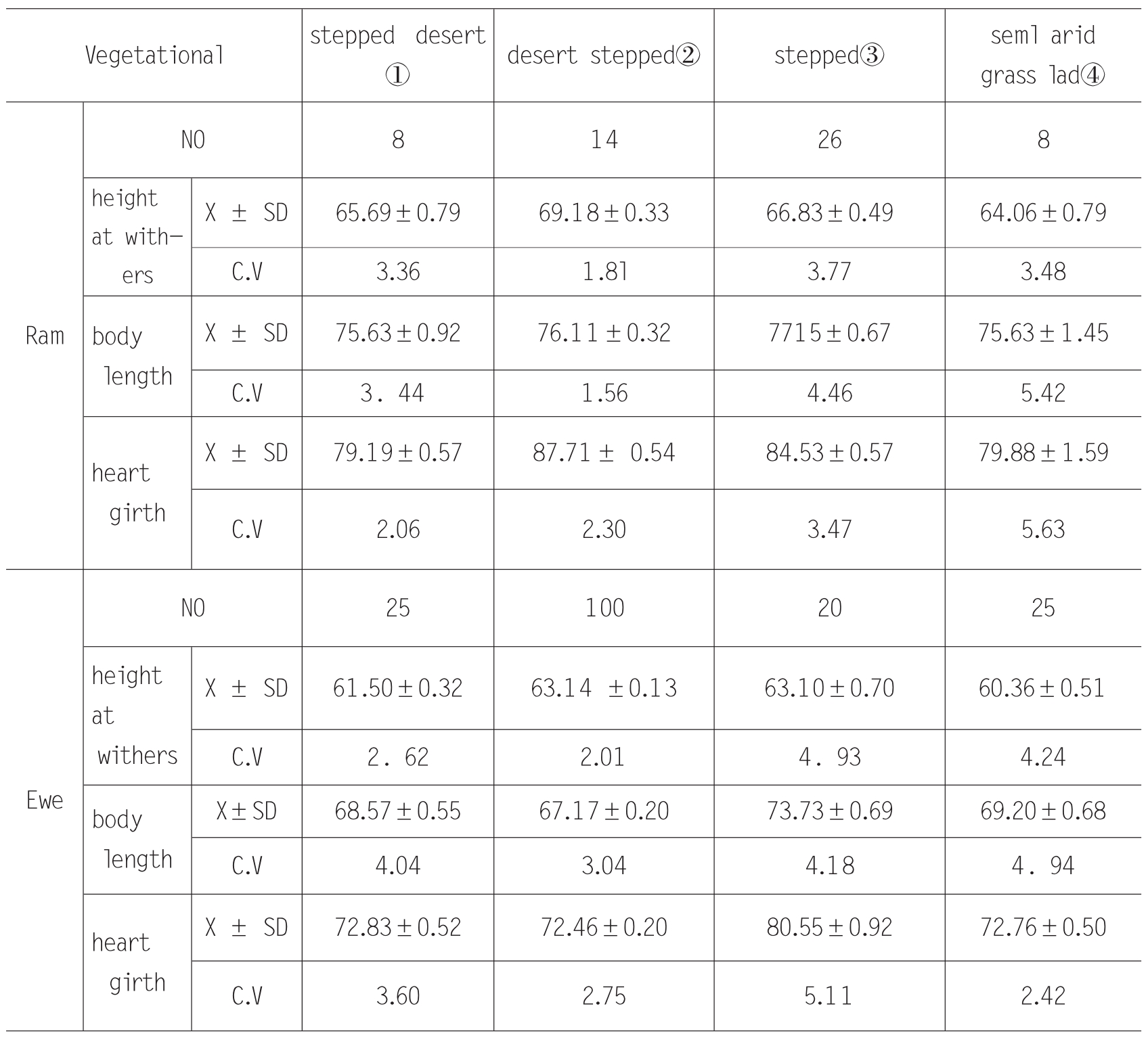
Note:①Tested at Changluishui of Alashan Left Banner of Inner Mongolia in1965.
②Tested by Ningxia Animal Science Institute at the foot of Helan Mountain in l962.
③Result drawn from Tan Sheep Breeding Farm in Yanchi,1976.
④Tested at Xiaonangou, Huan County of Guansu Province in1978.
(2)Wool
The wool of Tan sheep is unique fiber which is white, lustrous, long and fine with natural wave-like crimps;no withered hair or kemp;very brilliant when dyed.
Body Size of Tan Sheep Lamb
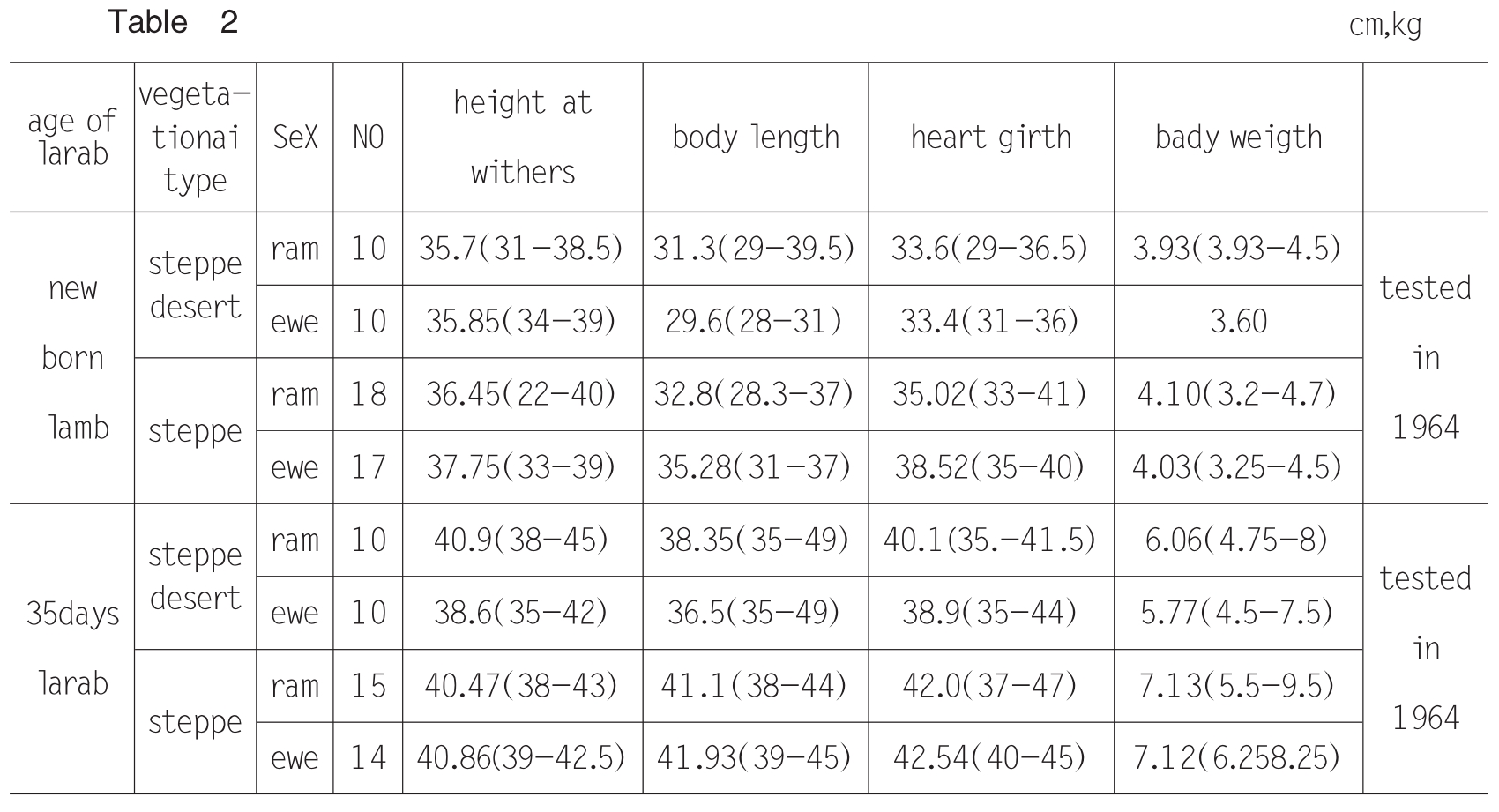
The wool density of adult sheep is1,771/cm2, which contains7.0%of medullated fiber(44.87±10.18/cm,9.5-10.7 cm long),15.22%of heterotypical fiber(33.13±8.62 pm,14.3-18.3 cm long) and77.78%of nor-medullated fiber(19.07±5.85μm).The clear content is65.38%and lanolin is7.22%.
The quality and yield of wool differ from regions to regions.The wool from desert steppe is finer but with fewer yields than that of steppe(Table3).
(3)Meat
The sheep is a late mature breed under the condition of grazing on completely natural grassland.The body weight of yearling is only46.57%of the five-year-old one’ s;while the two year old is63.27%, three year old is85.41%and the four year old is91.60%.The dressing percentage is low(Table4).
Tan sheep is a hardy breed of sheep, able to thrive on very poor pastures.It can rapidly gain weight and store fat during summer and autumn when the grass resources are the best.It still has weight-gain potential if under conditions of feedlot management.Yearlings could gain daily100.759(Yang Shenlong,1979) and180g(Yin Changan, Huang Xueshuang,1985).The four -year -old sheep(castrated)’ s daily weight gain could reach80.5-112.0g(Zhao Zhibin,1982).
The Wool Yield of Tan Sheep
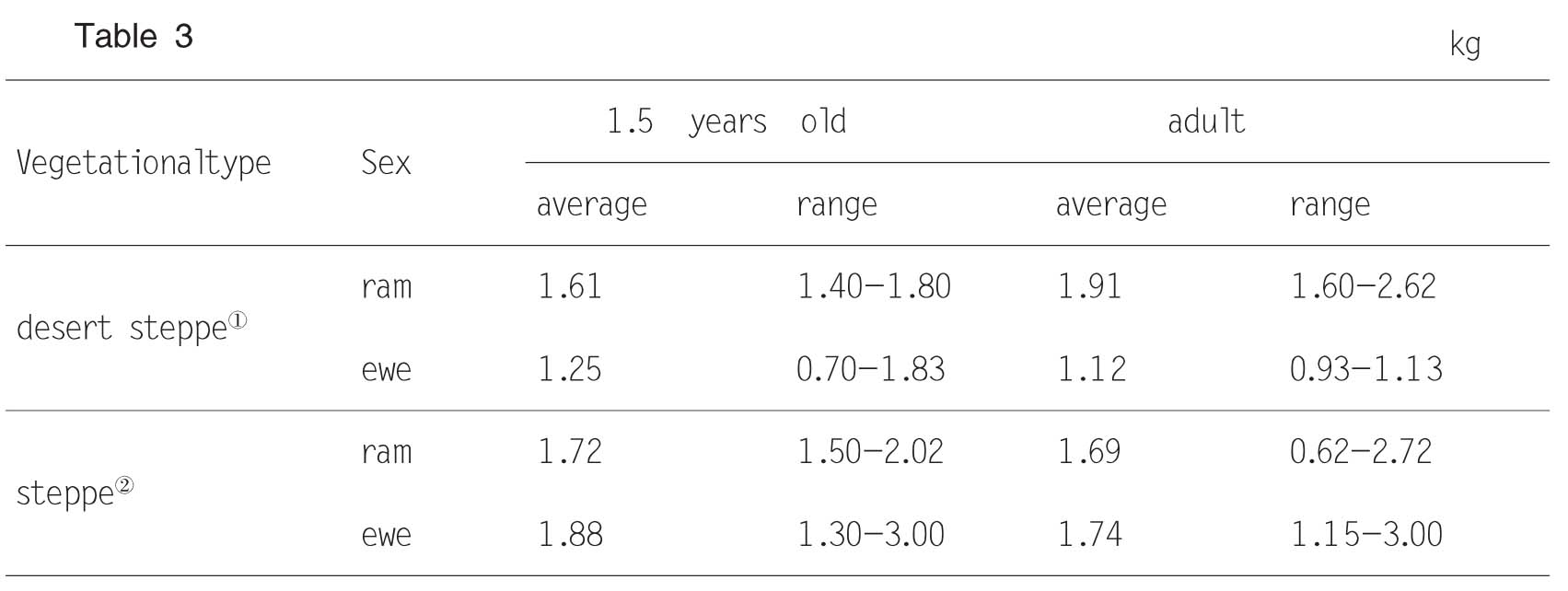
Note:①Tested at the eastern foot of Helan Mountains by Ningxia Animal Science Institute
②Tested at Tan Sheep Breeding Farm in Yanchi.
Meet Productivity of Tan Sheep
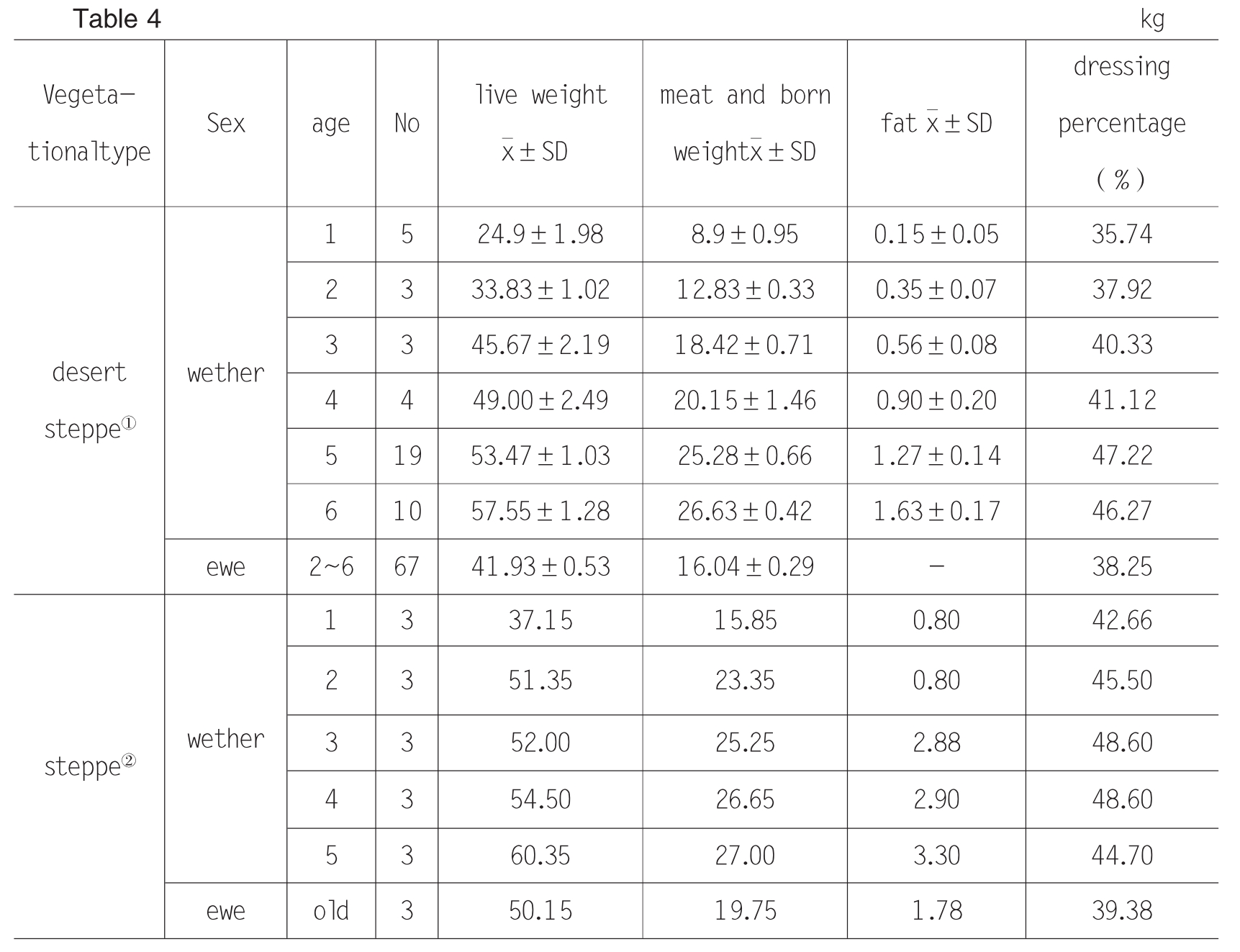
Note:①Tested at eastern foot of Helan Mountain by Ningxia Animal Science Institute in l979 to December l982
②TestedbyYanchiGrasslandStationinNovember1977.
The meat of Tan sheep is tender;fats and lean meat are well mixed.Without the smell of mutton, it is of the best quality among coarse wool sheep breeds.The dishes made of Tan sheep mutton(Ding Chao,1992), such as boiled mutton, preserved mutton, lamb stew and braised chopped entrails of sheep(mixed lung, heart, liver, intestines, tripe, etc.) are delicious and have long history.Thus Tan sheep meat is well known by local people and sells very well in domestic markets.
(4)Reproductive capacity
①Ewe.The age of puberty of Tan sheep is8-9 months and at the age of18 months, the ewe can be used for reproduction and can be continually used for six years.The ewe starts estrus in July and each peak in August and September.The gestation period is149-152days and the conception rate is98%.Lambing period is from December to March and January is the most concentrated month in which about36.3%of the lambs are born;the twin rate is about3%;the survival rate is85%.Under better nutritional condition, the“three lambs in two years”technique is recommended(Xu Baishan,1986).
②The age of puberty for rams is8 months.The ram starts service at age of two years and can be used for four years.Most herdsmen mix herding the rams and ewes at a rate of1:12 for natural tupping.Large farms also employ artificial insemination technique.The ejaculate volume of ram is1 -1.5 ml with sperm density of1.5 to2.2 billion/ml;the average sperm motility rate is0.8(Xue Zongyi,1978).
(5)Milking ability
The milk yield of Tan sheep is greatly affected by several factors such as age, times of lambing, lamb season and the nutritional level during the late period of gestation and lactation.The total milk yield in lactation(January to June) at different ages are: two year old21.74 kg;three year old57.98 kg;four year old55.96kg;five year old25.66kg and six year old11.16kg(Yang Shenlong,1983).
Ⅳ.Agricultural System and Tan sheep Quantity Distribution in Ningxia’ s Tan Sheep Raising Areas
1.Ningxia agricultural production system
Ningxia Hui Autonomous Region has a total area of51,800 km2, of which arable lands are1,758,900 hectares, woodlands362,900 hectares with forest coverage of4.85%, and available steppes3,605,500 hectares.The excellent Tan sheep raising areas in Ningxia include14 counties(or cities) in the three regions of north of Yinchuan, Yinchuan and Shizuishan’ s mid and northern parts, covering a total area of35,017 km2 , in which available steppe area is2,031,600 hectares,77.9%of the total.In the areas there are425,800 households and1,906,000 rural population, of which630,400 are Huis, accounting for32.16%.The areas, with3600,000 hectares of irrigated farmland, benefit a great deal from gravity irrigation of the Yellow River and enjoy better development in agriculture.
Wheat, rice, corn, vegetable, melon and fruit such as watermelon, wolfberry and apple are cultivated at large areas.The average yield of intercropping spring wheat with corn amounts to5,050~5,892 kg/ha;one crop of rice yields9,000kg/ha averagely.Melons and fruits are of superior quality.The total agriculture output value reaches to2.35 billion Yuan(RMB), of which cropping output value occupies1.63 billion Yuan, accounting for69.39%;forestry76.63 million Yuan,3.26%;animal husbandry538 million Yuan,22.89%;fishery63.4million Yuan,2.69%;and other41.38 million Yuan(RMB).
2.Quantity distribution of Ningxia Tan sheep
Ningxia Tan sheep are distributed all over Ningxia, Inner-Mongolia, Gansu and Shaanxi, covering29 counties(cities or banners) in the four provinces.Ningxia as the origin of Tan sheep produces58%of the total and the best in quality.Ningxia’ s TAN Sheep is mainly raised in the mid and northern parts of Ningxia(see Table5) and is intensively distributed in the two ecological zones, i.e.the desert steppe zone centered around the Helan Mountain, taking up47.3%and the arid steppe of Orders Plateau to the east of the Yellow River, occupying the other52.66%.The raising number of Tan sheep is40%-67%, greater than the yearending population(see Fig.1.2).By means of grazing, over95%of the sheep scatter in farmers and herdsmen’ s households and only3%are state owned.
Table5 Tan Sheep Distrubution in Ningxia Sheep Rarising Areas
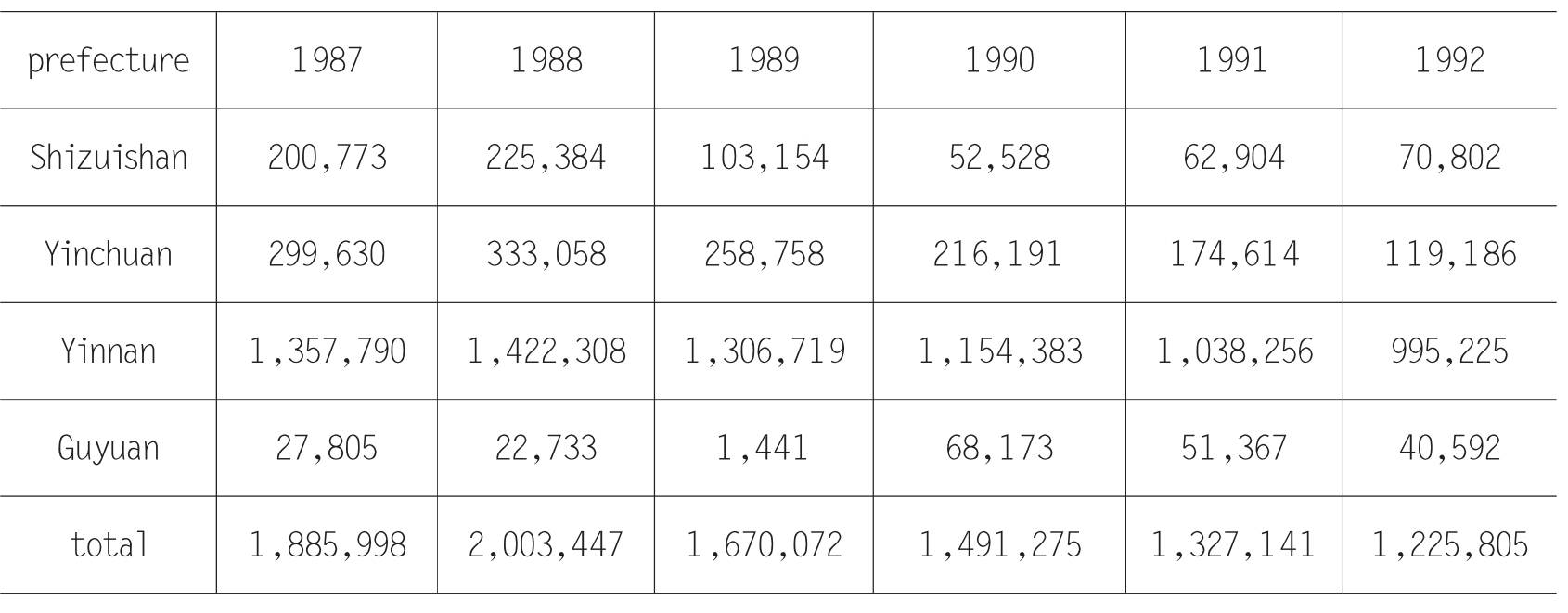
Ⅴ.Production of Ningxia Tan Sheep
Ningxia is located in the arid windy inland northwest of China, with extremely fragile and unsteady steppe ecological environment.Precipitation is the principle factor impacting Tan sheep pasturing and production.Owing to significant seasonal changes of rainfall, the sheep production has obvious seasonal characteristics and so do the sheep’ s weight and health conditions.
1.Productivity of steppe
Ningxia Hui Autonomous Region has at present3,014,000 hectares of natural steppe, taking up58.2%of Ningxia’ s total land area.Available steppe area amounts to2,625,500 hectares with a total sheep-bearing capacity of2,941,000 sheep units.From south to north, climate changes from semi-humid to semi-arid, arid to semi-desert.Vegetation types(11 types, see table6) show clear transitional properties as well.Among the11 types, desert and arid steppe take up the largest percentage, accounting for79.19%of the total area, and are the main grazing region of Ningxia Tan sheep.Grass yield of the steppes varies greatly from year to year due to the influence of climate and rainfall.
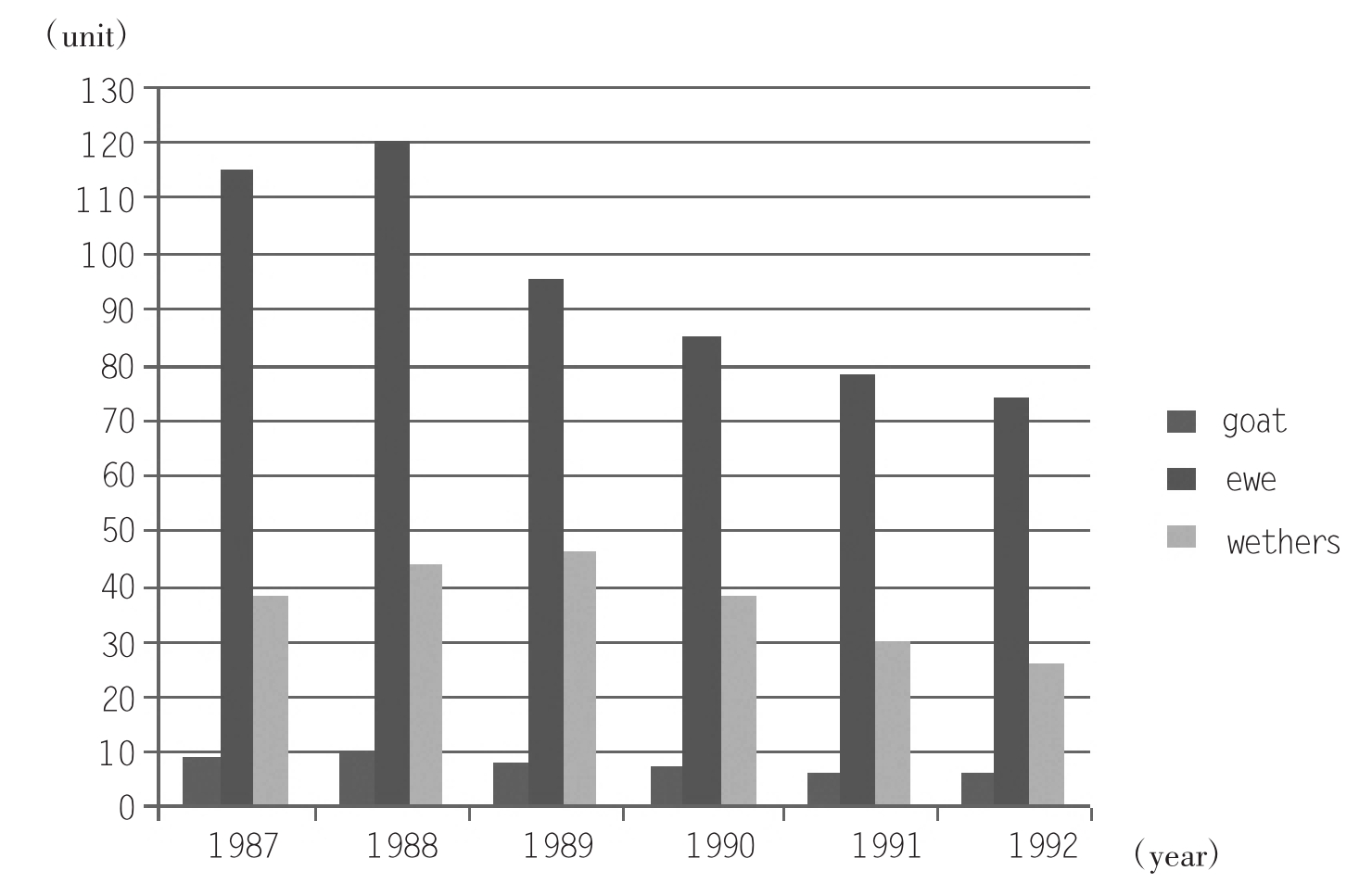
Fig.1 Variations in livestock-and population of Tan Sheep-Ending(1987-1992)
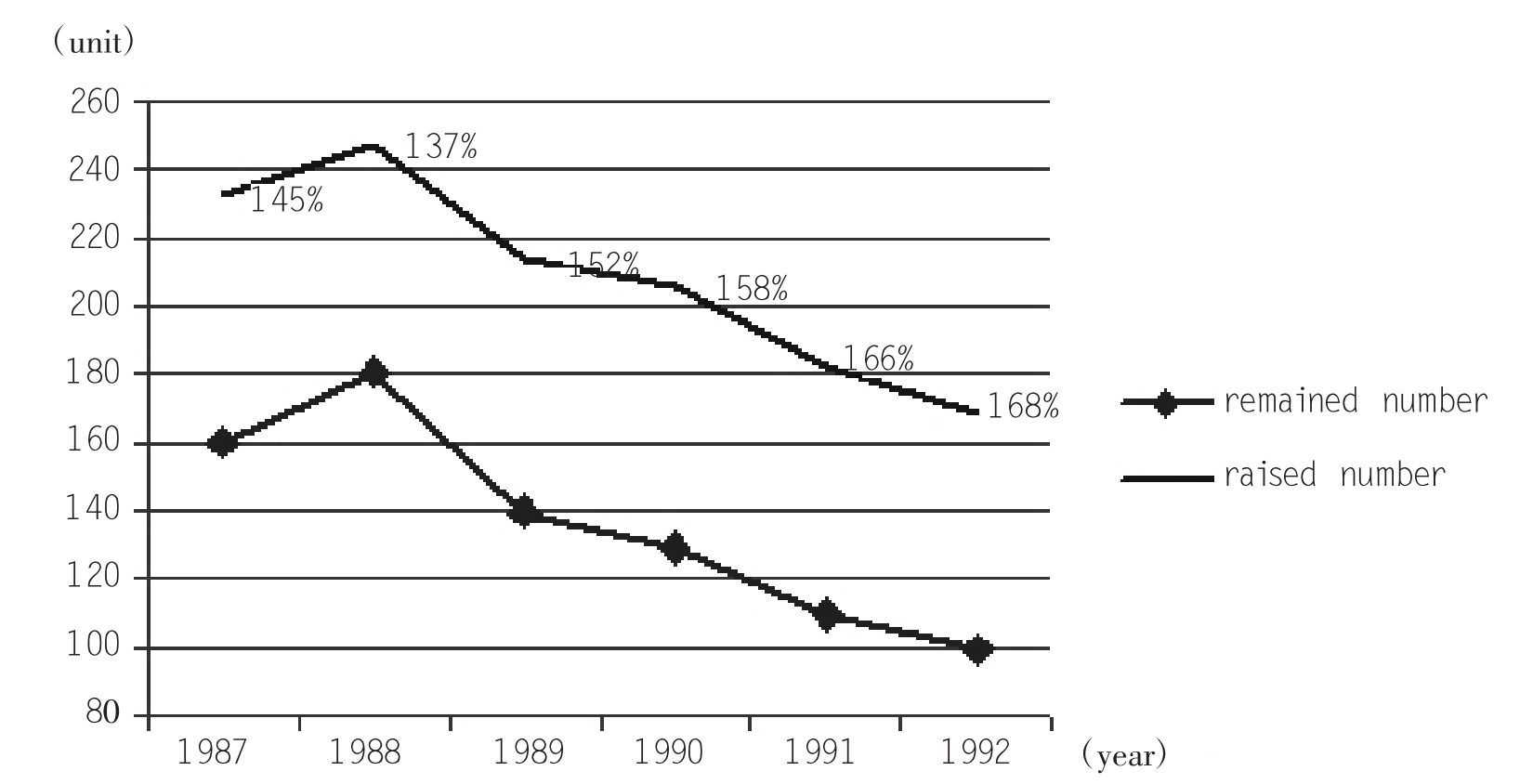
Fig.2 Variations of year-ending population and component of Tans Sheep(1987-1992)
The main plants in the desert steppe zones along the Helan Mountain include Stipa gobica, S.glareosa, Reaumuria soongorica, Peqanum harmala, Convolvulus tragacanthoides, Nitrara sibirica, Suaeda salsa, Ajania achilloides, Oxytropis uccphylla, Caragana korshiskii, Salsala passerina, Zygophyllum Xanthoxyonn, Aremisa sphaerocephala, Artemisia annua, Conuolvulus ammannis, Cleistogenes squarrosa, etc.
Ningxia Natural Grassland Types, Area and Livestock-Load Capacity
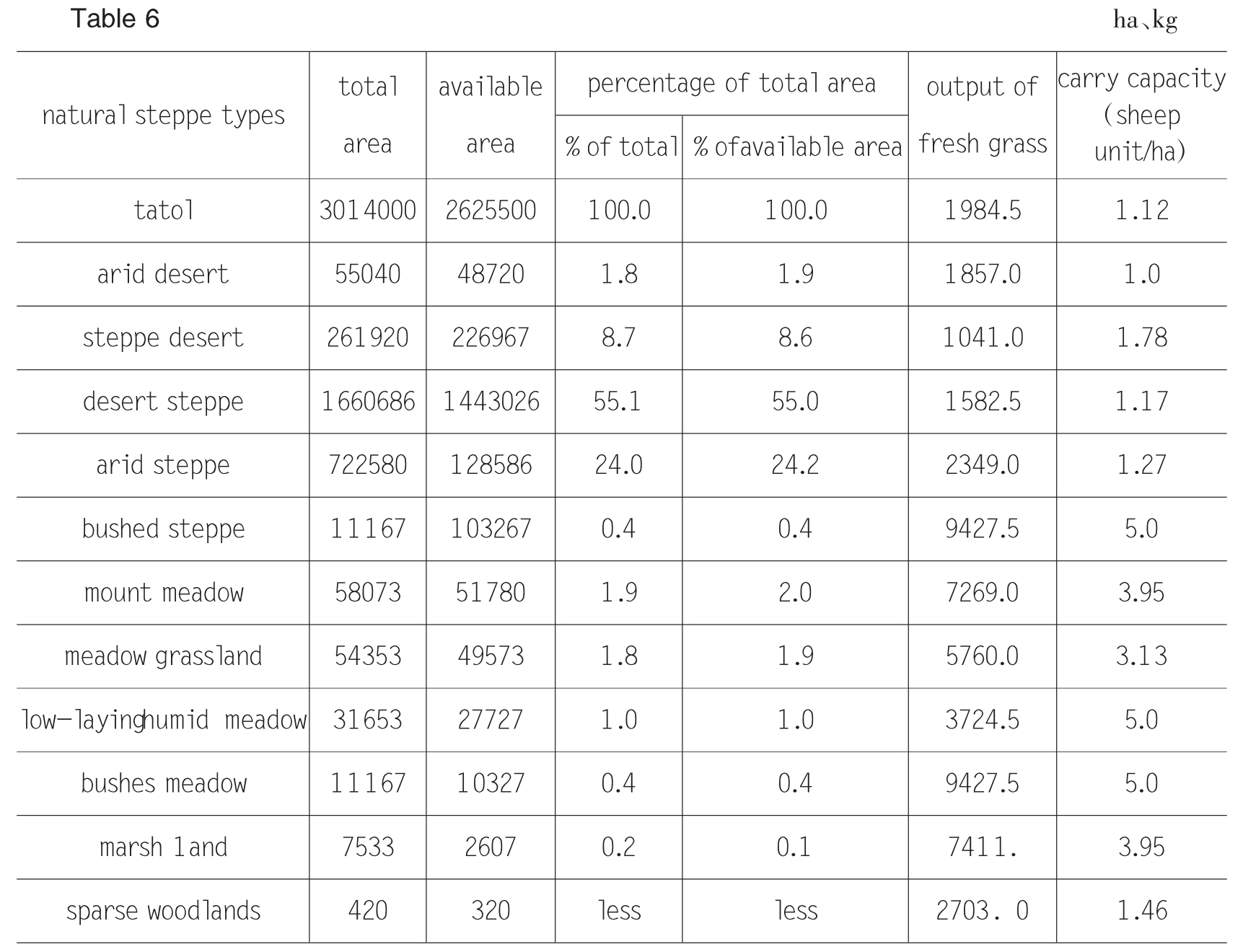
In arid steppe zone the main plants are S.dungeana,S.dreviflora, A.giraldii, Atemisia frigida, Caragena microphylla, Clycyrrheza uralensis, lespedeza davurica, Heteropappusaltaicus,Poa.Sphondylodes,Peganumharmala,Cynanchurn komorovii,Sophraalopecuroides,Alliumtenuissimum,Komorovii,Sophora alopesuroides, Allium tenuissimum, Linum amurense, etc.
2.Tan sheep flock Structure
Tan sheep flock structures are shown in Fig2 and consist of ram, ewe, replacement ewe and wether;the ratios of each are listed in Table7.
Table7 TAN Sheep Flock Structures
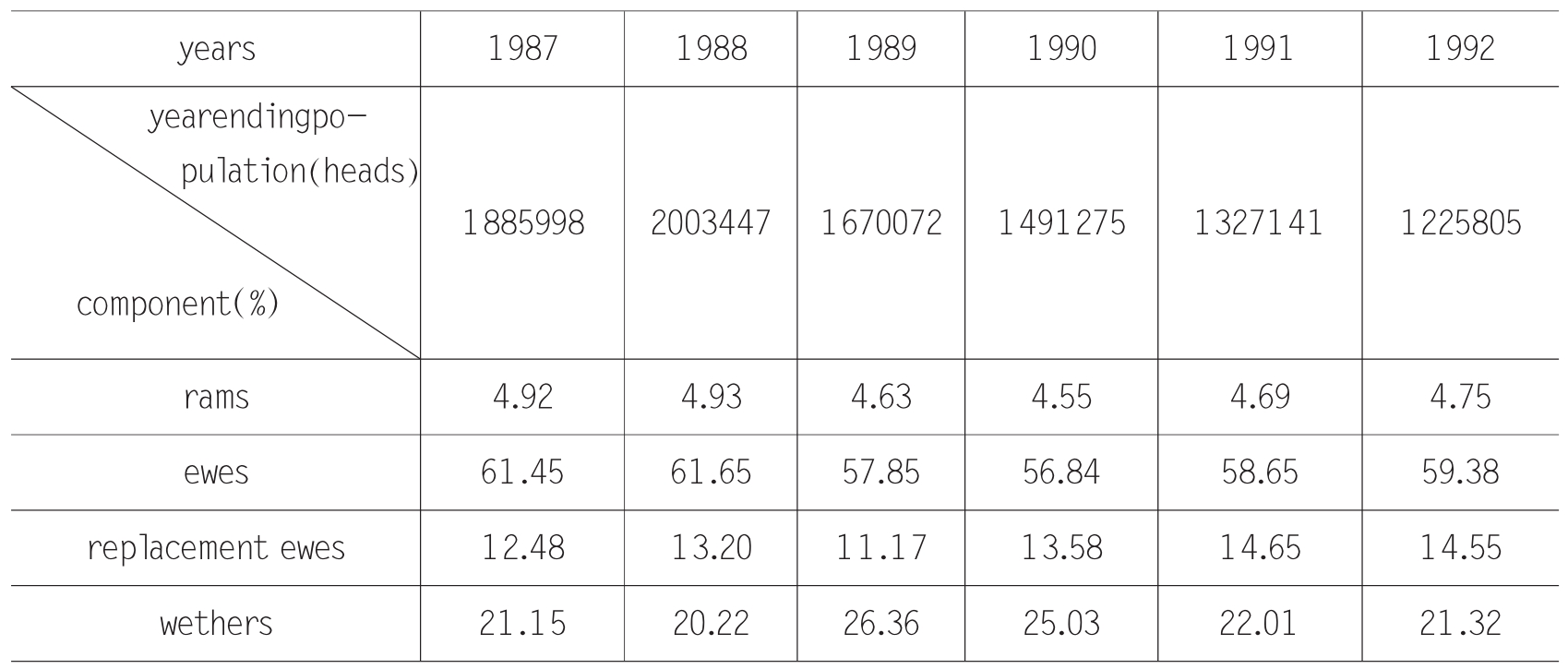
Tan sheep flock size is decided by conditions of region, steppe and grazing technique.Generally speaking, the flock size is smaller in cultivated areas and larger in pastoral areas.A sheep flock is usually composed of50-200 heads in irrigated cropping areas and100-400 heads in pastoral areas.Flock sizes and structures are detailed in Fig3-5.
3.Tan sheep grazing and raising management
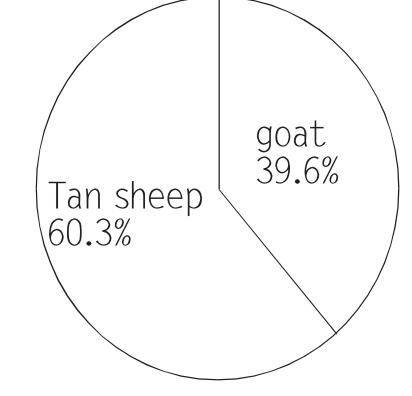
Fig.3 (376 heads/flock)
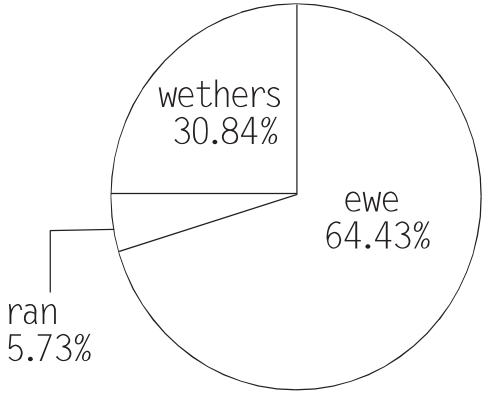
Fig.4 (227 heads/flock)
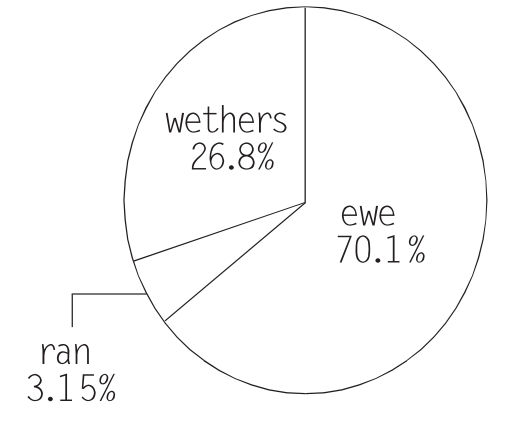
Fig.5 (97 heads/flock)
Fig.3 Xuguangtan in Yanchi County(376 heads/flock)
Fig.4 Shijiahao in Lingwu County(227 heads/flock)
Fig.5 Majiatan in Wuzhong County(97 heads/flock)
In harsh natural environment, Tan sheep has been surviving for a long time, pasturing all the year round, enduring drought, hot summer, wind, sandstorm and cold winter.On larger fa.rms, rams and wethers, ewes1.5 years old, replacement rams and ewes under the age of1.5 years are pastured in different groups respectively;while agro-pastoral households generally pasture their sheep in mixed flock.The sheep are out for grazing after sunrise and back before sunset;Lambs sucking period are given special care, separated from other pastured groups.According to field observation, sheep flocks move at a speed of24.51m/min on average during grazing(Li Fong, Xin Gang,1959).
In the desert steppes and arid steppes in mid and north Ningxia, the amount of rainfall has a great effect on steppe productivity.Usually the period from the mid and end of May to November is Tan sheep’ s fattening time.Tan sheep has the heaviest weight in November,44.5 kg on average for mature ram or wether and36.2 kg for ewe.
From December, when weather gets cold and winter comes, begins the grassdeficient period and it last till next May, during which the sheep weight is the lowest, losing25%-30%compared with the largest.In view of these changes, some of old sheep would be fattened first and culled before winter.The rate for elimination is greater than30%in extremely dry year(if there is no rainfall for7 months from January to July) when the Tan sheep’ s estrus, mating, propagation and lamb quality are seriously affected.
In spring and winter, lambed ewes and sucking lambs are fed with corn as one of supplementary feed for pasturing by an amount of250 g and50 g daily;For the smaller amount of one-year-old weak ewes supplementary feeding is necessary in spring, too;other sheep do not need special treat unless in seriously dry years.
In irrigation agricultural regions, each household owns only a small number of Tan sheep, so farmers employ a herdsman to gather the sheep from every family and pasture them over hills.Farmers get their sheep back at the end of autumn for confined rearing to survive the winter.Moreover, there are some households specially engaged in sheep fattening and selling mutton sheep(500-12,000 heads a year).In a word, the level of grazing management and raising of Ningxia Tan sheep remains backward and is necessary to be bettered in the future.
4.The health problem of Tan sheep
Ningxia Tan sheep has strong body, great resistance to diseases.Sheep disease incidence rate is lower during summer and winter, and goes up in spring because of deficient nutrition and decreasing immunity.and the sheep’ s death mainly occurs in this period with a mortality rate about3%-5%.
Acute infectious disease such as sheep pox and clostridial disease of sheep occurred in parts of Ningxia, but did not cause wide spread.After1970s Ningxia implemented“Infectious disease immune technique regulation”and general prevention measures, to effectively control sheep infectious disease was awarded by the Ministry of Agriculture and the Ministry of Health of the State.
The present common disease and frequently occurring disease are mainly as follows:
(1)Lamb dysentery: The disease mainly endangers lamb within seven days old, whose symptoms include intensive diarrhea and small intestine ulcer, causing the death of lambs in great number.It is estimated that there were10,472 lambs caught by the disease and2,252 lambs died in the three years from1987 to1989, and the death rate is about21.5%.
The occurrence of the disease is related with breeds.The incidence rate among Tan sheep is lower than Xinjiang fine-wool sheep and other hybrid sheep.By adopting common antibiotics and lamb dysentery vaccine(serum), strengthening management and cleaning the sheep pen can effectively control the disease up to now.
(2)Pneumonic mycoplasmosis of sheep: The case was first found in Tongxin, Ningxia, in l981 and from l987 to1989 sample investigation on195 flocks of sheep in the whole region of Ningxia was conducted to find out that the average infection rate was21.28%;the infection rate of sheep is higher than goat’ s;mortality is55.1%.Hydrochloric acid, terramycin, and sulphanilamide sylaergist can cure the disease;3%Lysol and10%limewater can disinfect the sheep pen and prevent the disease effectively.
(3)Sheep tetanus: The disease is caused by undemanding disinfection or contagion of the wounds during delivering lambs, cutting umbilical cord, shearing wool and castration.Though the incidence rate is not high, the death rate caused is higher.There were223,847 sheep got infected and64,660 sheep died in the40 years from1948 to1989.With strict disinfection or injection of tetanus toxin, the disease can be prevented effectively.
(4)Coenurosis cerebralis avis: This disease occurred sporadically, whose incidence rate is in positive correlation with the amounts of dogs raised in countryside(the dog is intermediate host).The incidence rate is1%-3%.Oral intake of Albendazole can get better effect.
(5)Sarcoptes ovis: This chronic skin disease is caused by the parasite of sarcopticmite.Goat is more likely to be harmed than sheep.The diseases caused76,802 sheep dead from1955 to1981, of which goat took up more than70%.There are a lot of medicines to choose to cure the disease, of which miticide is the best;by250 ppm bath,600 ppm spray or inunction can cure the disease.It is widely used now in production.
(6)Oestrosis nasus ovis: Oestrosis nasus avis is nasosinusitis caused by the parasite in sheep’ s nasal cavity.It is estimated that there were52,072 sheep died in the40 years from1948 to1988.The total incidence rate is3.28%.The trial treatment effect with many medicine shows that Dovenix made in France can be effective up to95%and a medicine made in American can be effective up to99%;both are ideal medicine.
Ⅵ.Manufactory and Marketing System of Tan Sheep Products
The ewe starts tupping at l8 months old and gives lamb at the age of two years old.During July to September, the tupping season, put the rams into the reproductive ewe flocks at a rate of1∶12(ram: ewe) for natural tupping.The conception rate can be over95%.Separate rams from ewes after tupping season.Lambing starts from December till next March.The lambing rate was90%-95%, and the lamb survival rate is95%.About30%of the lambs are killed at age of30 days for Tan sheep lamb fur.Weaning the rest at age of4 to6 months, the ram and ewe lambs are separately raised in different flocks.The ewe lambs then become replacement ewes and most of ram lambs are castrated and raised as wether.Mature sheep will be culled at6-7 years old.
Producing of Tan Sheep Products
Tan sheep products include lamb fur, wool, skin(mature sheep skin) and meat.Most products have been described in Part IV.Since Tan sheep are mainly raised in households, the actual raising number is40%-60%larger than the official statistics in statistical yearbook, so is Tan sheep products.The yields of main products are listed as follows.
Lamb fur: the lamb fur is mainly taken at February to March.In1992230,000 fur-pieces were produced.On the basis of raising numbers the yield is around218.400 to370,000 pieces.
Wool: Tan sheep is sheared twice a year, i.e.the beginning of Jun(spring wool) and the first half of September(autumn wool).Spring wool accounts for61.54%-71.67%of the total yield of a year, and autumn wool38.46%.In1992 the total output of Ningxia Tan sheep wool is2,602.54 tons, and estimated on the basis of raising number the overall quantity can reach to about3,310.22 Tons.
Skin(Mature sheep skin): Tan sheep skin is mainly produced in November and December when the flocks are readjusted to cull the old and weak sheep after quick fattening.The total yield of Tan sheep skin in l992 was473,699 pieces and20,000-30,000 lamb skins(the ewe did not have enough milk and the lamb’ s pelt cannot match the quality required for lamb fur but have to be killed to protect the ewes).
The Tan sheep meat: Tan sheep meat includes lamb meat and mutton.Mostly, the price of fresh tender lamb meat is20%higher than mutton.The lamb meat is produced during getting the lamb fur.The culled sheep are killed to get sheep skin and mutton in November and December.The carcass weights of mutton in different ages are different(Table4).The total output of Tan sheep mutton was6,500 Tons(including1,830 tons of lamb meat) in l992.The average carcass weight of lamb is5.0±2.3kg and mutton,12.0±3.5 kg.
1.Processing and marketing of Tan sheep products
Except mutton and lamb meat which were directly sent into markets, the process system of Tan sheep products are well developed and the processing capacity are greater than the quantity of production.Each large processing enterprise has its own marketing department responsible for purchasing raw materials and selling products.The price is highly affected by the cost of the product and the demands of market.By-product of sheep such as blood, entrails etc.are not be further processed(but still consumed as food) due to lack of technology, capital and difficulty in collecting raw materials.
(1)Processing of lamb fur: Three factories located in Yinchuan, Yanchi and Wuzhonare specificly established to process lamb fur, among which Yinhuan Fur Processing Factory is the largest with more advanced equipments and techniques.It could process300,000 lamb furs into coat, bed cover, shawl, scarf, etc, which have been sold to Europe, South East Asia and America.Yanchi Fur Factory has a capacity of processing100,000 lamb furs and some of its products have been sold to international markets.Wuzhong Fur Factory also has a capacity of processing100,000 lamb furs and most of its products are sold in domestic markets.There are also some small private workshops which still employ traditional method in processing lamb fur.Thus in this region, more than600,000 lamb fur can be processed each year, which is more than enough for processing Tan sheep lamb fur and Zhongwei goat skin(with the similar feature as lamb fur).
The profit allocation of lamb fur is as follows:
Price of lamb fur(herdsman’ s sales price) is35.0±7.50 Yuan/piece tanning cost is5.0 to7.5Yuan/piecefactory price of finished product(for coat) is400.0±50.0 Yuan/pieceMarket price(retail price) is500.0±30.0 Yuan/piece.
(2)Process of sheep kin: Four large factories and a dozen of small private workshops exist in Yinchuan, Yanchi, Tongxin and Guyuan, which can process1,000,000 sheep and goat skins every year.Yinchuan Leather and Fur Factory have100 unit equipments and is able to process400,000 skins and produces1600,000 Chi2(about2,080,000 feet2) of leather.Each of the leathery factories in Yanchi, Tongxin and Guyuan can process100,000 pieces of sheep skin every year.The sheep and goat skins processing capacity in this region can meet the overall production output in Ningxia.Most leather produced from Tan Sheep is sold in domestic market.
The price and profit allocation of sheep skin:
Raw skin price is60.0 ±25.0 Yuantanning cost8.0 ±1.50Yuanfinal leather product(factory sales price)13.0±2.00 Yuan/chi2sales price(of coat)440.0±30.0 Yuanretail price(in China)480.0±20.0 Yuan.
(3)Process of Tan sheep wool
Tan sheep wool processing is mainly woolen based.Eight woolen mills are located in Yinchuan, Pingluo, Lingwu, Wuzhong, Zhongning, Zhongwei and Guyuan, which are able to produce1,000,000 flowery blankets,1,200 tons of woolen yarn.Established in1954, Yinchuan Woolen Mill can produce300,000 flowery blankets each year, and is one of the largest mills in China to produce pure woolen blankets.The technique and the quality of the products are also among the best ones in China.The“Tan Sheep”brand6502 flowery blanket and“Xiagui”brand6508 blanket have been awarded with silver prize by Chinese government(no gold prize is set) and recommended as best quality products by the Ministry of Light Industry since1980.These two products have very good reputations in China and have been sold to Europe, America and Australia.
The price and profit allocation of Tan sheep wool: grease wool(not sorted)14.00 ±3.50 Yuan/kg—whole sale16.0 ±4.50 Yuan/kg—the blanket unit price(factory sales price) ,138.0 -170.0 Yuan/piece—retail price(in China)148.0 -200.00 Yuan/piece.
The above prices are only based on the present level of product processing technique.It still can be raised higher if the processing technique and the style and the quality of products are improved.
Ⅶ.Effect of Tan Sheep Production on the Development of Society and Economy and Its Significance
The special characteristics and productive capacity of Tan sheep are unique in the world, thus they have attracted more and more attention from not only scientific researcher but also markets both at home and aboard.Tan sheep is a major part of utilizing natural pasturing in Ningxia, the pillar of Ningxia’ s animal husbandry, and principle source of income for farmers and herdsmen.Hence, it plays a very important role in the social and economic development of Ningxia.
1.Tan sheep production is the main prop in Ningxia’ s animal husbandry
From the survey carried out on the basis of Tan sheep’ s raising quantity and its market price in1992, it can be seen that the total production value of Tan sheep is304,052,000 Yuan,56.5 %of the total output value of Ningxia, i.e., a half of Ningxia’ s animal husbandry revenue comes from Tan sheep production.
2.Social and economic meaning of Tan sheep products processing
The further processing of Tan sheep products does not only results in the products output value rising but also more foreign exchanges, tax profits and more chances for jobs.According to statistics, after processing, the total value of lamb fur, sheep skin and wool have been increased to86,603,000 Yuan than that of the raw material, which is180,504,600 Yuan;profit taxes are2,500,000 Yuan;jobs for10,000 people have been offered and more products have been manufactured for the whole society’ s consumption.
Ⅷ.Inhibition Factors on the Development of Tan Sheep and Its Potentiality.
In spite of the fact that Tan sheep lives in a very special environment and its production is affected by the limitation of natural conditions, the special characteristics of Tan sheep products indicates a great vision for its further development.Its potentiality is great provided that Tan sheep product quality and processing techniques have continuously improved.
1.Inhibition factors
(1)Adverse circumstances
Tan sheep live in inland northwest of China, with a typical continental climate and worse natural conditions.Due to factors of drought, insufficient vegetation and unrestricted overgrazing and exploitation of, serious deterioration of steppe and desertification in a large scale are caused.At present,97%of natural grasslands show signs of degradation to varying degrees;among them28.4 %are water -deficient of moisture and34.64 %are desertified.There is an obvious imbalance between supply of and demand for forage.Especially during the period of scarcity of water and stock food in winter and spring(season of lambing), pregnant ewes have not enough feed to ensure its nutritional need, consequently, not only fur quality will be affected but also losses of ewes and lambs will be caused.Compared with1960-70s, Tan sheep weight shows sign of decline at the rate of23.0 %for wethers and28.02 %for ewes at age of2.5 years.
(2)Long terms of impoverished living situation for residents in Tan sheep production area:
On account of the inferior conditions in pastures, the investment in Tan sheep reproduction is far less than expected.All of this condemns the residents to nothing but a depressing living standards, poor education and limited technique.It is under such a state that the development of productivity is hindered and the potential is diminished.
(3)Research funds are not enough and equipments are backward.
Compared with other east and south parts of China, Ningxia is backward in economic, cultural, scientific and technological development.Financial difficulties mean no improvement on further study, products processing and technical exploitation of species resource.
(4)Ningxia’ s Feed Manufacturing Industry develops with a slow step.
Ningxia’ s feed manufacturing industry starts from1980s.Up to now, it has developed to a scale of yearly output of100,000 tons.The products are mainly mixed feed for poultry and swine, while feed products for sheep and cattle are seriously lacking.The production of high quality concentrated feed and compound feed additives are still a blank, which is far from sufficient to meet the needs of the development of animal husbandry.
2.The potentiality of Tan sheep production
There are more than200 varieties of sheep in the world, but there are no any other sheep breeds which have such remarkable characteristics1ike Tan sheep worldwide.The distinction of Tan sheep from others by far indicates enormous potential of production and economic returns.In view of bad living conditions as well as decrease in quantity, reservation of Tan sheep resource is a duty-bound work with scientific and economic value.
(1)Tan sheep wool, lamb fur and sheep skin are with high exploitation value.
In Ningxia, the lamb processing is still in developing stage of a low level.Nevertheless, The special luster and physical characteristics of Tan sheep wool fiber are unique;especially the wool of lambs under2 years old, which are long but fine, ideal for high range worsted textile and has great potential of entering international markets.Based on the trial conducted by Snow Leopard Group in Haining County, Zhejuang Province, Tan sheep skin is demonstrated to be of higher utilizable value for making high-grade leather apparel, too.
(2)Marketable mutton
Tan sheep meatis well accepted by people for its tenderness, pleasing flavor and good taste.It is not only the local residents’favorite;moreover, it has been successfully introduced into Beijing, Tianjin, Guangzhou and Shanxi province with increasing demands.The tendency of demand exceeding supply will stimulate market price, promote production potentiality.
(3)There are abundant fodder resources in Ningxia irrigated areas of Yellow River.
Different from the natural pastures with low grass productivity in Ningxia, Ningxia’ s irrigated areas of Yellow River is rich in fodder and agricultural products, which provides a compensation of fodder during the period of stock food shortage.In the middle and north parts of Ningxia, though natural pastures’stock bearing capacity is2,326,000 sheep unit, the actual number of naturally pastured sheep exceeds3,000,000 sheep unit.In spring, about one third of Tan sheep are fed in the plains with crop straw,1eaves, vegetables and hay to effectively alleviate the stress on natural grassland.The yearly fodder accumulation in Ningxia is as follows: corn383,200 tons, chaff222,200 tons, cakes(especially bean cake and sesame cake)31,300 tons, crop straw1,933,000 tons, leaves81,500 tons and beet pulp300.000 tons.According to the fodder norm of average750 g per day for each lamb, by combination of17.6 %of corn and6.0 %of coarse fodder, the total fodder mentioned above can feed150 million sheep for180 days(December to next May).
Ⅸ.An Evaluation of the Research on Tan Sheep in Ningxia
The study on Tan sheep in Ningxia has already had a history of40 years since the article“Preliminary Study on Tan Sheep Wool”were published in1954 on“Central Journal of Animal Husbandry and Veterinary Medicine”(P37~40, the third volume , first issue) in1954 by Zhang Songyin and Liu Xiangmo, which was the result of through investigation and study in production place of Tan sheep, .
Since then, there have been over50 scientists and hundreds of grassroots technicians involved in the study of the Tan sheep in Ningxia and163 articles(see appendix) and2 monographs are published.In1977, the“Tan sheep selection and breeding cooperation group”involving Ningxia, Gansu, Inner -Mongolia and Shaanxi was established.It aided the breeding work of Tan sheep to be carried out in a planned and organized way.At the same time7 books and200 pieces of research materials were compiled.It had promoted the development and the improvement of Tan sheep in Ningxia.
1.Studies on Tan sheep in Ningxia(in chronological Sequence).
(1)In1954 Northwest Animal Husbandry Department and Ningxia Animal Husbandry Department made a combined investigation on the Tan sheep resources in Ningxia for the first time and wrote“Investigation Report on Tan Sheep in Ningxia”, which recorded in detail the distribution, quantity, constitution, appearance, reproduction and the production of wool and fur of Tan sheep.
The work was finished mainly by Liu Jinfa, Yang Guozhen and Huang Jianban.
(2)In1959, Ningxia Animal Husbandry Department, Ningxia Institute of Animal and Veterinary Science(the former Ningxia Institute of Agricultural Science) and Northwest Institute of Animal Husbandry and Veterinary of China Academy of Agricultural Science jointly made a systematic investigation on the Tan sheep(the second of this kind of investigation).The work lasted9 months and a investigation report of80,000 words was accomplished.The work was done mainly by Han An, Li Fen, Huang Shude, Xing Gang and He Guangming, etc.
(3)During1960-1964 Ningxia Institute of Animal and Veterinary Science and Northwest Institute of Animal and Veterinary Science jointly made a study of the selection and breeding of Tan sheep, putting forward feasible methods of selection of good stud ram, carrying out artificial insemination and early appraisal of the quality of lamb.The study was finished mainly by Cui Chongjiou, Xu Baishan and Zhang You, etc.
(4)In1962, Ningxia Institute of Animal Husbandry and Veterinary Science and Northwest Institute of Animal Husbandry and Veterinary Science made a joint study on the law of growth and development in the whole life span of Tan sheep(embryo—lamb—adult sheep).After4 years of study, the laws of growth and development in different life phases of Tan sheep were discovered.The work was finished mainly by Cui Chongjiou, Zhang Youling and Pan Junqian etc.
(5)In1964 Ningxia Institute of Animal Husbandry and Veterinary Science andNorthwestInstituteofAnimalandVeterinarySciencejointlymade determinations of the physiological blood indexes of Tan sheep and it’ s changes with different seasons.The study provided scientific basis for the definition of breed resources, breeding and disease diagnosis of Tan sheep.The main researchers finishing the study are Chen Xun, Zhang You and Zhang Youling etc.
(6)In1964, Ningxia Institute of Animal and Veterinary Science, Northwest Institute of Animal and Veterinary Science and Beijing Agricultural University jointly made a study on the factors affecting the quality of lamb skin fur.They discovered the effects of factors such as the age of ewe in lambing season, quality of wool and nutritive level of ewe in period of pregnancy of the quality of lamb fur.The work was done mainly by Cui Chongjion, Zhang Youling and Jiang Yin etc.
(7)During1965-1974 the Selection and Breeding Farm of Tan sheep of Yanchi and during1980 -1985 the Ningxia Institute of Animal and Veterinary Science respectively made studies on the genetic law of favorable wool strand of lamb fur and its application.On the basis of numerous experiments and analyses, they affirmed that the excellent trait of wool strand of lamb skin fur have genetic superiority.Applying this principle, they selected sheep having the same quality and made them mate.The result shows that the proportion of the excellent strand of the lamb fur of their progeny increased by5.0%-20.0%.This achievement provided scientific basis for the selection and breeding of excellent breed lines.The work was finished mainly by Kang Mensong, Cui Chongjiou, Xu Baishan, Wang Tianxing and Zhang Guorong etc.
(8)During1966-1985, the Selection and Breeding Farm of Tan Sheep of Yanchi andNingxia Animal Husbandry station jointly made studies on the selection and breeding of Tan sheep.After the selection and breeding of5 generations, they bred2160 sheep of No.1 breed lines and provided20,000 stud rams for11 provinces across China.The work was mainly finished by Guo Xiangshou, Kang Mensong, Wang Yongqing, Xing Gang and Yang Xuebing, etc.
(9)During1970-1979, Nuanquan Farm under Ningxia Reclamation Bureau made9 -year studies on the selection and breeding to raise the proportion of excellent strand to91.44%.After another9 years they bred the A Breed lines(represent the ecological areas of semi-desert grasslands of the eastern foot of Helan Mountain).The work was done by Yang Shenlong, Yu Lian and Ren Haiyang, etc.
(10)1970 -1980,①in1976 the team of scientific testing on resource utilization of the mountainous areas in south Ningxia from the China Academy of Sciences, Ningxia Institute of Information for Science and Technology and Lanzhou Institute of Desert jointly made a study of the ecological and geographical feature of Tan sheep in Ningxia.The researchers explored the comprehensive effect of different natural and ecological factors on the production of Tan sheep.(Sheng Changjiang, Fu Jinghai and Di Xingming).②During1976 -1978, Yanchi Tan Sheep Selection and Breeding Farm,, and during1980-1982 Ningxia Institute of Animal and Veterinary Science respectively made studies on the effect of close breeding of Tan sheep(Kang Mensong, Cui Chongjiou and Xu Baishan).③During1978~1980 Nuanquan Farm under the Ningxia Reclamation Bureau made analyses and tests of the heredity ability, correlation and regression of main economic trait of Tan sheep(Yu Lian and Yang Shenglong etc).
(11)In1978, according to the requirement of“On Organizing Nationwide Investigation of Breed Resources of Livestock and Poultry”issued by the Ministry of Agriculture, Ningxia Animal Husbandry Bureau and Ningxia Institute of Animal and Veterinary Science jointly made the third investigation of the breed resource of Tan sheep in Ningxia and wrote“Annals of Tan Sheep Breed”.The work was finished mainly by Cui Chongjion, Zhang You, Xing Gang and Yang Xixian etc.
(12)In1977, with the initiative and support of the Department of Science and Technology of the Ministry of Agriculture and Ningxia Animal Husbandry Bureau, the Tan sheep selection and breeding cooperation group involving Ningxia, Gansu, Inner Mongolia and Shaanxi was established and as a result mass selection and breeding activities of Tan sheep were extensively launched.
(13)In1980, the Department of Animal and Veterinary Science of Ningxia Agricultural College and Nuanquan Farm jointly made tests of13 physiological indexes of Tan sheep.The tests were mainly finished by Wang Xiwei, Chen Ruxi and Xu Jie etc.
(14)During1981-1990, the Department of Animal and Veterinary of Ningxia Agricultural College, Ningxia Animal Husbandry Station successively made study and promotion of“the three high and one quick”program(high in total increase of the flock of sheep, high quality, high commodity rate and quick turnover) of Tan sheep of Ningxia.They also made studies of the economic hybridization application, giving birth to three lambs in2 years and fattening experiment of Tan sheep of Ningxia.The work was done mainly by Wang Ning, Xu Baishan and Yin Changan etc.
(15)In1992, the study of comprehensive technique of raising economic benefit of Tan sheep was listed in the Development Plan of Science and Technology of Ningxia Hui Autonomous Region.
2.The contribution of the researchers
(1)The studies on breed origin, heredity and selection and breeding of Tan sheep:
①Research Fellow Cui Chongjiou, Xu Baishan and Zhang You have been engaged in the study of Tan sheep for over20 years(1960,1962,1963,1964,1965,1978,1980).They made a large amount of systematic and effective studies on the breed origin and evolution, production performance, selection and breeding of Tan sheep.Then major research achievements are: studies on the selection, breeding and determination of appraisal criterion of Tan sheep of Ningxia;the relation between breed property of Tan sheep and ecological conditions;production performance, quality of lamb fur and the factors affecting them;the genetic law of wool strand of lamb fur and the method of breeding.They obtained the Prize of Scientific and Technical Progress of Ningxia Hui Autonomous Region in1978.
②From1970-1985, Yang Shenlong(senior animal science specialist), Yu Lian and Ren Haiyang, etc carried out15 -year research of the selection and breeding of Tan sheep in Nuanquan Farm, and bred A breed lines of Tan sheep in Ningxia.They got the Second Prize of Scientific and Technical Progress of Ningxia Hui Autonomous Region in1986.
③During1966-1985, senior animal science specialist Guo Xiangshou, Kang Mensong, Xing Gang, Wang Yongqing and Yang Xuebing etc, by efforts of over20 years,5 generations, bred Nn.1 breed lines of flowery wool strand in Tan sheep Farm of Yanchi(areas of arid grasslands).The achievement obtained Third Prize of Scientific and Technical Progress of Ningxia Hui Autonomous Region in l988.
(2)Studies on raising production performance and economic benefit of Tan sheep of Ningxia:
①During1976-1980 professor Wang Ning, Jing Weizhen, Wu Xing and Ma Zhenzhong from the Department of Animal and Veterinary Science of Ningxia Agricultural College carried out studies and promotion of“the three high and one quick”program of Ninghxia Tan sheep at Grassland Experimental Station of Yanchi.Their effort directed the traditional nomadic based production of Tan sheep to the modern way of production and management, which attaches importance to marketing and economic benefit.The achievement obtained Third Prize of Scientific and Technical Progress of Ningxia Hui Autonomous Region in l980.Afterward, with another8 years’efforts of Yanchi County Government, up to now this way of production has been adopted widely in the production of Tan sheep by local farmers and herdsmen.
②In l981, Professor Yin Changan, from the Department of Animal and Veterinary of Ningxia Agricultual College, applied the principle of optimum seeking method, put forward the mathematical judgment formula of selection of optimum flock structure and rational slaughter time.The achievement changed the state of irrational flock structure(stud ram6.62%, ewe46.61%, wether15.7%and reserve ewe31.0%) and slow flock turnover, raising the proportion of ewe to60%and guiding the production of Tan sheep.The study obtained Third Prize of Scientific and Technical Progress of Ningxia Hui Autonomous Region.
③Xu Baishan(1965,1985,1986,1988), Tan Guangzhao(senior animal science specialist,1979,1982), Yin Changan(1982) and Jiang Keping(associate professor of Gansu Institute of Animal and Veterinary Science,1985,1986) etc respectively made studies on reproduction performance(three lambs within two years), performance of milk production and economic hybridization application and intensive fattening of Tan sheep.These studies are beneficial to the improvement of production performance of Tan sheep and provide scientific basis for further improvement of production performance of Tan sheep.
(3)Formulation of state standard of Ningxia Tan sheep:
In1979 Zhang You(senior lecturer of Ningxia Agricultural School), Yang Xixian, Xin Gang and Wang Lichen, etc began to study and worked out the State Standard of Tan Sheep of Ningxia.It was formally promulgated by the State Standard Bureau in l980.This work played an important part in the improvement of breed selection and breeding, production, unification of product quality and market of Tan sheep of Ningxia.
(4)Ecological studies of Ningxia Tan sheep
Research Fellow Shen Changjiang, Fu Jinghai and Di Xingming(1977,1979,1982), Zhang You(1982) Professor Hu Zizhi from the Department of Animal and Veterinary Science of Gansu Agriculture University(1984), and Lu Taian(1980,1982,1981), Zhang Hanwu(1984,1985), Kang Mensong(1985) and Li Shaoxing, etc respectively made studies on ecology of Tan sheep in respects of ecological circumstances, vegetation, climate, grassland grazing, ecology and selection and breeding.The work combined the production with ecological circumstances of Tan sheep.
(5)Development of processing technique and products of Tan sheep
The lamb fur(clothing) and jacquard woolen blanket are main products of exploring Tan sheep resources.Zhang Zhichao and Wang Shuzhen(former senior engineer of Yinchuan Woolen Mill) continually improved technology and raised the quality of their products.Their products,6502 jacquard woolen blanket of“Tan Sheep”brand and6508 jacquard woolen blanket of“Xiagui”brand have been awarded the national Silver Prize(no Golden prize is set) and the prize of high quality product by the Ministry of Light Industry since l980.Wang Yinfu and Huang Qipen, technicians of Yanchi Fur Factory, on the basis of introducing new technology, integrated the characteristics of lamb fur, made the technological level of tanning, bleaching, dyeing and forming clothes of lamb fur reach advanced level among the same trade in China.The achievement obtained the Third Prize of Scientific and Technical Progress of Ningxia Hui Autonomous Region.
(6)Ningxia Tan sheep march to the world
In1988, Dr John R.Sabine, associate professor of the Department of Animal Science, Waite Agricultural Research Institute, Adelaide University of South Australia, came to Ningxia on visit for the first time(total4 times).He inspected the production state of Tan sheep and gave good appraisal and new understanding of the breed and wool resources of Ningxia Tan sheep.During the14th-28th of June,1993, on invitation of Ningxia Science and Technology Commission, Dr.Sabine came to Ningxia again.He inspected the Tan sheep of Ningxia and signed on an agreement of joint scientific study.During18 -28 October,1993, Miss Ritter, Chinese Manager of Australia International Center for Agricultural Research, entrusted by Dr.Copland came to Ningxia and inspected the production situation of Tan sheep.On the solicitude and support of Dr.Copland and Miss Ritter the international cooperation on Tan sheep of Ningxia will surely come true.It will bring more income for farmers and herdsmen in the production areas of Tan sheep.The Tan sheep of Ningxia will have chance to go to the world.The Tan sheep resources also will make greater contribution to the world.
3.Direction of study and development in the future
To sum up, over the past40 years, a large amount of basic work has been done in the study and development of Tan sheep of Ningxia and great achievements have been obtained.At the same time there are great limitations.The knowledge on the potential value of breed resources of Tan sheep is not deep.The depth of study is not adequate.There is no big breakthrough in respects of the development of the products of high additional value.Therefore it is suggested that the study and development of breed resources of Tan sheep should begin in the respects as follows:
Firstly, understand the new value of Tan sheep resources of Ningxia.On the basis of production characteristics and product feature of Tan sheep, make new appraisal and understanding of the Tan sheep resources and rectify the miss translation of“Tibet lamb skin”for“Tan sheep lamb fur”in foreign trade activities, since the wrong translation will make great misunderstanding and is not beneficial for the development of Tan sheep resources of Ningxia.
Secondly, applying new biological and genetic engineering technology, quicken the improvement and raising of production performance of Tan sheep.The unique performance of the wool and lam fur of Ningxia Tan sheep have provoked the attention of the parties concerned overseas and have good prospect on the international market.Therefore it is necessary to fully utilize the opportunity of the international cooperative study, applying new biological technology and the method of genetic engineering to raise the production performance and the quality of Tan sheep wool.
Thirdly, deepen the development study of Tan sheep wool, especially in respect of spinning and weaving technique and the development of new products, fine fabric of high additional value.
Fourthly, pay attention to the comprehensive utilization of breed resources of Tan sheep, exploring the optimum technology of development of biochemical products.
Appendix:
Content of Articles Published before1992
[1] Zhang Sunying;Liu Xiangm.(1945).Preliminary Study of Tan Sheep.Journal of China Animal Husbandry and Veterinary Science,1:37-48.
[2] Sha Hengjun.(1954).Observation on the Straight Breeding of Xinjiang Sheep in Ningxia and Fl of XinjJiang Sheep Crossbed with Tan Sheep.China Animal Husbandry &Veterinary Science3:46-49
[3] Sha Hengjun.(1954).Discussion on Improvement of Tan Sheep.China Animal Husbandry &Veterinary Science4:148-151.
[4] Zhou Fenglu.(1957).Observation on the Productivity of Tan Sheep.China Animal Husbandry &Veterinary Science4:166-171.
[5] Zhou Fenglu.(1958).Observation Report of the Lamb Skin of Tan Sheep.Animal Husbandry &Veterinary Science3:109-116.
[6] Zhu Xinyun.(1958).Report of the Lamb Skin Quality Comparison between of ZhongweiGoat andTanSheep .Animal Husbandry &Veterinary Science2:55-60.
[7] Helan Mountain Animal Husbandry Experimental Farm of Ningxia Institute of AgriculturalScience.(1959).experiment on Multi-birth of Tan Sheep and Fattening of castrated Tan Sheep(printed book).
[8] Ningxia Institute of Agricultural Science.(1959).Investigation of Tan Sheep(draft).
[9] Cui Chongjiu.(1962).Report of Selected Breeding of Tan Sheep(I): Study of the Ecology and Productivity of Tan Sheep.Chinese Animal Husbandry &Veterinary Science4:1-5.
[10] Cui Chongjiu.(1962).Report of Selective Breeding of Tan Sheep(I): Study of the Quality of Lamb Skin of Tan Sheep.China Animal Husbandry &Veterinary Science2.
[11] Cui Chongjiu.(1963).Report of Selective Breeding of Tan Sheep(Ⅲ): Study of the Development of Embryo and Development of Wool of Tan Sheep.China Animal Husbandry &Veterinary Science2.
[12] Cui Chongjiu.(1963).Study on the Factors Influencing the Quality of Lamb Fur of Tan Sheep.Newsletter of Ningxia Agriculture science8:1-6.
[13] Cui Chongjiu.(1963).Analysis of the Selective Breeding Effect of Tan Sheep in Three years.Newsletter of Ningxia Agriculture science9:1-5.
[14] Cui Chongjiu.(1963).Study of Lambing Period of Tan Sheep.Annual of Northwestern Institute of Animal Husbandry and Veterinary Science1963:165-171.
[15] Cui Chongjiu.(1963).Black Tan Sheep and Its lamb Skin Quality.Annual of Northwestern Institute of Animal Husbandry and Veterinary Science1963:165-171.
[16] Cui Chongjiu.(1963).Physical Blood Index and Its Seasonal Changes of Tan Sheep.Annual of Northwestern Institute of Animal Husbandry and Veterinary Science1963:181-190.
[17] Zhong Fenglu.(1963).Observation of the Effect of Tan Sheep Improvement in Balanghu State Farm.Newsletter of Ningxia Agriculture science6:6-12.
[18] Li Jiguang.(1963).Conditions and Area of Fur-using Tan Sheep Development in Ningxia.
[19] Ningxia Institute of Agricultural Science, Northwestern Institute of Animal Husbandry &Veterinary Science.Beijing Agricultural University, Yanchi Tan sheep Farm.(1964).Pure variety selective breeding Ningxia Tan sheep:(I) Study of Selective Breeding of Ningxia Tan Sheep.①Result of selective breeding in1964, Nanliang Farm.②Observation of the mating results of%%%%%%different variety with different wool strand types.③Experiment on the introduction of crossbreed between small fat-tail sheep and Tan sheep to improve the lambing rate and its influence on the quality of lamb fur.④Study on the later period development of Tan sheep.⑤Influence of different ecological conditions on the quality of lambs fur(Ningxia and parts in Jilin and Hebei).⑥Selective breeding in Tan sheep bases.(I)Study on the law of the skeleton development in the later period of Tan sheep’ s life.Annual of Northwestern Institute of Animal Husbandry and Veterinary Science1964:1-15.
[20] Cui Chongjiu.(1964).Ningxia Black Sheep and Its Lamb Skin1uality.Animal Husbandry in China12:11-13.
[21] Zhang Youling, Cui Chongjiu.(1964).Viewpoints on Breeding the Lambs of Tan Sheep.Newsletter of Ningxia Agriculture science7.
[22] Cui Chongjiu.(1965).Preliminary Results of Breeding the Reserved Ram of Tan Sheep.Newsletter of Ningxia Agriculture science6:34-36.
[23] Cui Chongjiu.(1965).The Problem of Tan Sheep’ s Spring Fatigue and Its Prevention .Newsletter of Ningxia Agriculture science9:6-9.
[24] Cui Chongjiu.(1965).Classification of the Wool Pieces of Tan Sheep.Newsletter of Ningxia Agriculture science12:33-34.
[25] Xu Baishan.(1965).Culling Colored Tan Sheep Gradually in the Procedure of Selection and Mating of Tan Sheep.Newsletter of Ningxia Agriculture science7:32.
[26] Xu Beishan.(1965).Suggestions on Increaseing Milk Secretion of Tan Sheep.Newsletter of Ningxia Agriculture science8:4-6.
[27] Yanchi Tan Sheep Selecting &Breeding Farm.(1965).Herding Experience of Tan Sheep.Newsletter of Ningxia Agricultural Science5:36-38.
[28] Editorial Department of Newsletter of Ningxia Agriculture science.(1965).Study of Tan Sheep Improvement in Nanshan Village, Haiyuan.Newsletter of%%%%%%%Ningxia Agriculture science7:28-29.
[29] Hu Gao.(1966).How to Develop the Breeding of Tan Sheep.Newsletter of Ningxia Agriculture science1:35-37.
[30] Cui Chongjiu.The Relation between the Appearance, Body size and Age of Tan Sheep.
[31] Coordination Group of the Breeding of Tan sheep &Shamao Goat(1973).The Breeding technology of Tan Sheep and Shamao Goat.
[32] Department of Animal Husbandry of Ningxia Institute of Agriculture.(1973).Ningxia Tan Sheep.Ningxia People’ s Publishing House.
[33] Department of Animal Husbandry of Ningxia Institute of Agriculture,(1973).Two Great Varieties of Tan Sheep for Fur.Ningxia Agriculture Science7.
[34] Department of Animal Husbandry of Ningxia Institute of Agriculture.(1973).Identification Standard of Tan Sheep and Shamao Goat.Ningxia Agriculture Science7.
[35] Coordination Group of the Breeding of Tan sheep &Shamao Goat(1974).Selected Materials about the Breeding of Tan Sheep &Shamao Goat.
[36] Tan Sheep Investigation Group of the Work Team of Animal Husbandry&Veterinary Science of Gansu Province.(1975).Investigation Report of Tan Sheep in Gansu.Newsletter of Animal Husbandry& Veterinary Science2.
[37] Yanchi Team of Ningnan Scientific Research Team.(1975).Utilization of Natural Resources and Development of Herding in Yanchi.Selected Reports of Investigation in Yanchi, Ningxia:1-21.
[38] Tan Sheep Group of Team of Ningnan Scientific Research Team.(1976).Application of Quantitave Heredity method to Improve the Crimp Quality of Tan Sheep Lamb Fur.Selected Reports of Investigation in Yanch, Ningxia:44-47.
[39] Department of Ningxia Institute of Agricultural Science.(1977).Discussion on a Few Question of Tan Sheep Breeding.Ningxia Agricultural Science3:8-14.
[40] Sheng Changjiang;Fu Jinhai.(1977).Ecological Heredity and Breeding of Tan Sheep·Selected Reports of Investigation in Yanch, Ningxia71-86, Ningxia Agricultural Science(1978)1:47-59.
[41] Yanchi Tan Sheep Breeding Farm.(1977).The Methods We Take to Improve the Quality of Stud Ram of Tan Sheep.Ningxia Agricultural Science3-1-7.
[42] Yanchi Tan Sheep Breeding Farm, Department of Animal Husbandry&Veterinary Science of Ningxia Agricultural College.(1977).Preliminary Study of Skin and Wool development in Embryo Period of Tan Sheep.Animal Science4:42-43.
[43] Department of Animal Husbandry& Veterinary Science of Ningxia Agricultural College.(1978).Fattening Experiment of Tan Sheep.Newsletter of Ningxia Animal Husbandry4:6-l8.
[44] Black Tan Sheep Investigation Group of Ningxia.(1978).Reports of Investigation of Black Tan Sheep in Ningxia.Newsletter of Ningxia Animal Husbandry4:16-18.
[45] Seminar of Heredity Breeding of Tan Sheep for Fur of Ningxia.(1987).The Present Situation of Breeding of Tan Sheep for Fur and Its Prospects in Ningxia.Newsletter of Ningxia Animal Husbandry4:1-3.
[46] Seminar of Heredity Breeding of Tan Sheep for Fur of Ningxia.Yanchi Tan Sheep Breeding Farm.(1978).Analysis of Correlation and Regression of Some Economic Character of Tan Sheep.Newsletter of Ningxia Animal Husbandry4:5-7.
[47] Yanchi Grassland Experimental Station.(1978).Measurement of the Fattening Ability of Tan Sheep in Different Ages.Newsletter of Ningxia Animal Husbandry44:19-20.
[48] Yanchi Tan Sheep Breeding Farm.(1978).Selected Breeding of Pure Variety of Tan Sheep.Journal of Animal2:40-42.
[49] Tan Sheep Group of Team of Ningnan Scientific Research Team.(1978).%%%%%%%Heredity of the Main Economic Features of Tan Sheep.Journal of Animal11.
[50] Fu Jinhai, Kang Mengsong.(1978).Analysis of Close Breeding Results of Ningxia Tan Sheep.Newsletter of Ningxia Animal Husbandry4:8-9.
[51] Xu Baishan.(1978).Discussion about Variety Reproduction of Tan Sheep.Newsletter of Ningxia Animal Husbandry4:10-13.
[52] Kang Mengsong.(1978).The Influence on the Quality of Lambs Skin and Fur after the Compensation of Black Bean for Tan Sheep.Ningxia Agricultural Science5:21-23.
[53] Kang Mengsong.(1978).Discussion about the Measures against the Death Resulting from Spring Fatigue.Ningxia Agricultural Science6:62-66.
[54] Kang Mengsong.(1979).Report on Variety Breeding of Tan sheep.Heredity3:16-18
[55] Tan Sheep Group of Team of Ningnan Scientific Research Team.(1978).On Heredity and the Breeding of Tan Sheep.Ningxia Agricultural Science1:47-59.
[56] Tan Guangzhao, Ma Zhengzhong.(1979).The Fattened Lambs and Its Economic Results of Fattening Tan Sheep in Small Herding Flock.Selected Reports of Scientific Research in Yanchi, Ningxia:55-57
[57] Wang Ruoyu.(1979).Research Report on Selective Breeding of Tan Sheep, Improvement of the Productivity of the Improved Native Goat.(1973-1977).Selected Materials of GrasslandScience by Yanchi Grassland Station(first edition)80-95.
[58] China Institute of Scientific Technology Information.(1979).The Importance of Protection and Utilization of Rare Animal—Inspired by the Ecological Investigation Results of Ningxia ’ s Tan Sheep Resources.Newsletter of Domestic Science and Technology10.
[59] Fu Jinhai.(1979).Report on Ningxia Tan Sheep Investigation.Ningxia Science&Technology Information Institute.
[60] Yang Shenglong.(1979).Observation on Feeding Compensation to Pregnant Ewe in Different Stages and Trial of Quality Variation of Lambs Fur.
[61] Sheng Changjiang, Di Xingming.(1979).Ecological &Geographical Features and Their Application of TAN Sheep Resources.Natural Resources135-47.
[62] Sheng Changjiang, Guo Aipu.(1980).Chromosome of Tan Sh eep and Mongolian Sheep.Journal of Animal Husbandry and Veterinary Science2:83-92.
[63] Wang Shiquan.(1980).Regional Difference of Hemoglobin and Serum Esterase between Tan Sheep and Mongolian Sheep.Selected Reports of Scientific Research in Yanchi, Ningxia:88-126.
[64] Wang Ning.(1980).An Important Method to Improve the Productivity of Yanchi Grassland—Conclusive Report on the Trial of“Three High and One Fast”for Ningxia Tan Sheep.Selected Reports of Scientific Research in Yanchi, Ningxia:127-148.
[65] Sidunzi Experiment Base of Yanchi.(1980).Conclusion of Spreading the Scientific Achieve Ment of“Three High and One Fast”in the Production of Tan Sheep.Selected Reports of Scientific Research in Yanchi, Ningxia:149-153.
[66] Ma Zhengzhong.(1980).Application of Short-term, Low-temperature(0-5℃) Storage of Semen of Tan Sheep.Selected Reports of Scientific Research in Yanchi, Ningxia:154-157.
[67] Tan Guangzha, Ma Zhengzhong, Gou Yanping.(1980).Effects of Improvement of Colored Tan Sheep Wool.Selected Reports of Scientific Research in Yanchi, Ningxia158~163;Ningxia Agricultural Science5:37.
[68] Bi Enbo.(1980).On the Construction of Tan Sheep Base in Yanchi.Selected Reports of Rural Economic Investigation in Yanchi, Ningxia.
[69] Zhang Yun.(1980).About the Price of the Lamb Fur of Tan Sheep.Selected Reports of Rural Economic Investigation in Yanchi, Ningxia.
[70] Li Xiaoxi.(1980).How to Evaluate the Cost of Tan Sheep Skin and Fur.%%%%%%%Selected Reports of Rural Economic Investigation in Yanchi, Ningxia.
[71] Duan Shutian, Kang Mengsong.(1980).Analysis of the Heredity of Flowery Wool Strand Feature of the Lamb Fur of Tan Sheep.Ningxia Agricultural Science3:39-41.
[72] Zeng Gouxin.(1980).Measurement of the Contents of Luteinizing Hormone(LH) Progesterone, Dihydrotheelin-17B in the Blood of Oestrouscyde of Ningxia Tan Sheep.Journal of Animal Husbandry and Veterinary Science3:153-157.
[73] Sheng Changjiang, Di Xingming.(1980).The Suitable Area for Tan Sheep and Its Further Developme nt in Ningxia.Ningxia Science and Technology Development(Agriculture)5.
[74] Lu Taian.(1980).Investigation Reports of the Productivity of Tan Sheep in Gansu Province.Animal Husbandry&Veterinary Science2:19-21.
[75] Li Chongwang.(1980).Observation and Analysis of Tan Sheep Quality in Huan County Tan sheep farm.Newsletter of Animal Husbandry and Veterinary Science4:10-12.
[76] Agriculture Bureau of Dingxi District in Gansu Province.(1980).Investigation Reports of the Resources of Tan Sheep Variety in Dingxi District.Newsletter of Animal Husbandry and Veterinary Science3:24-32.
[77] Agriculture Bureau of Dingxi District in Gansu province.(1980).Suggestion on the Development of Tan Sheep in Gansu province.Animal Husbandry &Veterinary Science4.
[78] Tan Guangzhao, Ma Zhengzhong, Zhao Zhiyong.(1980).The Trial Use of to Feed Ewe of Spring Fatigue.Selected Reports of Scientific Research in Yanchi, Ningxia:164-165.
[79] Ma Zhengzhong.(1980).Starts from Bettering Sheep Flock Structure to Realize the“Three High and One Fast”in Tan Sheep Production.Ningxia Agricultural Science2:42-44.
[80] Yang Shenglong.(1980).Trial Breeding of the ‘Chuanzihua’Variety of Tan Sheep.Ningxia Agricultural Science1:44-45.
[81] Yang Shenglong.(1980).Effect of the Fattening of Tan Sheep Lambs in One Year.Ningxia Agricultural Science6:41-42
[82] Sheng Zheng.(1980).The Preliminary Result of Black Tan Sheep’ s Selective Breeding.Ningxia Agricultural Science:43.
[83] Cui Chongjiu.(1981).Observation on the close Breeding of Tan Sheep.Ningxia Agricultural Science3:24-26.
[84] Kang Mengsong.(1981).Factors Influencing the Survival Rate of Tan Sheep.Pelt-bearing Animal Breeding1:26-27.
[85] Tan Guangzhao: Ma Zhengzhong.(1981).Effect of Feeding Urea to Lambing Ewe of Tan Sheep.Ningxia Agricultural Science2:23.
[86] Wei Huaifang.(1981).Study of the Quality and Classification of the Lambs Fur of Tan Sheep.Journal of Gansu University of Agriculture1:57-74.
[87] Ma Zhanyuue(1981).The Situation of the Jingtai Tan Sheep Quality and Methods of the Variety Selection.Gansu Animal Husbandry & Veterinary Science1:17.
[88] Gou Yanping.(1981).Analysis of the Investigation of the Results of the Colored Wool of Tan Sheep.Ningxia Agricultural Science4:19-22.
[89] Yin Changan.(1981).Selection of the Best Flock Structure of Tan Sheep.China Agricultual and Forestry Science1:84-89.
[90] Tan Guangzhao.(1982).Effect of Feeding Urea to Tan Sheep in the Latter Period of Pregnancy and the Influence of Sodium Humic Acid to the Lamb Fur.Pelt-bearing Animal Breeding3:13.
[91] Wang Tianxin.(1982).Mating Effect of Varieties with Different Types of Wool Strands of Tan Sheep.Pelt-bearing Animal Breeding4:15.
[92] Xu Baishan.(1982).How to Select the Stud Ram of Tan Sheep.Ningxia Agriculture Science13:11.
[93] Yang Shenglong, Yu Lian.(1982).Discussion on the Methods of Choosing the Main Economic Features of Tan Sheep.Ningxia Agriculture Science1:30-31
[94] Yu Lian.(1982).Discussion on Systematic Establishment of the Flock of Tan Sheep.Ningxia Agriculture Science3:36-37.
[95] Wang Xiwei.(1982).Measurement of l3 Physiological Constants of Ningxia Tan Sheep.Ningxia Agriculture Science2.
[96] Sheng Changjiang.(1982).Ecology and Production of Tan Sheep—Review and Conclusion of Tan Sheep Study in Six Years(1976-1981).Proc.of the First Symposium of Sheep for Fur and Lamb Skin in China:129-140.
[97] Xu Baishan, Wang Tianxin.(1982).Effects of Close Breeding of Tan Sheep(Conclusion of Experiment1980-1982).Proc.of the First Symposium of Sheep for Fur and Lamb Skin in China.
[98] Yin Changan.(1982).Heredity Correlative Analysis of the Wool Quality and Fur Quality of Tan Sheep in Lamb Period.Proc.of the First Symposium of Sheep for Fur and Lamb Skin in China:145-148.
[99] Yin Changan.(1982).Discussion about Lamb’ s Extensive Fattening in Short Time.Ningxia Agriculture Science2:40-42.
[100] Lu Taian.(1982).Discussion about Some Problems Existing in Tan Sheep Selection and Breeding in Gansu Area.Proc.of the First Symposium of Sheep for Fur and Lamb Skin in China:149-153.
[101] Zhang You.(1982).Proper Natural Ecological Condition for Tan Sheep Development.Gan su Animal Husbandry &Veterinary Science4:53-54.
[102] Cui Chongjiu, Xu Baishan, Wang Tianxin, Zhang Guorong.(1983).Heredity of Wool Pieces of the Fur of Tan Sheep.Ningxia Agriculture Science4:29-32.
[103] Ma Zhengzhong.(1983).Suggestion on The Breeding of Tan Sheep.Ningxia Agriculture Science4:47.
[104] Yang Shenglong, Ren Haiyang, Ou Mingxue.(1983).Measurement of Milk Secretion Ability of Tan Sheep.Ningxia Agriculture Science3:31-32
[105] Cheng Guoneng, Liu Xingfeng.(1983).Protection of the“Two Lambs Each Year”of Tan Sheep.Ningxia Agriculture Science3:33.
[106] Liu Jinshan.(1983).Lamb Skin and Fur of Tan Sheep.Ningxia Agriculture Science3:56.
[107] Xu Baishan.(1983).Tan Sheep.Ningxia Agriculture Science2:56.
[108] Lingwu Animal Husbandry Bureau.(1983).The Method and Profit of Breeding the Fattening Sheep in Rural Area.Ningxia Agriculture Science5:51-52.
[109] Ma Zhanyue.(1983).Effects of Improvement of the Quality of Lamb Skin and Fur of Jingtai Tan Sheep with the Use of Ningxia Tan Sheep.Gansu Animal Husbandry & Veterinary Science2:11-l3.
[110] Xian Junyou.(1983).Wool Quality Analysis for Tan Sheep with Different Wool Pieces in Huan County.Gansu Animal Husbandry & Veterinary Science3:28-31.
[111] Zeng Gouqing.(1983).Variation of Progesterone on Pregnancy of Ningxia Tan Sheep.China Animal Husbandry1:6.
[112] Hu Zizhi.(1983).Study of Ecology and Breeding Methods of Tan Sheep(II.The Steppe Ecological Traits of Tan Sheep).Journal of Gansu Agricultural University2:19.
[113] Zhang Deshou.(1984).Study of Ecology and Breeding Methods of Tan Sheep(V.Value of Blood Physiochemical Perimeters of Jingtai Tan Sheep in Gansu Province).Journal of Gansu Agricultural University4.
[114] Zhang Deshou.(1984).Study of Ecology and Breeding Methods of Tan Sheep.Journal of Gansu Agricultural University4.
[115] Tan Sheep(National Standard).China Sheep Breeding1985.NO.1.
[116] Ningxia Tan sheep Breeding Farm.(1984).Breeding Scientifically to Improve the Tan Sheep Quality.China Sheep Breeding2:9.
[117] Tan Guangzhao.(1985).Analysis of the Factors Affecting the Lamb Quality of Tan Sheep.Pelt-bearing Animal Breeding2.
[118] Kang Mengsong.(1985).Tan Sheep’ s Ecology.Livestock Ecology1.32.
[119] Fan Tao.(1985).Analysis of Main Characters of Tan Sheep Wool in Different Production Area in Gansu Province.Journal of Gansu Agricultural University1.
[120] Weng Fengwu.(1985).Study of Ecology and Breeding Methods of Tan Sheep.Journal of Gansu Agricultural University11.
[121] Jiang Keping.(1985).One Year Fattening Trial of Tan Sheep Lamb.Gansu Animal Husbandry & Veterinary Science5:10.
[122] Zhang Hanwu.(1985).Study of Ecology and Breeding Methods of Tan Sheep.Journal of Gansu Agricultural University2:24.
[123] XLl Baishan.(1985).The Mating Law and Means to Improve the Fur Production of Tan Sheep.Pet-bearing Animal Breeding4:39.
[124] Li Xiaoxing.(1985).Tan Sheep and Climate.Meteorology4:30.
[125] Sheng Changjiang.(1985).Tan Sheep’ s Ecological Analysis and Ecological Geography2:46.
[126] Zuo Binfeng.(1985).Influence of Feeding Urea Sulphonamide to Tan Sheep.Gansu Animal Husbandry & Veterinary Science3:15.
[127] Jiang Keping.(1985).Measurement of Milk Secretion Capability of Tan Sheep.Gansu Animal Husbandry &Veterinary Science4:50.
[128] Xu Baishan.(1986).Conclusion on Experiment of3 Lambs in2 Years with Tan Sheep.Ningxia Agriculture Science1:29.
[129] Lu Taian.(1986).Tan Sheep’ s Fur Color and Its Heredity.Journal of Gansu Agricultural University3:14.
[130] Lu Taian.(1986).The Relation between the Lamb’ s Fur and Its Wool of Tan Sheep.Animal Husbandry & Veterinary Medicine3:100
[131] Zhang Donghu.(1986).Observations on Wool Quality of Tan Sheep.China Sheep Breeding1:28.
[132] Zhang Hanwu.(1986).Physical Characters Analysis of Tan Sheep’ s Wool from Different Production Area in Gansu Province: Measurement of Wool Stretch Density.Journal of Gansu Agricultural University4:23.
[133] Jiang Keping.(1986).Suggestions for Improvement Tan Sheep’ s Economic Results.Gansu Animal Husbandry& Veterinary Science1:40.
[134] Fu Yunfeng.(1986).Analysis of Main Economical Character in Influencing the Lamb’ s Skin Size of Tan Sheep.China Animal Husbandry5:22.
[135] Jiang Aiming.(1987).Analysis Methods of Wool Fiber Type of Tan Sheep.China Sheep Breeding1.
[136] Yin Changan.(1987).Utilization of Rice Straw to Feed Tan Sheep.Peltbearing Animal Breeding3.
[137] Lu Taian.(1987).Confirming and Evaluating the Main Economic Character of Tan Sheep during the Period for the Lamb Skin and Fur.Journal of Gansu Agricultural University1:38.
[138] Yang Shenglong.(1988).Tan Sheep Variety’ s Breeding—Reproduction of‘Chuanzihua’Variety.China Animal Husbandry2:41.
[139] Xie Chongweng.(1988).Study of Rumen Influence in Ningxia Tan Sheep.Journal of Animal Husbandry &Veterinary Science1:72.
[140] Cui Weixian.(1988).Measurement of Digestion Rate of Wheat Straw and Ammonisted Wheat Straw in Wether Tan Sheep: Study of Ammoniated Wheat Straw(Part Two).Ningxia Agricultural &Forestry Science2:46.
[141] Yin Changan.(1988).Evaluation of Generational Development of Economic Character of Tan Sheep with Use of Grey System.China Sheep Breeding(Additional):62.
[142] Lu Xueyi(1989).Anatomic Feature of the Muscle of Four Limbs of Tan Sheep.Ningxia Agricultural &Forestry Science1:49.
[143] Xu Baishan.(1989).Group Experiment of Cross Breeding between Sheep for Meat and Both Meat and Fur and Tan Sheep.Ningxia Agricultural & Forestry Science2:37.
[144] Zhao Zhibing .(1989 ) .Breeding Effect of Feeding Tan Sheep with Ammoniated Wheat Straw.Gansu Animal Husbandry &Veterinary Science1:12.
[145] Yin Changan.(1989).Certain Index Variation in Rumen of Tan Sheep Fed with the Feed Added with Chicken Droppings.China Animal Husbandry6:40.
[146] Yin Changan.(1989).Influence of Acorn in the Digestion of Diet.Peltbearing Animal Breeding1:10.
[147] Xian Junyue.(1989).The Growth Law of Tan Sheep Skin and Wool Fiber.China Animal Husbandry6:29.
[148] Lu Taian.(1989).Evaluation and Application of Main Economic Perimeters of Tan Sheep in Gansu Production Area.Journal of Gansu Agricultural University1:17.
[149] Zong Hui.(1989).Mathematical Model for Herd Structure of Tan Sheep and Its Control.Gansu Animal Husbandry &Veterinary Science5:30.
[150] Chai Junxiu.(1990).Comparative Experiment of Tan Sheep Fed in Shed and Herded.Inner Mongolian Animal Husbandry3:16.
[151] Zhou Jizen.(1990).Study of physiological index of blood of the fattening Tan sheep.Journal of Natural Science of Northwestern Nationality College2.
[152] Zhang Hanwu.(1990).Analysis of Amino Acid Content of Tan Sheep in Different Areas of Gansu.Journal of Gansu Agricultural University2:123.
[153] Zhang Hanwu.(1990).Amino Acid Content Analysis of Adult Ewe Tan Sheep in Different Physiological Stages and Lambs in Different Growing Stages in Jingtai, Gansu.Journal of Gansu Agricultural University3:235.
[154] Chai Junxiu.(1991).Breeding Experiment of Tan Sheep Fed in Different Breeding Style.Gansu Animal Husbandry &Veterinary Science2:6.
[155] Zeng Yanjun.(1991).Economic Effect Evaluation of the Model Tan Sheep Raising Households in Arid Herding Area.Steppe Science1:67.
[156] Cui Yongxia.(1991).Fattening Effects of Wether Tan Sheep Fed in Sheep Pen with Different Combination of Fine and Coarse Fodder in Winter.Steppe Science6:62.
[157] Cheng Yamin.(1991).Investigation of Sporozoon in Ningxia Tan Sheep, Meat Hygiene5:15.
[158] Wei Chonghong.(1992).Polymorphism of Hemoglobin of Tong Sheep,Shanbei Tan Sheep and Small-Tail Han Sheep.Animal Husbandry &Veterinary Science1:1.
[159] Xue Kebang.(1992).Phenotype Correlation and Regression Analysis of Main Economic Character of Tan Sheep.China Animal Husbandry1:27.
[160] Xu Dechang.(1992).Study of Serum Lactate Dehydrogenase Red Cell Esterflse.Disoenzyme and Gene Frequency of Tan Sheep and Its Fl Generation.Journal of Ningxia Agricultural College1:16.
[161] Jiang Aimin.(1992).Tan Sheep’ s Changes of Body Weight, Wool Quantity and Hair with Different Ages.Animal Husbandry &Veterinary Science3:7.
[162] Ding Chao.(1992).Dishes of Tan Sheep Meat.Cuisine7:18.
[163] Ningxia People’ s Publishing House.(1993).Annals of Epidemic Disease about Domestic Animal and Fowl of Ningxia Hui Autonomous Region.
免责声明:以上内容源自网络,版权归原作者所有,如有侵犯您的原创版权请告知,我们将尽快删除相关内容。















